Best Time to Visit
Weather & Climate
Jorge Chavez International Airport Guide
Getting Around Lima
Top Things to Do
Things to Do With Kids
Best Museums
Guide to Plaza de Armas
48-Hour Itinerary
Best Day Trips
Foods to Try
Best Restaurants
Nightlife Guide

Your Trip to Lima: The Complete Guide
:max_bytes(150000):strip_icc():format(webp)/ScreenShot2021-08-24at3.03.15PM-0b2335ad78004735acffdfb08dbce729.png)
For many travelers, Lima is merely the gateway to renowned national treasures of Peru, be it Machu Picchu in Cusco or Lake Titicaca in Puno. It’s true that the capital city is home to the Andean nation’s main international airport, but Lima is worth more than a short stopover. An award-winning culinary scene, archaeological sites, and Colonial-style architecture surrounded by urbanized areas, and near-constant views of the Pacific Ocean make Lima a thrilling introduction to your Peru journey, if not the main destination.
From the best time to visit to the hidden gems you must experience, here’s your complete guide to exploring Lima
Planning Your Trip
- Best Time to Visit: From November to February (summer in Peru) the traffic is relatively low as many locals have migrated north or south of Lima to their beach houses, meaning reservations are easier to come by and service is improved. Plus, nothing beats a stroll along the malecón on a warm summer night.
- Language: Spanish is the official language of Lima (and Peru) and indigenous tongues such as Quechua and Aymara are considered official languages in areas where they are frequently spoken. You may also hear English when frequenting touristy districts such as Miraflores, San Isidro, and Barranco.
- Currency: Peruvian soles (the exchange rate varies between 3-4 to the US Dollar)
- Getting Around: Lima traffic is notoriously chaotic, so it’s best to leave the magic of navigation to residents. Add to that the hassle of understanding the routes of public buses that run on unfixed schedules and it quickly becomes apparent that spending a bit more on a taxi is well worth it. Ride-hailing apps—such as Uber and Beat —provide fast and reliable means of transportation for moving within Lima. Plus, with fixed rates, there’s no risk of the driver overcharging you because you are a foreigner (an unfortunately common occurrence for first-time visitors).
- Travel Tip: While many upscale restaurants and shops in Lima do accept credit cards or even US dollars, buying something as basic as a bottle of water will require you to pay in Peruvian soles. Upon arrival at the Jorge Chavez International Airport, only exchange enough money to pay for your cab, as exchange rates are far better in the city. Cash is necessary for experiencing the city’s one-of-a-kind hole-in-the-wall restaurants and small souvenir shops.
Things to Do
When visiting a coastal city, it’s only right to spend as much time as possible by the ocean. Rent a bike or simply walk along the malecon, a paved, cliffside path that overlooks the Pacific Ocean and stretches from the Magdalena del Mar to Barranco districts. Passing through San Isidro and Miraflores along the way, you may even be persuaded to soar over the city with a paragliding session or, when heading down one of the multiple stairways that lead to the beach, take a surfing lesson. Just be sure to leave time for the following:
- Step Back in Time at Huaca Pucllana: A giant adobe pyramid constructed by the ancient Lima culture between 300-700 A.D., Huaca Pucllana is today surrounded by cafes, restaurants and neighborhoods that are rapidly expanding upwards; such a juxtaposing environment only adds to this site’s impressive longevity. Take a guided tour through the pre-Hispanic structure (once a ceremonial and administrative center) then lunch at the notable Huaca Pucllana restaurant .
- Go Shopping at Boutiques in Barranco: Adjectives like trendy, artsy, and hip have all been used to describe Lima’s Barranco district, and for good reason. Extremely walkable, Barranco is full of exquisite restaurants, sweet little cafes, and some of the best shops to pick up gifts and souvenirs. Artesanias Las Pallas and Dédalo are both located on the northern end of the district and show a wide range of national artisan goods, from jewelry and clothes to ceramics and knickknacks.
- Walk Through MALI: A great excuse to venture towards Lima’s historic center, the Lima Art Museum (MALI) is located in the expansive public park, Parque de la Exposicion. The national historical monument has a beautiful neo-Renaissance facade (as it originally served as the 1872 World’s Fair Exhibition Palace) and houses some 3,000 pieces of Peruvian art from pre-Colombian textiles and ceramics to Colonial- and Republican-era furniture. The museum, which is a key player in the research and preservation of Peru’s art history, has a cafe and shop that are worth browsing.
Discover what else to do in and around Lima with our full-length articles on the top 20 things to do in Lima and the best day trips from Lima .
What to Eat and Drink
Lima’s amazing food scene is no secret—in fact, it’s internationally acclaimed. But not all travelers have the budget to dine at Latin America’s best restaurant, Maido , or celebrity chef Virgilio Martinez’s award-winning Central —and certainly not every day. Luckily, classic dishes that leave visitors raving about Peruvian food are found at every price level, be it at humble hole-in-the-walls, picanterias, or fine-dining restaurants and bistros. Carnivores will fall for lomo saltado (beef cuts stir-fried with onions and peppers and served with fried potatoes), anticuchos (skewered cow’s heart), and aji de gallina (shredded chicken in a creamy and mild aji pepper sauce). It goes unsaid that no trip to Lima is complete without trying ceviche (raw fish marinated in lime juice), and vegans can even delight in a mushroom or mango version.
Fruits from the jungle and highlands pour into Lima markets and restaurants, meaning fresh juices are easy to come by. Amazonian fruits like aguaje and camu camu are extremely rich in vitamins A and C, while the Andean valley spoils us with creamy fruits like lucuma and chirimoya. For those who dabble in a cocktail here and there, tipping back a frothy Pisco Sour or bubbly Chilcano (pisco and ginger ale) is basically a rite of passage on a trip to Lima. The artisanal beer scene is still relatively new in Peru, but you can sip on award-winning beer at the Lima locale of Cerveceria del Valle (a brewery based in the Sacred Valley, Cusco).
Explore our articles on the 10 foods to try in Lima , the best restaurants in Lima , and 8 savory street food snacks to try in Peru .
Where to Stay
Lima is the largest city in Peru, and it continues to sprawl out and grow upwards at a rate that the developing nation can't quite control. The result? Great variance in infrastructure, security, and even residents’ amenity towards travelers from district to district; it’s why most tourists stay in the Barranco, Miraflores, and San Isidro neighborhoods.
Barranco is home to high-end boutique hotels and comfortably priced AirBnBs that are within walking distance to some of the best cafes, restaurants, and bars in town. If you’re lucky, you might even get one with an ocean view. Many accommodations in Miraflores similarly have the advantage of being ocean-facing, with the bonus of having a few more public parks, shopping areas, and proximity to the beloved Surquillo markets. The majority of large hotels are located in Miraflores and San Isidro, with the latter being a more upscale and residential neighborhood.
Looking to get a more local feel? Try an AirBnB in the Magdalena del Mar, Jesus María or Pueblo Libre districts. All are within walking distance to an ocean view, are relatively safe, and have an old-school charm that the more touristy districts have lost over time.
Check out our guide to the best hotels in Lima.
Getting There
Lima’s Jorge Chavez International airport is Peru’s main airport. It is located in Callao, a port town within the Lima region. Getting to and from the airport is best done via a ride-hailing app, shuttle, or with a private taxi service arranged by your hotel. Depending on traffic, the airport is about 40 to 60 minutes from the most touristy districts in Lima. Keep in mind that rush hour is generally from 7:30 a.m. to 10 a.m. and 5 p.m. to 8 p.m.
Culture and Customs
It’s just a matter of time before a visitor to Lima understands the meaning of “Peruvian hour,” a term said in jest about the chronic lateness of Limeños. Don’t worry, if you order a car, it will show up on time. This phrase is used more so for casual meet-ups. Just give your new friend, family, or business associate a 30-minute time window before you take their tardiness personally.
Over the years service in Lima has greatly improved, but every now and then you will run into a cringe-worthy experience. Partly to blame is the fact that tipping in Peru is not very common so the incentive for great service is not always there. But that doesn’t mean you should suddenly stop tipping. Depending on the service, give anywhere between a 10 to 20 percent tip—just be sure that it’s not already included in your bill.
It’s been mentioned that the traffic in Lima is chaotic. If the traffic becomes an issue for you to the point where you feel unsafe, avoid public transportation altogether and stick to rideshare apps or walking. If taking a taxi from the street, just be sure that the fee is agreed upon prior to getting into the cab and that the price is reasonable (if unsure, ask a local or your hotel for average fees to specific areas).
Money-Saving Tips
- Rideshare apps will get expensive if you are constantly darting across the city, so try to organize your day in a way that you can walk to nearby places or even rent a bike (available along the malecón and at major intersections in Miraflores). As well, keep your eyes out for free walking tours around the city to help get you acquainted.
- Now that you’ve tried some of the best restaurants and sampled typical dishes, picnic in a park. Pick out a few treats from your nearest district market where a block of cheese, bread, dried fruit, and wine can ring in at under US$20. Supporting the local vendors is also a money-saving alternative to grocery shopping in chain supermarkets.
- Visit small art galleries throughout Miraflores and Barranco to get a taste of the neighborhood art scene for free.
- Every traveler should have a better understanding of a destination’s history and the impact it has had on contemporary culture, which is why a visit to LUM (Lugar de la Memoria, or Place of Memory) is essential. Entry is free but reservations are required.
Congress of the Republic of Peru. " Political Constitution of Peru ." Sept. 2009. Page 18.
Central Reserve Bank of Peru. " Coins ."
MALI. " Palacio de la Exposición ."
48 Hours in Lima: The Ultimate Itinerary
Nightlife in Lima: Best Cocktail Bars, Breweries, & More
12 Best Kid-Friendly Things to Do in Lima, Peru
Getting Around Lima: Guide to Public Transportation
El Malecón in Miraflores, Lima's Scenic Cliff Top Walkway
Top 20 Things to Do in Lima, Peru
The 10 Best Museums in Lima
The 16 Best Restaurants in Lima
Costs and Options for Eating Out in Peru
The Best Food to Try in Lima
Using U.S. Dollars in Peru
Weather in Lima: Climate, Seasons, and Average Monthly Temperature
The 13 Best Day Trips from Lima, Peru
The Best Time to Visit Lima
20 Tips for Traveling in Peru on a Budget
Security Alert May 17, 2024
Worldwide caution, update may 10, 2024, information for u.s. citizens in the middle east.
- Travel Advisories |
- Contact Us |
- MyTravelGov |
Find U.S. Embassies & Consulates
Travel.state.gov, congressional liaison, special issuance agency, u.s. passports, international travel, intercountry adoption, international parental child abduction, records and authentications, popular links, travel advisories, mytravelgov, stay connected, legal resources, legal information, info for u.s. law enforcement, replace or certify documents.
Before You Go
Learn About Your Destination
While Abroad
Emergencies
Share this page:
Travel Advisory November 15, 2023
Peru - level 2: exercise increased caution.
Last Update: Reissued with updates to crime information.
Exercise increased caution due to crime, civil unrest, and the possibility of kidnapping . Some areas have increased risk. Read the entire Travel Advisory.
Do not travel to:
- The Colombian-Peruvian border area in the Loreto Region due to crime .
- The Valley of the Apurímac, Ene, and Mantaro Rivers (VRAEM), including areas within the Departments of Ayacucho, Cusco, Huancavelica, and Junin, due to crime and terrorism .
Country Summary : Crime, including petty theft, carjackings, muggings, assaults, and other violent crime, is common in Peru and can occur during daylight hours despite the presence of many witnesses. Kidnapping is rare, but does occur. The risk of crime increases at night. Organized criminal groups have been known to use roadblocks to rob victims in areas outside of the capital city of Lima.
Demonstrations occur regularly throughout the country. Public demonstrations can take place for a variety of political and economic issues. Demonstrations can cause the shutdown of local roads, trains, and major highways, often without prior notice or estimated reopening timelines. Road closures may significantly reduce access to public transportation and airports and may disrupt travel both within and between cities.
U.S. travelers participating in Ayahuasca and Kambo ceremonies should be aware that numerous persons, including U.S. citizens, have reported that while under the influence of these substances, they have witnessed or been victims of sexual assault, rape, theft, serious health problems and injuries, and even death.
Currently, U.S. government personnel cannot travel freely throughout Peru for security reasons . Read the country information page for additional information on travel to Peru.
If you decide to travel to Peru:
- Be aware of your surroundings.
- Monitor local media for breaking events and adjust your plans as needed.
- Enroll in the Smart Traveler Enrollment Program ( STEP ) to receive Alerts and make it easier to locate you in an emergency.
- Follow the Department of State on Facebook and Twitter .
- Follow the U.S. Embassy on Facebook and Twitter .
- Review the U.S. Embassy webpage .
- Review the Country Security Report for Peru.
- Prepare a contingency plan for emergency situations. Review the Traveler’s Checklist .
- Visit the CDC page for the latest Travel Health Information related to your travel.
Colombian-Peruvian border area in the Loreto Region – Level 4: Do Not Travel
Drug trafficking and other criminal activity, combined with poor infrastructure, limits the capability and effectiveness of Peruvian law enforcement in this area.
The U.S. government has limited ability to provide emergency services to U.S. citizens as U.S. government personnel are restricted from traveling within 20 kilometers of the border with Colombia in the Loreto region, except on the Amazon River itself, without permission. This includes travel on the Putumayo River, which forms most of the Peru-Colombia border.
U.S. government personnel must receive advance permission for any travel to the Peruvian-Colombian border.
Valley of the Apurímac, Ene, and Mantaro Rivers (VRAEM) includes areas within the Departments of Ayacucho, Cusco, Huancavelica, and Junin – Level 4: Do Not Travel
Remnants of the Shining Path terrorist group are active in the VRAEM. The group may attack with little or no warning, targeting Peruvian government installations and personnel.
Drug trafficking and other criminal activity, combined with poor infrastructure, limit the capability and effectiveness of Peruvian law enforcement in this area.
U.S. government personnel are restricted from traveling in the VRAEM except for certain areas during daylight hours. U.S. government personnel must receive advance permission for any travel to the VRAEM. The U.S. government has limited ability to provide emergency services to U.S. citizens due to these travel restrictions.
Visit our website for Travel to High-Risk Areas .
Embassy Messages
View Alerts and Messages Archive
Quick Facts
Must have six months validity at time of entry.
One page required for entry stamp.
Free, issued at the port of entry.
None Required.
$30,000 USD. More than $10,000 USD must be declared upon entry.
Same as entry.
Embassies and Consulates
U.S. Embassy Lima Avenida La Encalada cdra. 17 s/n Surco, Lima 33 Peru Telephone: + (51)(1) 618-2000 Emergency After-Hours Telephone: + (51)(1) 618-2000 Fax: + (51) (1) 618-2724 Email: [email protected]
U.S. Consular Agency - Cusco Av. El Sol 449, Suite #201 Cusco, Peru Telephone: + (51)(84) 231-474 Emergency After-Hours Telephone: + (51)(1) 618-2000 Fax: + (51)(84) 245-102
Email: [email protected]
Destination Description
See the Department of State’s Fact Sheet on Peru for information on U.S.-Peru relations.
Entry, Exit and Visa Requirements
COVID-19 Requirements
- There are no COVID-related entry requirements for U.S. citizens.
Requirements for Entry :
- A passport with six months validity is required to enter Peru. Migraciones (Immigration) authorities may also require evidence of return/onward travel.
- Be sure your date and place of entry is officially documented by Migraciones, whether you arrive at a port, airport, or land border.
- Your length of approved stay will be determined by border officials at the time of entry, and can range from 30 to 183 days. Extensions for tourists are usually not approved, and overstays result in fines.
- The Embassy is unable to assist if you are denied entry. Peruvian immigration requires airlines to return travelers who are denied entry to their point of origin.
Requirements for Exit :
- If you do not have an entry record, you will not be allowed to exit the country until immigration authorities confirm the time and place of your entry into the country. This can be a difficult process, costing considerable time and money to resolve.
- Make sure Migraciones (Immigration) records your entry, and then save the record for your exit. An entry record is required even at remote border crossings, where often the proper officials are not present.
- Immediately report lost/stolen passports to local police and keep the report. You must apply for a new passport at the Embassy and obtain a replacement entry record from Migraciones using your police report prior to exiting Peru.
Travel with Minors : Regardless of nationality, all children who are traveling with both birth parents are required to have a valid passport and the necessary visa or citizenship of the country where they are traveling. Peruvian immigration procedures are complex for minors traveling without one or both parents/legal guardians.
For entry/exit from Peru, U.S. citizen minors under the age of 18, traveling alone (or with only one parent), generally do not require additional documentation if entering as a tourist for less than 183 days. However, if the stay lasts more than 183 days, then a Permiso Notarial de Viaje is required (see below).
U.S. citizen minors who are dual national Peruvians, traveling alone (or with only one parent), require a Permiso Notarial de Viaje. Furthermore, step-parents or guardians accompanying a dual U.S.-Peruvian citizen minor must provide a Permiso Notarial de Viaje from the non-traveling minor’s parents (as listed on the birth certificate). Finally, if an accompanying parent has sole custody, legal documentation is required (such as a foreign court-approved custody document stating sole custody, a death certificate, a Peruvian court-approved document for travel, or a birth certificate listing only one parent).
A Permiso Notarial de Viaje is a written, notarized authorization from the non-traveling parent(s). Peruvian immigration will not accept a document notarized by the U.S. Embassy or a document notarized by a U.S. notary in lieu of a Permiso Notarial de Viaje. Please be aware that these authorizations are valid for 30 days and one trip only.
How to get a Permiso Notarial de Viaje:
- In the United States, at the nearest Peruvian Consulate. There are multiple locations .
- In Peru, at most Peruvian notaries. An apostilled U.S. birth certificate is required for issuance.
The U.S. Embassy is unable to assist travelers who are prevented from traveling for lack of a Permiso Notarial de Viaje.
HIV Restrictions : The U.S. Department of State is unaware of any HIV/AIDS entry restrictions for visitors to, or foreign residents of, Peru.
Find information on dual nationality , prevention of international child abduction , and customs regulations on our websites.
Safety and Security
Terrorism: Terrorist groups and those inspired by such organizations are intent on attacking U.S. citizens abroad. Terrorists are increasingly using less sophisticated methods of attack – including knives, firearms, and vehicles – to more effectively target crowds. Frequently, their aim is unprotected or vulnerable targets, such as:
- High-profile public events (sporting contests, political rallies, demonstrations, holiday events, celebratory gatherings, etc.)
- Hotels, clubs, and restaurants frequented by tourists
- Places of worship
- Schools
- Parks
- Shopping malls and markets
- Public transportation systems (including subways, buses, trains, and scheduled commercial flights)
U.S. Embassy Lima enforces a Restricted Travel Policy for Embassy personnel, which is based on its assessment of conditions and developments throughout the country. See the Overseas Security and Advisory Council’s Country Security Report for Peru. See the latest Travel Advisory for Peru .
The VRAEM (Valley of the Apurímac, Ene, and Mantaro Rivers) is particularly remote and a known safe haven for narcotraffickers and the last operational remnants of the Shining Path terrorist group.
For more information, see our Terrorism page.
Crime : Crime is a widespread problem in Peru.
- Sexual assaults and rapes can occur, even in tourist areas. Travel in groups, do not leave food or drinks unattended, and use caution if a stranger offers you food or drink.
- Intoxicated travelers, including U.S. citizens, also have been sexually assaulted, injured, or robbed while under the influence of drugs and alcohol.
- Pick-pocketing, robbery, and hotel room theft are the most common crimes. Armed robberies have occurred throughout the city, including popular tourist destinations. Armed assailants usually target victims for their smartphones, wallets, or purses. If confronted by someone with a weapon, it is best not to resist.
- Incapacitating drugs, such as rohypnol and scopolamine, have been used to facilitate robberies and sexual assaults. Seek medical attention if you begin to feel ill.
- On routes to and from the airport in Lima, robberies have occurred where the assailant uses a tool to break a window while the vehicle is stopped in traffic. Keep your belongings in the trunk or out of sight. Authorized taxi booths are present at the airport in Lima that will charge a flat rate according to the destination.
- Use hotel safes, if available. Avoid wearing obviously expensive jewelry or clothing, and carry only the cash or credit cards that you need.
- Stay alert in crowds and on public transportation. Be aware that thieves might create distractions to target you.
- Avoid isolated areas when on foot, especially after dark.
- Be alert for robberies in which criminals enter a taxi and force victims to withdraw money from ATMs.
- Use an app-based taxi service, order a taxi by phone, or use a service affiliated with a major hotel, as it is usually safer than hailing an unknown taxi on the street.
- Use ATMs in well-protected indoor areas such as banks or shopping malls. Avoid withdrawing large amounts of cash at one time.
- Do not let your credit card out of your sight in order to avoid credit card “skimming.” You should expect the vendor to use a credit card reader in your presence. The vendor will ask for your passport or ID number on the receipt.
- To avoid carjacking or theft from your car while you are stopped at intersections, drive with your doors locked and windows rolled up. Do not leave valuables in plain view.
There is little government presence in many remote areas of the Andes and Amazon basin. Illicit activities, such as illegal mining, logging, and coca production, are common.
Drug trafficking and other criminal activity, combined with poor infrastructure, limit the capability and effectiveness of Peruvian law enforcement in these areas.
The U.S. government has limited ability to provide emergency services to U.S. citizens along the Colombian border and in the VRAEM, as U.S. government personnel are restricted from traveling in these regions.
Demonstrations occur frequently. They may take place in response to political or economic issues, on politically significant holidays, and during international events.
- Demonstrations can be unpredictable; avoid areas around protests and demonstrations.
- Past demonstrations have turned violent.
- Check local media for updates and traffic advisories.
International Financial Scams: See the Department of State and the FBI pages for information.
Financial scams are prevalent in Peru. Scams are often initiated through Internet postings/profiles or by unsolicited emails and letters. Scammers almost always pose as U.S. citizens who have no one else to turn to for help. Common scams include:
- Money transfers
- Grandparent/Relative targeting
Victims of Crime : U.S. citizen victims of sexual assault are encouraged to contact the U.S. Embassy for assistance. Report crimes to the local police and contact the U.S. Embassy in Lima. Remember that local authorities are responsible for investigating and prosecuting crime.
- U.S. Embassy: +51-1-618-2000 (phone is answered 24 hours a day, seven days a week)
- Local police: 105 (National Police)
- Tourist Police: 0800-22221
- IPeru: 01-574-8000 (a tourist information service that has English-speaking personnel)
See our webpage on help for U.S. victims of crime overseas .
- Help you find appropriate medical care.
- Assist you with reporting a crime to the police.
- Contact relatives or friends with your written consent.
- Provide general information regarding the victim’s role during the local investigation and following its conclusion.
- Provide a list of local attorneys.
- Provide information on victims’ compensation programs in the United States .
- Provide information on assistance programs for victims of crime in Peru .
- Provide an emergency loan for repatriation to the United States and/or limited medical support in cases of destitution.
- Help you find accommodation and arrange flights home.
- Replace a stolen or lost passport.
Domestic Violence : U.S. citizen victims of domestic violence are encouraged to contact the Embassy for assistance. Telephone (answered 24 hours): +51-1-618-2000
Tourism : The tourism industry, including adventure activities (e.g. paragliding, sandboarding, etc.), is unevenly regulated, and safety inspections for equipment and facilities do not commonly occur. Hazardous areas/activities are not always identified with appropriate signage, and staff may not be trained or certified either by the host government or by recognized authorities in the field. U.S. citizens are encouraged to pay attention to waiver and liability policies of tour companies, as they may vary or not exist. In the event of an injury, appropriate medical treatment is typically available only in/near major cities. First responders are generally unable to access areas outside of major cities and to provide urgent medical treatment. U.S. citizens are encouraged to purchase medical evacuation insurance .
Local Laws & Special Circumstances
Criminal Penalties : You are subject to local laws. If you violate local laws, even unknowingly, you may be expelled, arrested, or imprisoned. Individuals establishing a business or practicing a profession that requires additional permits or licensing should seek information from the competent local authorities prior to practicing or operating a business.
Ayahuasca/Kambo/Hallucinogens: Traditional hallucinogens, often referred to as ayahuasca or kambo, are often marketed to travelers as “ceremonies” or “spiritual cleansing,” and typically contain dimethyltryptamine (DMT), a strong hallucinogen that is illegal in the United States and many other countries.
- Intoxicated travelers, including U.S. citizens, have been sexually assaulted, injured, or robbed while under the influence of these substances.
- Health risks associated with ayahuasca are not well understood, and, on occasion, U.S. citizens have suffered serious illness or death after taking these drugs.
- These incidents often occur in remote areas and far away from modern medical facilities, making the risks even greater.
- Penalties for possessing, using, or trafficking in illegal drugs in Peru are severe.
- Offenders can expect long pre-trial detention and lengthy prison sentences under harsh conditions with significant expense for themselves and/or their families.
- Never agree to carry a suitcase or package through customs for anyone.
- Peru uses strict screening procedures for detecting narcotics smuggling at its international airports.
Customs Currency Regulations :
- $30,000 USD or its equivalent in cash or negotiable items is the maximum allowed for entry or exit.
- Any amount in excess of $10,000 USD must be declared and the legal source proven.
Artifacts :
- Peruvian law forbids the export of pre-Columbian objects and other artifacts protected by cultural patrimony statutes.
- U.S. customs officials are required to seize pre-Columbian objects and certain colonial religious artwork brought into the United States.
Animal Products/Plants :
- Avoid products made of wild plants and animals, as many are of illegal origin and may involve protected or endangered species, whose sale and export are illegal.
- Peruvian authorities will seize any protected species that is sold or transported, either live or transformed into food, medicinal beverages, leather, handcrafts, garments, etc.
- Some products, including live animals, require special permits when leaving Peru.
- Knowingly importing into the United States wildlife or plants that were taken from the wild or sold in violation of the laws of Peru (or any other country) is a violation of the Lacey Act (16 USC § 3371).
Furthermore, some laws are also prosecutable in the United States, regardless of local law. For examples, see our website on crimes against minors abroad and the Department of Justice website.
Arrest Notification : If you are arrested or detained, ask police or prison officials to notify the U.S. Embassy immediately. See our webpage for further information.
Special Circumstances : Many popular destinations in Peru are remote. These areas have few facilities that are able to provide advanced or emergency medical care.
- Local rescue capabilities are severely limited. Many mountain areas are too high for helicopters to reach safely. Accidents or injuries while hiking or climbing are common; crisis responders may take hours or even days to reach you if they are traveling over great distances and/or rough terrain.
- When using tourist company services, travelers are encouraged to use qualified and licensed operators. Many do not meet international safety standards. Inquire about safety standards prior to engaging in adventure activities. The Ministerio de Comercio Exterior y Turismo (Tourism Ministry) website provides information on tourism companies.
- Always check with local authorities before traveling about local geographic, climatic, health, and security conditions that may impact your safety.
- Be aware that you may not have access to phone or internet for days at a time. Check in with family prior to going to remote areas and leave detailed written plans and timetables. Use of a personal GPS beacon is encouraged.
Seismic Activity : Earthquakes are common throughout Peru. On May 26, 2019, a magnitude 8.0 earthquake struck the Loreto region of Peru. One fatality in the Cajamarca region and 11 injuries as well as isolated power outages and some infrastructure damage were reported.
- Visit Peru’s National Emergency Operations Center (COEN) for more information.
- In the event of a natural disaster, monitor local media and government agencies, including IPeru , the Commission to Promote Peru for Exports and Tourism (PROMPERU) , and Peru’s National Meteorology and Hydrology Service (SENAMHI) for updates.
- WhatsApp: IPeru +51-944-492-314
- Twitter: @Promperu @COENPeru @SENAMHIPeru @Sismos_Peru_IGP
- Visit the U.S. Centers for Disease Control and Prevention website for information on emergency preparedness and response.
Legal Issues in Peru :
- The legal system in Peru may require victims or their families to hire lawyers to advance their cases through the legal system, even for victims of serious crimes.
- U.S. citizens have reported unethical practices by lawyers and others, resulting in costly losses and little hope of remedy through the local judicial system.
- Peruvian laws are subject to change with little notice . The Peruvian government publishes little information in English. The U.S. Embassy cannot give detailed advice about Peruvian law.
Counterfeit and Pirated Goods : Although counterfeit and pirated goods are prevalent in many countries, they may still be illegal according to local laws. You may also pay fines or have to give them up if you bring them back to the United States. See the U.S. Department of Justice website for more information.
Faith-Based Travelers : See the following webpages for details:
- Faith-Based Travel Information
- International Religious Freedom Report – see country reports
- Human Rights Report – see country reports
LGBTQI+ Travelers : There are no legal restrictions on same-sex sexual relations or the organization of LGBTI events in Peru.
See our LGBTQI+ Travel Information page and section 6 of our Human Rights report for further details.
Travelers with Disabilities: Peruvian law prohibits discrimination against persons with physical and mental disabilities, and the law is enforced. Social acceptance of persons with disabilities in public is as prevalent as in the United States. The most common types of accessibility may include ramps, special cashiers for those with disabilities, and elevators. Expect accessibility to be limited in public transportation, and common in lodging, communication/information, and general infrastructure. There is a significant difference between Lima (and other large cities) and the rest of the country.
- Rental, repair, and replacement services are available for aids/equipment/devices.
- The Ministry of Foreign Affairs has a list of translators .
Students : See our Students Abroad page and FBI travel tips .
Women Travelers : See our travel tips for Women Travelers .
COVID-19 Testing:
- PCR and/or antigen tests are available for U.S. citizens in Peru, and test results are reliably available within one calendar day.
- Peru is able to test for COVID-19 in country. Private hospitals and laboratories as well as the Peruvian Ministry of Health (MINSA) are administering tests.
- U.S. citizens are responsible for their own COVID-19 testing costs.
COVID-19 Vaccines:
The COVID-19 vaccine is available for U.S. citizens to receive in Peru. Visit the FDA's website to learn more about FDA-approved vaccines in the United States.
- Pfizer-BioNTech, Moderna, AstraZeneca, and Sinopharm vaccines are available in Peru.
- For more information about the Peruvian Ministry of Health’s (MINSA) national vaccine strategy, see (in Spanish) MINSA's website .
Medical Care :
- Specialized medical care can cost tens of thousands of dollars, and you are expected to pay in full at the time of discharge.
- Pharmacies are widely available. However, some medications might not be offered, and brand names will differ from products in the United States.
- Exercise caution if you explore herbal and folk remedies.
For emergency services in Peru, dial 113 .
Ambulance services are not present throughout the country or are unreliable in most areas except Lima and other major cities. Training and availability of emergency responders may be below U.S. standards. Injured or seriously ill travelers may prefer to take a taxi or private vehicle to the nearest major hospital rather than wait for an ambulance.
We do not pay medical bills . Be aware that U.S. Medicare/Medicaid does not apply overseas. Most hospitals and doctors overseas do not accept U.S. health insurance.
Medical Insurance : Make sure your health insurance plan provides coverage overseas. Most care providers overseas only accept cash payments. See our webpage for more information on insurance overseas. Visit the U.S. Centers for Disease Control and Prevention for more information on type of insurance you should consider before you travel overseas.
We strongly recommend supplemental insurance to cover medical evacuation.
Always carry your prescription medication in original packaging, along with your doctor’s prescription. Check with the Government of Peru to ensure the medication is legal in Peru.
Vaccinations : Be up-to-date on all vaccinations recommended by the U.S. Centers for Disease Control and Prevention.
Further health information :
- World Health Organization
- U.S. Centers for Disease Control and Prevention (CDC)
Air Quality : Visit AirNow Department of State for information on air quality at U.S. Embassies and Consulates.
The U.S. Embassy maintains a list of doctors and hospitals . We do not endorse or recommend any specific medical provider or clinic.
Health Facilities in General:
- Adequate health facilities are available in Lima and other major cities, but health care in rural areas may be below U.S. standards.
- Public medical clinics lack basic resources and supplies.
- Hospitals and doctors often require payment “up front” prior to service or admission. Credit card payment is usually available. Some hospitals and medical professionals require cash payment.
- Private and public hospitals usually require advance payment or proof of adequate insurance before admitting a patient.
- Travelers should make efforts to obtain complete information on billing, pricing, and proposed medical procedures before agreeing to any medical care.
- Medical staff may speak little or no English.
- Generally, in public hospitals only minimal staff is available overnight in non-emergency wards.
- Patients bear all costs for transfer to or between hospitals if they do not have insurance.
- Psychological and psychiatric services are limited, even in the larger cities, with hospital-based care only available through government institutions.
Medical Tourism and Elective Surgery :
- U.S. citizens have suffered serious complications or died during or after having cosmetic or other elective surgery.
- Medical tourism is a rapidly growing industry. People seeking health care overseas should understand that medical systems operate differently from those in the United States and are not subject to the same rules and regulations. Anyone interested in traveling for medical purposes should consult with their local physician before traveling and visit the U.S. Centers for Disease Control and Prevention website for information on Medical Tourism, the risks of medical tourism, and what you can do to prepare before traveling to Peru.
- We strongly recommend supplemental insurance to cover medical evacuation in the event of unforeseen medical complications.
- Your legal options in case of malpractice are very limited in Peru.
- Although Peru has many elective/cosmetic surgery facilities that are on par with those found in the United States, the quality of care varies widely. If you plan to undergo surgery in Peru, make sure that emergency medical facilities are available and professionals are accredited and qualified.
Pharmaceuticals:
- Exercise caution when purchasing medication overseas. Pharmaceuticals, both over the counter and requiring prescription in the United States, are often readily available for purchase with little controls. Counterfeit medication is common and may prove to be ineffective, the wrong strength, or contain dangerous ingredients. Medication should be purchased in consultation with a medical professional and from reputable establishments.
- U.S. Customs and Border Protection and the Food and Drug Administration are responsible for rules governing the transport of medication back to the United States. Medication purchased abroad must meet their requirements to be legally brought back into the United States. Medication should be for personal use and must be approved for usage in the United States. Please visit the U.S. Customs and Border Protection and the Food and Drug Administration websites for more information.
Please review Peru's rules on medication .
Non-Traditional Medicine:
- U.S. citizens have suffered serious complications or died while seeking medical care from non-traditional “healers” and practitioners in Peru. Ensure you have access to licensed emergency medical facilities in such cases.
Assisted Reproductive Technology and Surrogacy :
- If you are considering traveling to Peru to have a child through use of assisted reproductive technology, please see our ART and Surrogacy Abroad page .
- Surrogacy is illegal for foreigners in Peru, subject to complex local regulation.
- If you decide to pursue parenthood in Peru via assisted reproductive technology (ART) with a gestational mother, be prepared for long and unexpected delays in documenting your child’s citizenship. Be aware that individuals who attempt to circumvent local law risk criminal prosecution.
Water Quality:
- In many areas, tap water is not potable. Bottled water and beverages are generally safe, although you should be aware that many restaurants and hotels serve tap water unless bottled water is specifically requested. Be aware that ice for drinks may be made using tap water.
- Many cities in Peru, such as Puno, Cusco, Arequipa, Ayacucho, and Huaraz, are at high altitude. Be aware of the symptoms of altitude sickness, and take precautions before you travel. Visit the U.S. Centers for Disease Control and Prevention website for more information about Travel to High Altitudes .
Adventure Travel:
- Visit the U.S. Centers for Disease Control and Prevention website for more information about Adventure Travel .
General Health :
The following diseases are prevalent:
- Travelers’ Diarrhea
- Guillain-Barré Syndrome
- Hepatitis A and B
- Leishmaniasis
- Tuberculosis
- Yellow fever
Use the U.S. Centers for Disease Control and Prevention recommended mosquito repellents and sleep under insecticide-impregnated mosquito nets. Chemoprophylaxis is recommended for all travelers even for short stays.
HIV/AIDS: For more information visit MINSA’s website (in Spanish): https://www.dge.gob.pe/vih/ .
Visit the U.S. Centers for Disease Control and Prevention website for more information about Resources for Travelers regarding specific issues in Peru.
Air Quality:
- Air pollution is a significant problem in several major cities in Peru. Consider the impact seasonal smog and heavy particulate pollution may have on you and consult your doctor before traveling if necessary.
- Infants, children, and teen.
- People over 65 years of age.
- People with lung disease such as asthma and chronic obstructive pulmonary disease (COPD), which includes chronic bronchitis and emphysema.
- People with heart disease or diabetes.
- People who work or are active outdoors.
Travel and Transportation
Road Conditions and Safety : Driving conditions in Peru are very different from those found in the United States, and can be considerably more dangerous. Visitors are strongly encouraged to familiarize themselves with local law and driving customs before attempting to operate vehicles.
- Roads are often poorly maintained and may lack crash barriers, guard rails, signs, and streetlights.
- Fog is common on coastal and mountain highways, making conditions more treacherous.
- Slow-moving buses and trucks frequently stop in the middle of the road unexpectedly.
- Road travel at night is particularly hazardous. Due to safety concerns, U.S. Embassy personnel are prohibited from traveling on mountainous roads at night.
- Traveling in a group is preferable to solo travel. Spare tires, parts, and fuel are needed when traveling in remote areas, where distances between service areas are long.
Traffic Laws: Traffic laws are often ignored and rarely enforced, creating dangerous conditions for drivers and pedestrians.
- Seat belts are mandatory for driver and front-seat passengers in a private vehicle.
- It is against the law to talk on a cellular phone while driving, and violators may be fined.
- When driving in urban areas, taxis and buses often block lanes impeding traffic.
- Directional signals are often not used, and vehicles frequently turn from the middle through traffic lanes.
- While driving outside major cities and on the Pan-American Highway, you must drive with your lights on.
- Traffic officers must wear uniforms and identification cards that include their last name on their chest.
- Traffic officers are not allowed to retain your personal identification or vehicle documents.
- Under no circumstances should you offer or agree to pay money to traffic officers.
- If you are involved in an accident, you MUST contact local police and remain at the scene without moving your vehicle until the authorities arrive. This rule is strictly enforced, and moving a vehicle or leaving the scene of an accident may constitute an admission of guilt under Peruvian law.
- If your car is a rental, call the agency or representative of the insurance company provided by the rental agency.
- Always carry your driver's license, a copy of your passport, and the rental agreement when you drive a rental car.
- International driver's licenses are valid for one year, while driver's licenses from other countries are generally valid for 30 days.
Public Transportation : Many buses are overcrowded, poorly maintained, and lack safety features such as seat belts.
- Bus accidents resulting in multiple deaths and injuries are common due to routes along narrow, winding roads without a shoulder and steep drop-offs.
- Accidents are frequently attributed to excessive speed, poor bus maintenance, poor road conditions, and driver fatigue.
- Individuals should use private taxi companies or car-share applications when traveling as opposed to hailing taxis on the side of the road for safety.
See our Road Safety page for more information. Visit the website of Peru’s national tourist office and national authority responsible for road safety.
Aviation Safety Oversight : The U.S. Federal Aviation Administration (FAA) has assessed the government of Peru’s Civil Aviation Authority as being in compliance with International Civil Aviation Organization (ICAO) aviation safety standards for oversight of Peru’s air carrier operations. Further information may be found on the FAA’s safety assessment page .
Maritime Travel : Mariners planning travel to Peru should check for U.S. maritime advisories and alerts . Information may also be posted to the U.S. Coast Guard homeport website , and the NGA broadcast warnings .
For additional travel information
- Enroll in the Smart Traveler Enrollment Program (STEP) to receive security messages and make it easier to locate you in an emergency.
- Call us in Washington, D.C. at 1-888-407-4747 (toll-free in the United States and Canada) or 1-202-501-4444 (from all other countries) from 8:00 a.m. to 8:00 p.m., Eastern Standard Time, Monday through Friday (except U.S. federal holidays).
- See the State Department’s travel website for the Worldwide Caution and Travel Advisories .
- Follow us on Twitter and Facebook .
- See traveling safely abroad for useful travel tips.
Peru was cited in the State Department’s 2022 Annual Report to Congress on International Child Abduction for demonstrating a pattern of non-compliance with respect to international parental child abduction. Review information about International Parental Child Abduction in Peru . For additional IPCA-related information, please see the International Child Abduction Prevention and Return Act ( ICAPRA ) report.
Travel Advisory Levels
Assistance for u.s. citizens, learn about your destination, enroll in step.

Subscribe to get up-to-date safety and security information and help us reach you in an emergency abroad.
Recommended Web Browsers: Microsoft Edge or Google Chrome.
Make two copies of all of your travel documents in case of emergency, and leave one with a trusted friend or relative.
Afghanistan
Antigua and Barbuda
Bonaire, Sint Eustatius, and Saba
Bosnia and Herzegovina
British Virgin Islands
Burkina Faso
Burma (Myanmar)
Cayman Islands
Central African Republic
Cote d Ivoire
Curaçao
Czech Republic
Democratic Republic of the Congo
Dominican Republic
El Salvador
Equatorial Guinea
Eswatini (Swaziland)
Falkland Islands
France (includes Monaco)
French Guiana
French Polynesia
French West Indies
Guadeloupe, Martinique, Saint Martin, and Saint Barthélemy (French West Indies)
Guinea-Bissau
Isle of Man
Israel, The West Bank and Gaza
Liechtenstein
Marshall Islands
Netherlands
New Caledonia
New Zealand
North Korea (Democratic People's Republic of Korea)
Papua New Guinea
Philippines
Republic of North Macedonia
Republic of the Congo
Saint Kitts and Nevis
Saint Lucia
Saint Vincent and the Grenadines
Sao Tome and Principe
Saudi Arabia
Sierra Leone
Sint Maarten
Solomon Islands
South Africa
South Korea
South Sudan
Switzerland
The Bahamas
Timor-Leste
Trinidad and Tobago
Turkmenistan
Turks and Caicos Islands
United Arab Emirates
United Kingdom
Vatican City (Holy See)
External Link
You are about to leave travel.state.gov for an external website that is not maintained by the U.S. Department of State.
Links to external websites are provided as a convenience and should not be construed as an endorsement by the U.S. Department of State of the views or products contained therein. If you wish to remain on travel.state.gov, click the "cancel" message.
You are about to visit:
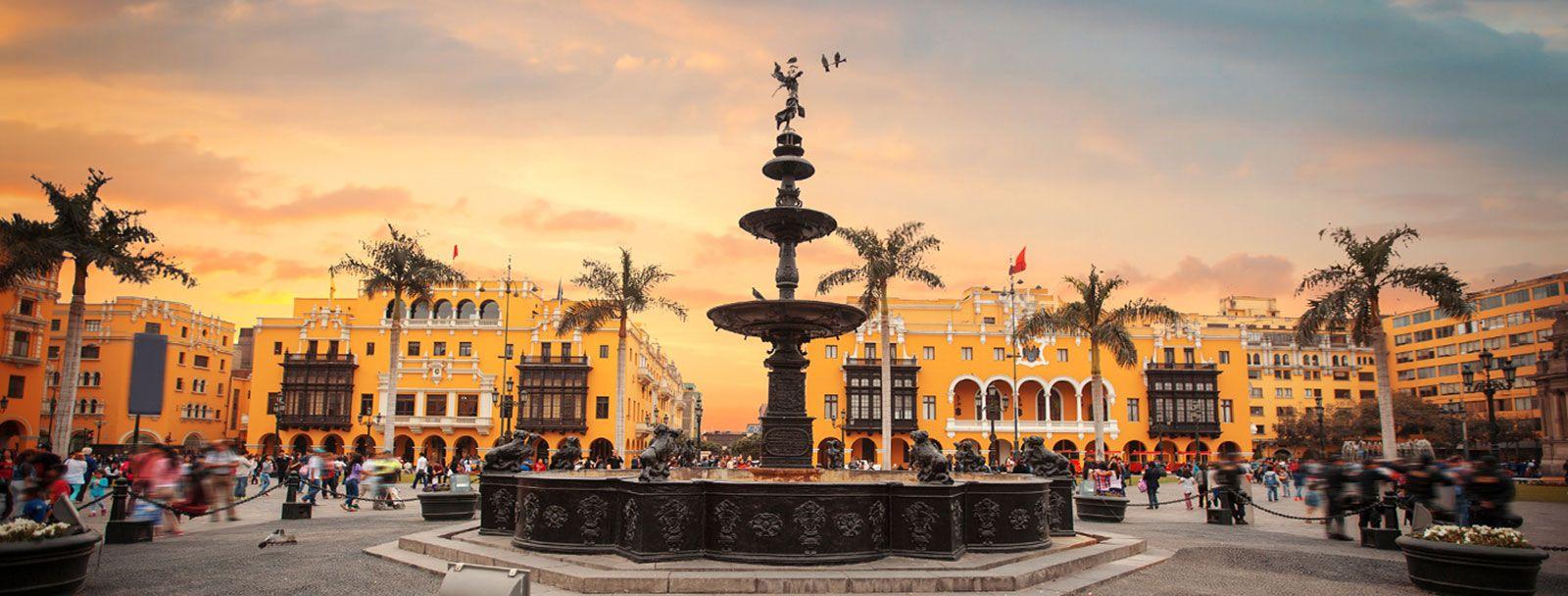
As the international gateway to Peru, Lima is an unavoidable stop for travelers planning a trip to Machu Picchu. But there are reasons to stick around. Spend a day or two here to experience the electrifying mix of old and new; meet Peruvians from every corner of the country and with ancestry from all over the world; and work your way through a long list of must-eats including ceviche, lomo saltado, causa rellena and more.
In Lima, you can choose to relax in the cosmopolitan atmosphere of the capital city or pack your itinerary full of visits to historic plazas and churches, 1,000-year-old adobe ruins, world-class restaurants, buzzing nightlife spots, ocean-view parks, and renowned museums and galleries. The capital city is a melting pot, with a long history of migration from other parts of the world, including Asia, Europe, and Africa. Add to that recent internal migration from the Andes, Amazon and coastal regions, and the result is a fantastic mix of vibrant backgrounds and cultures.
Climate & Weather
Lima has two clearly-marked seasons, summer and winter, with transitional periods in between. Being in the southern hemisphere, Lima has warmer, sunnier weather in the northern hemisphere’s winter months (December to March), and cooler, greyer weather in the northern hemisphere’s summer months (June to September).
- January to March
- Sunny, warm, humid days and spectacular sunsets
- Temperatures: 81-85°F (28-29°C) during the day, 66-70°F (19-21°C) at night
- June to October
- Cloudy, damp, chilly days with a light drizzle
- Temperatures: 62-65°F (17-18°C) during the day, 53-59°F (12-15°C) at night
There are quite a few factors that influence Lima’s weather. Peru is close to the equator, but the cold water Humboldt Current flows up from Antarctica and interacts with air temperatures to keep things cool.
The Andes Mountains are a second factor affecting the climate. The tall peaks, which begin to rise not too far from the coast, create a rain shadow effect that prevents rain clouds from forming. This geography explains why much of Peru’s coast is desert. In Lima, the result is a temperate climate with high humidity around the year.
During the winter months, a constant gray fog called garúa covers the city of Lima. Travel some miles north or south of the city or up into the foothills and you’ll experience the sunny skies that typify the rest of coastal Peru.
Best Time to Visit
It is best to visit Lima during its summer season, between December and April. Lima in the summer is sunny, and with temperatures in the 70s and 80s (roughly 21°C to 30°C), you can visit the parks, beaches, and historic districts with ease - and fully enjoy a refreshing, citrusy ceviche lunch. This is a great time to experience summer from the southern hemisphere, and perhaps even escape the cold weather of your home city in the northern hemisphere.
The transitional months between summer and winter, May and November, can also be a nice time to visit, as the weather can be more moderate with a mix of cooler, cloudy days and warmer, clear days.
Geography & Map
- Situated on the desert coast of Peru, the city of Lima occupies an oasis-like valley. The Pacific Ocean is to the west and the foothills of the Andes to the east. Sandy 200-foot-tall cliffs separate the Pacific shore from the westernmost edge of Lima city.
- Elevation 0 to 500 ft (0 to 150 m) Population ~ 10,555,000
Francisco Pizarro founded the city of Lima in 1535, but indigenous populations settled the area around it for thousands of years before the arrival of Spanish conquerors. Peru’s earliest human settlements found hospitable ground in the fertile soils of the river valleys within the present-day department of Lima. Along the Río Chillón, not far from Lima city, archaeologists have excavated stone tools dating from approximately 7500 BC.
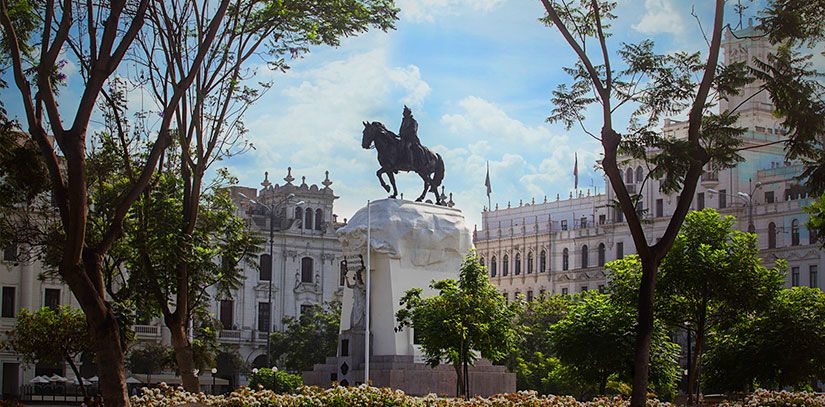
Around 1535, Spanish settlement began in Lima. After the fall of Cusco, conquistador Francisco Pizarro established a new city with a central plaza and church. In 1542, the Viceroyalty of Peru was created, but not officially recognized until Viceroy Francisco de Toledo arrived in 1572. South America’s struggle for independence from the Spanish Crown began in the early 1800s. In July 1821, Argentina’s General Jose San Martin sailed into the capital and declared the independence of Peru on July 28th, 1821.
The 1890s-1920s were a period of great urban renewal and expansion for Lima, from which point the population continued to grow exponentially. The 1990s marked a time of notable instability in Peru. Alberto Fujimori was elected president, partly in response to a rise of violent guerrilla movements and economic turbulence. Fujimori maintained power for ten years until he was forced to resign in a bribery scandal in 2000.
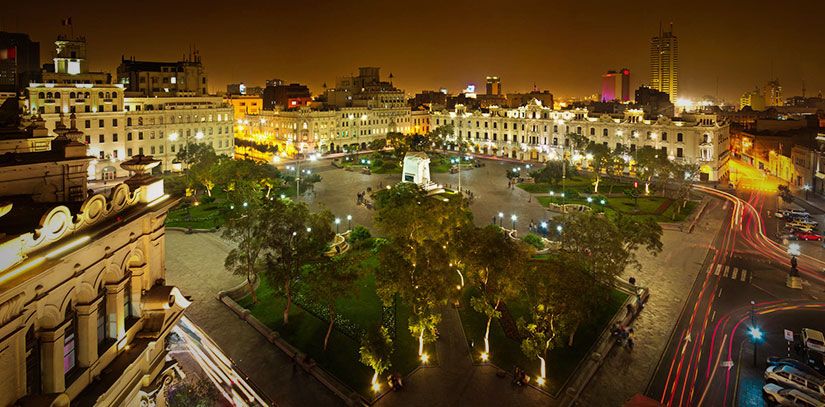
In the 21st century, Lima is enjoying a prolonged period of political and economic stability. In 2017, Lima’s metropolitan population was estimated at 10 million residents, representing about one-fourth of Peru’s total population. Today, the main tourist districts are Miraflores, Barranco and San Isidro, all of which hug the coast and are bursting with parks, historic sites, boutiques, world-class restaurants and premier hotels.
City Districts
Historic Center of Lima
Alongside Arequipa and Cusco, the historic Lima center presents the best preserved example of Peruvian colonial architecture and urban planning. Officially founded in 1535, Lima quickly grew to become the wealthiest city in the Americas. Today, the historic core forms just a small section of a sprawling city, but remains the best place to trace the evolution of Peru’s biggest city back to its beginnings. A visit to the historic center is highlighted by gorgeous colonial churches, government palaces, museums, historic houses and the scenic Plaza de Armas.
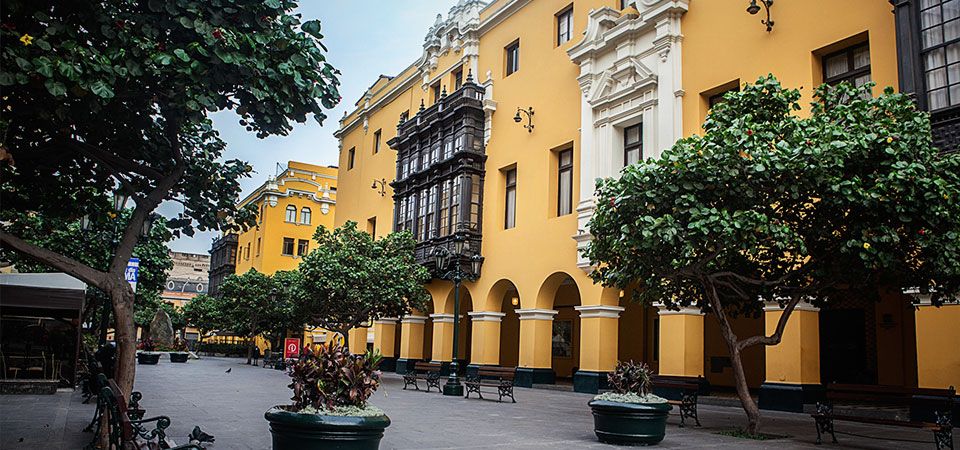
If the Lima historic center represents the city’s past, Miraflores embodies its vibrant present and ever-evolving future. Home to the must-sees Parque Kennedy and the coastal Malecon, as well as an endless number and variety of cafes, restaurants, bars, nightclubs and hotels for all budgets, it’s no surprise that Miraflores is a favorite destination for visitors to Lima.
Lima takes a bohemian turn in the seaside community of Barranco, a longtime hub for Peru’s artists and intellectuals. With its tree-shaded streets, colorful wall murals, graceful colonial homes and a few galleries, Barranco presents yet another side of Lima you won’t want to miss. Spend a relaxing afternoon at a cafe or restaurant by the Puente de los Suspiros, walk down the Bajada de Baños to check out the beach, or dance the night away with Lima locals at a live music bar.
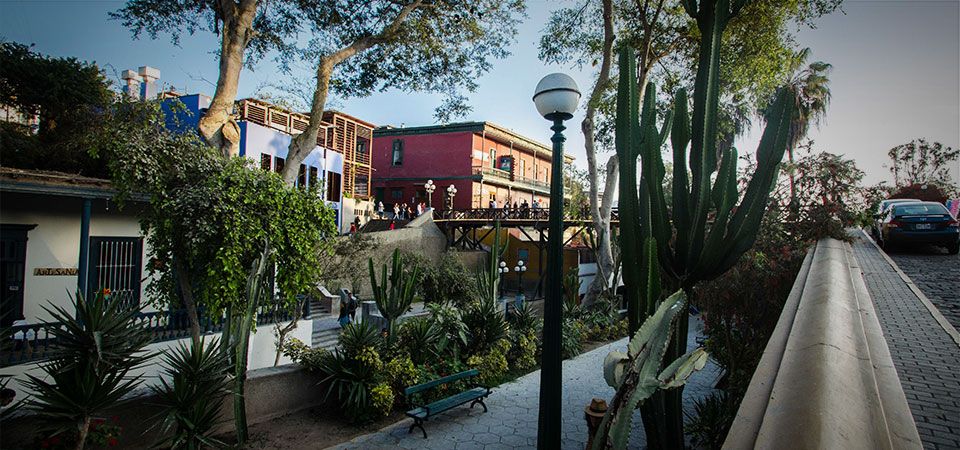
Financial district, upscale residential neighborhood, and home to a surprising array of bars and restaurants, San Isidro presents Lima’s most refined and elegant side. Spend a few nights in pampered comfort at the Westin (and check out their incredibly tranquil Heavenly Spa) or take some breaths of fresh air at the enchanting Parque El Olivar, a vast olive grove with more than 1,700 trees.
Things to Do
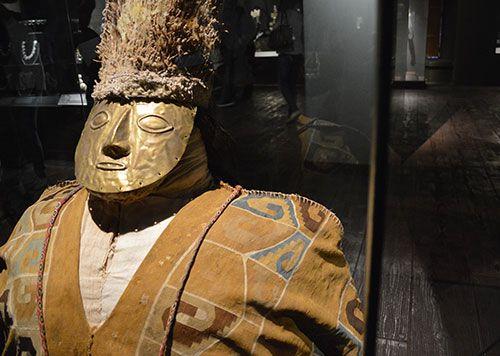
Lima Museums
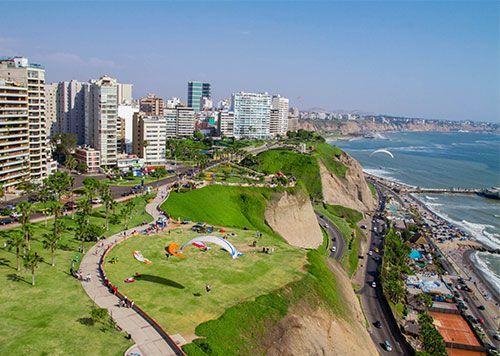
Lima Parks and Plazas
In South America, parks and plazas are social spaces where people gather to rest, chat, read, snack, and spend time with family and friends. Whatever Lima district you find yourself in, make time to see the main park or plaza and get a glimpse of local life. One must-see park is Parque Kennedy in the heart of Miraflores, and a must-see Plaza is the Plaza de Armas of Lima in the historic center.
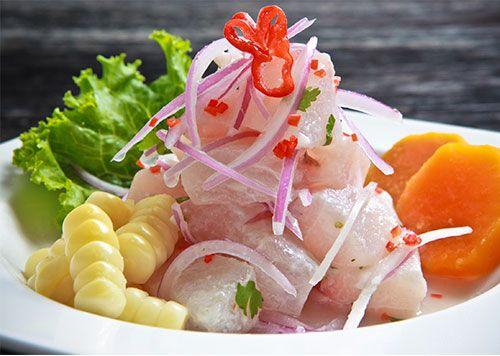
Sample the Cuisine
If you travel for the food, you’ll be delighted with Lima’s exceptional dining scene. Peru is in the midst of a gastronomic boom and the capital city is its epicenter, filled with an endless variety of delectable cuisine. Some key dishes to try include ceviche , lomo saltado and causa a la limena. Don’t forget to pair with the national drink, the pisco sour , and sweeten the deal with picarones (Peruvian drip doughnuts) or suspiro de la limena (caramel custard with a port meringue).
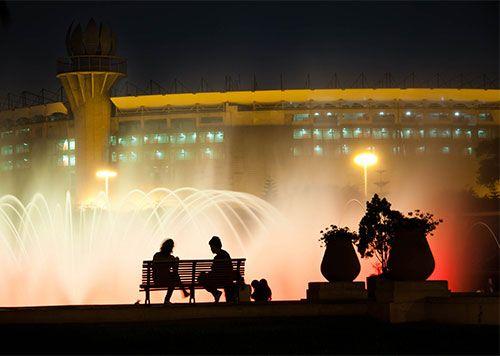
Circuito Magico del Agua
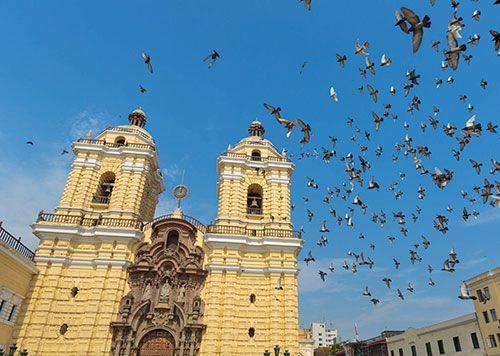
San Francisco Convent and Catacombs
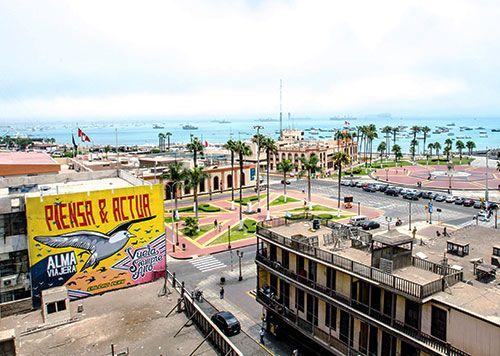
Port of Callao
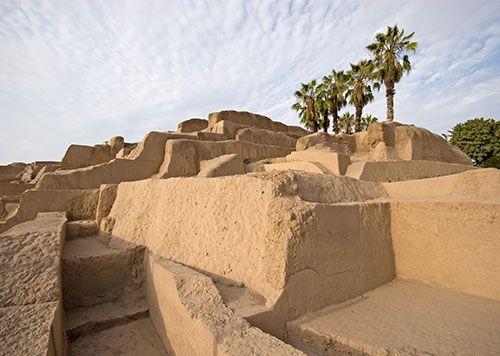
Visit Archaeological Sites
Peru’s most modern and dynamic city is also home to some of South America’s most ancient relics. Witness this contrast with a visit to Huaca Pucllana , the 4th-century adobe temple surrounded by Miraflores’ high-rises. Yet more temple ruins are scattered through Pueblo Libre and San Miguel districts. Eighteen miles outside of Lima, Pachacamac temple has been an important complex for millennia.
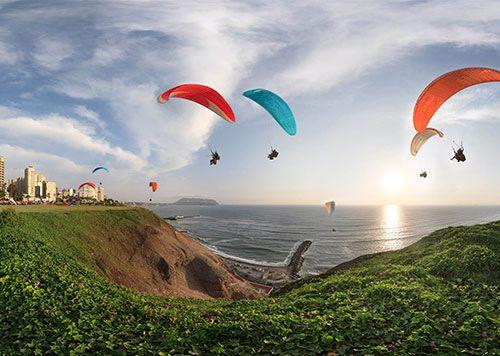
Stroll the Seaside Promenade
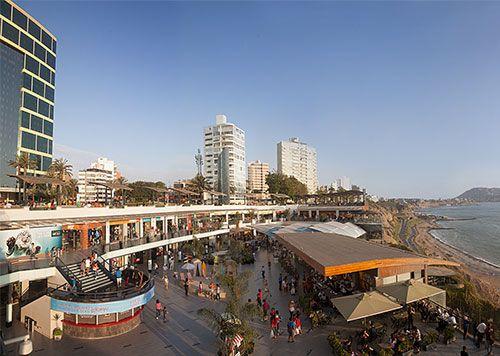
Along the coastal malecon you find the immaculate outdoor mall that is Larcomar . The open air shopping experience with Pacific views is an excellent way to spend part of your afternoon. With 16 restaurants and cafes, and a variety of boutiques, this is a must-see while in Miraflores.
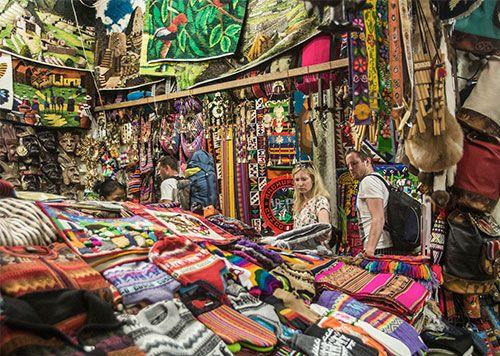
Artisan Markets
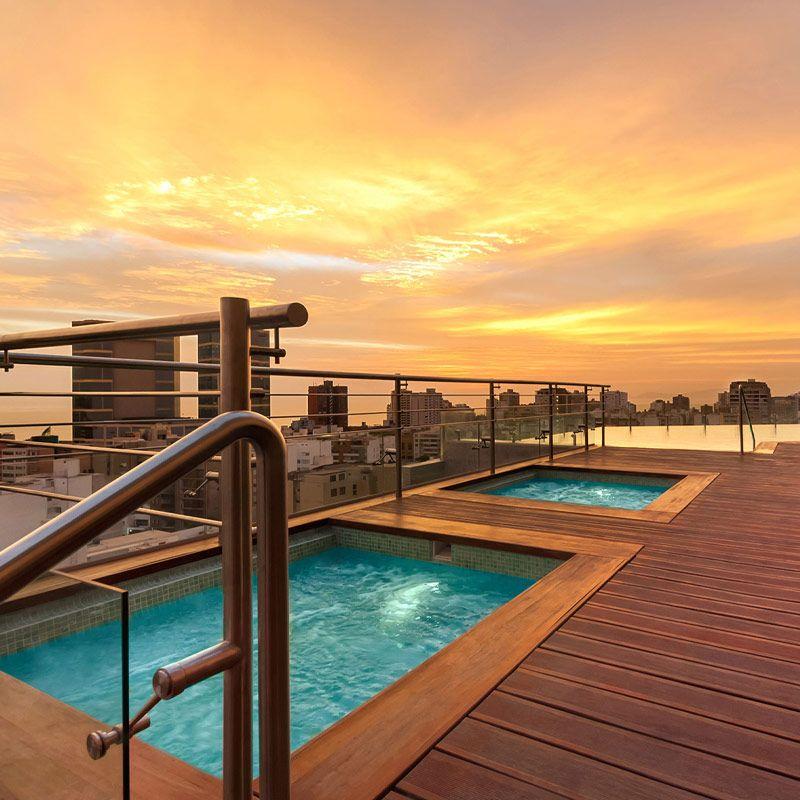
Hilton Lima Miraflores
Avenida La Paz 1099, Miraflores, Lima
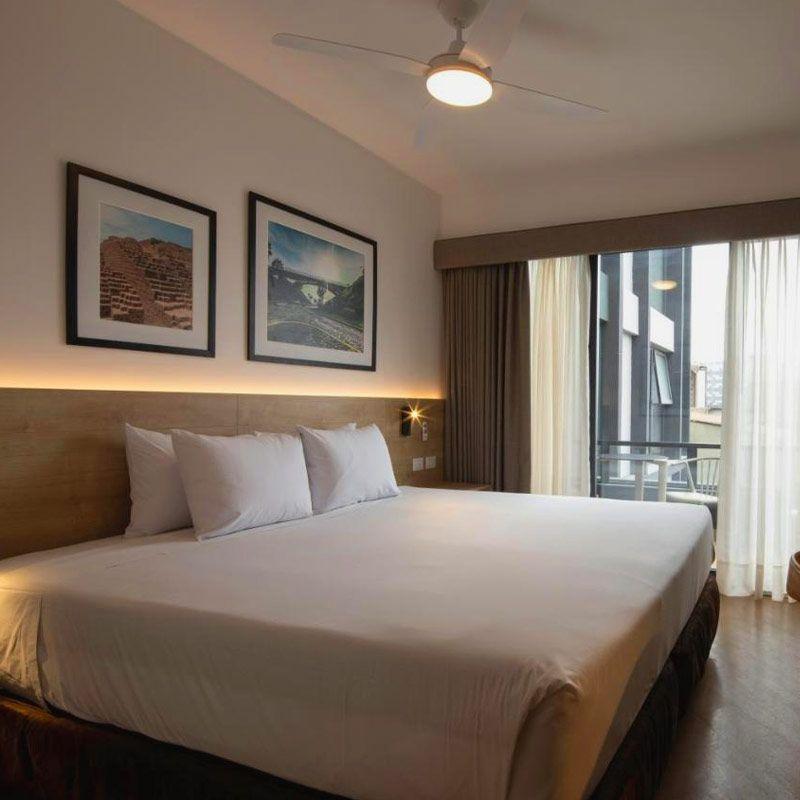
Casa Andina Standard Benavides Hotel
Av. Alfredo Benavides 271, Miraflores, Lima
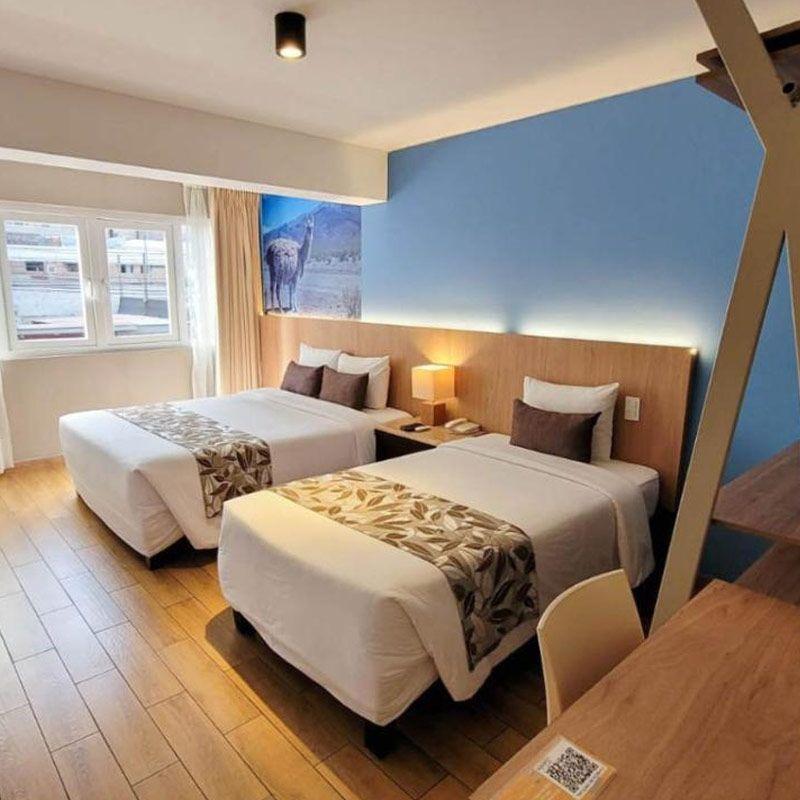
Tambo 2 Hotel
Av. La Paz 720, Miraflores, Lima
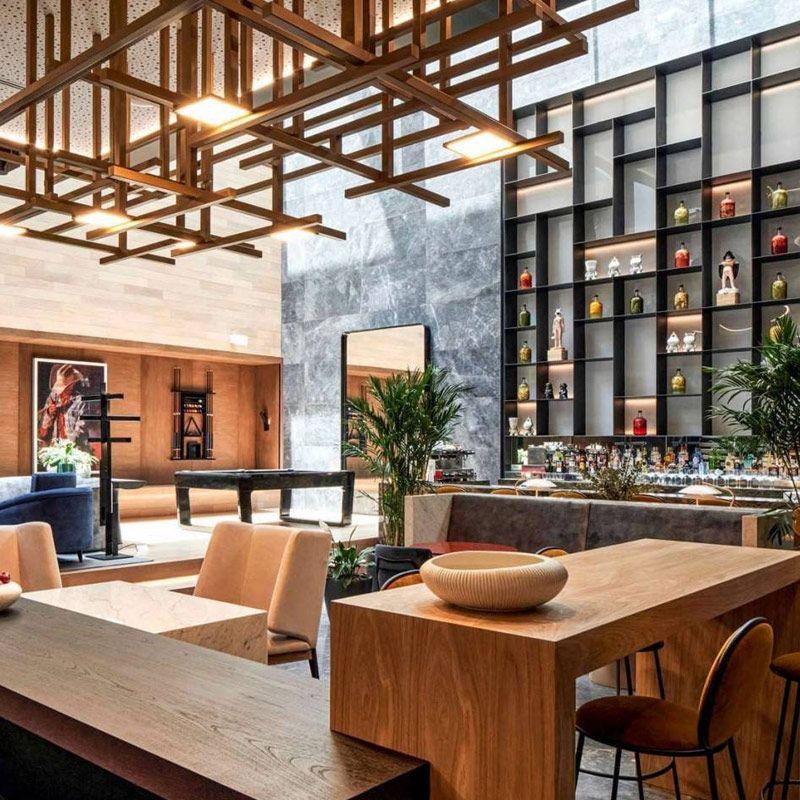
Pullman Miraflores
Calle Juan Fanning 515 - 525, Miraflores, Lima
From establishments owned by award-winning chefs, top plates from around Peru, and luxurious to casual ambiances, there are a lot of excellent restaurant choices in Lima. The selection of delicious dining options are truly endless and ever-changing. Browse a handful of highly-recommended restaurants below. You might want to make a reservation in advance as these are popular spots:
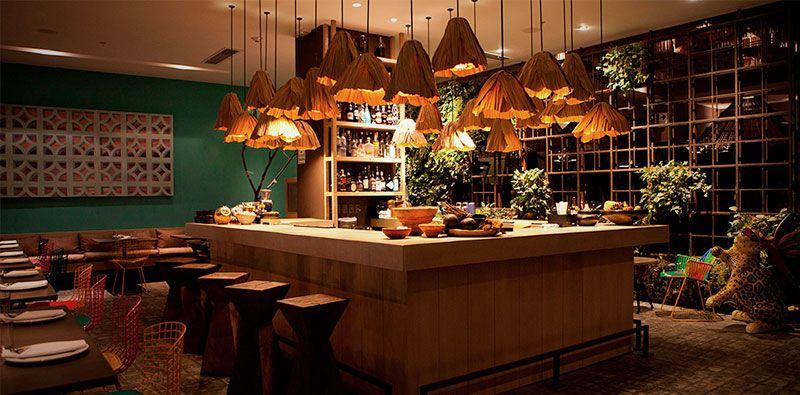
Astrid & Gaston
Cultural events.
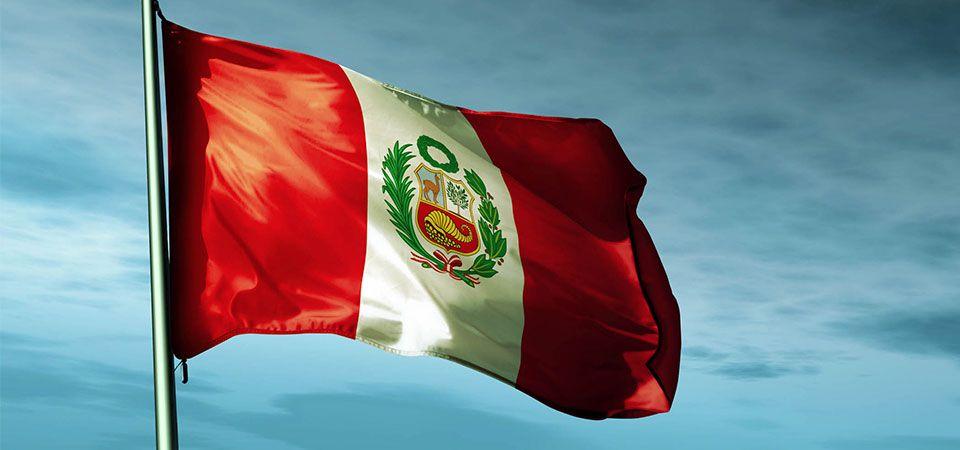
Tour Packages
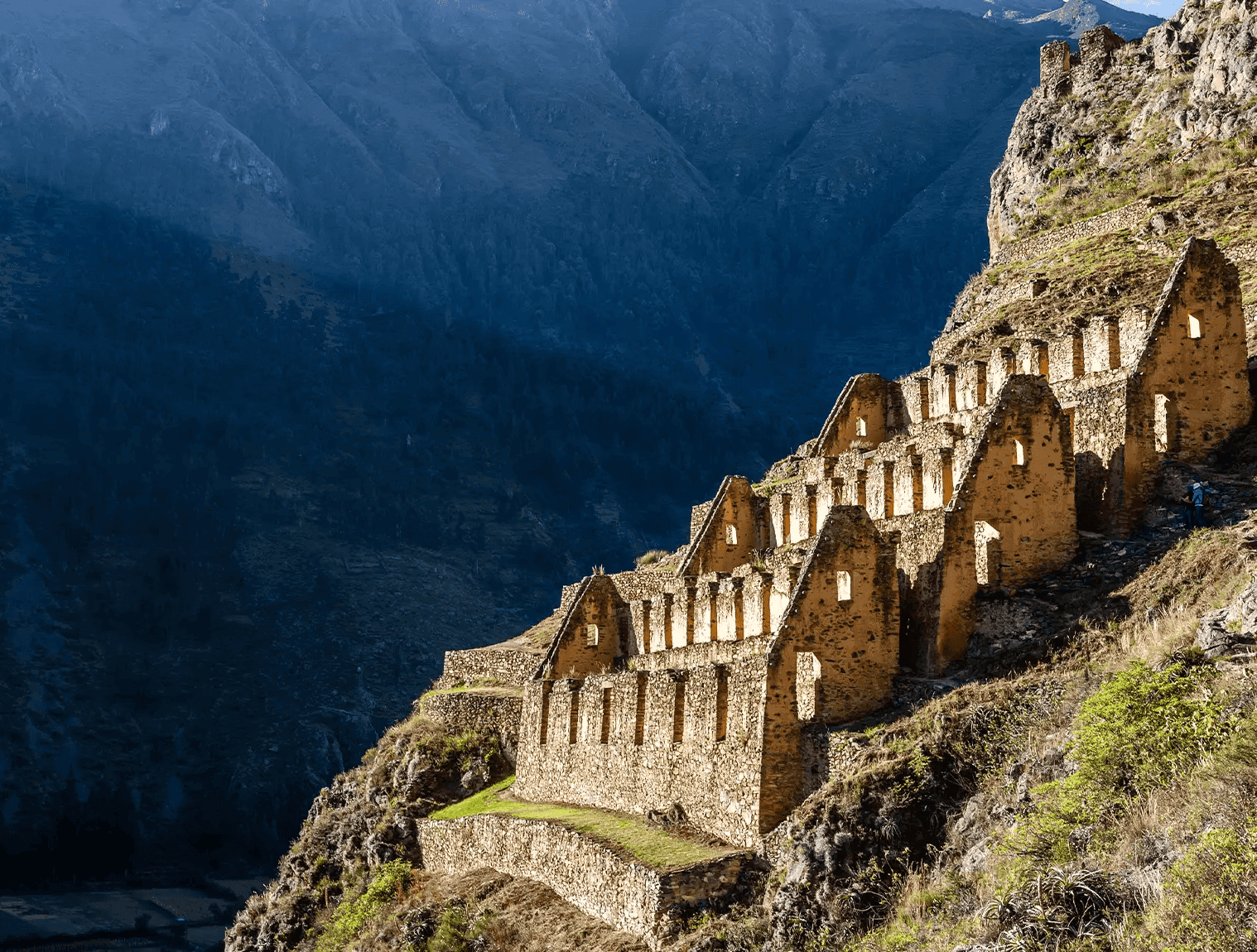
16 days from $ 3869
Machu Picchu, Cusco, Titicaca, Amazon, Lima, Paracas, Arequipa & Colca
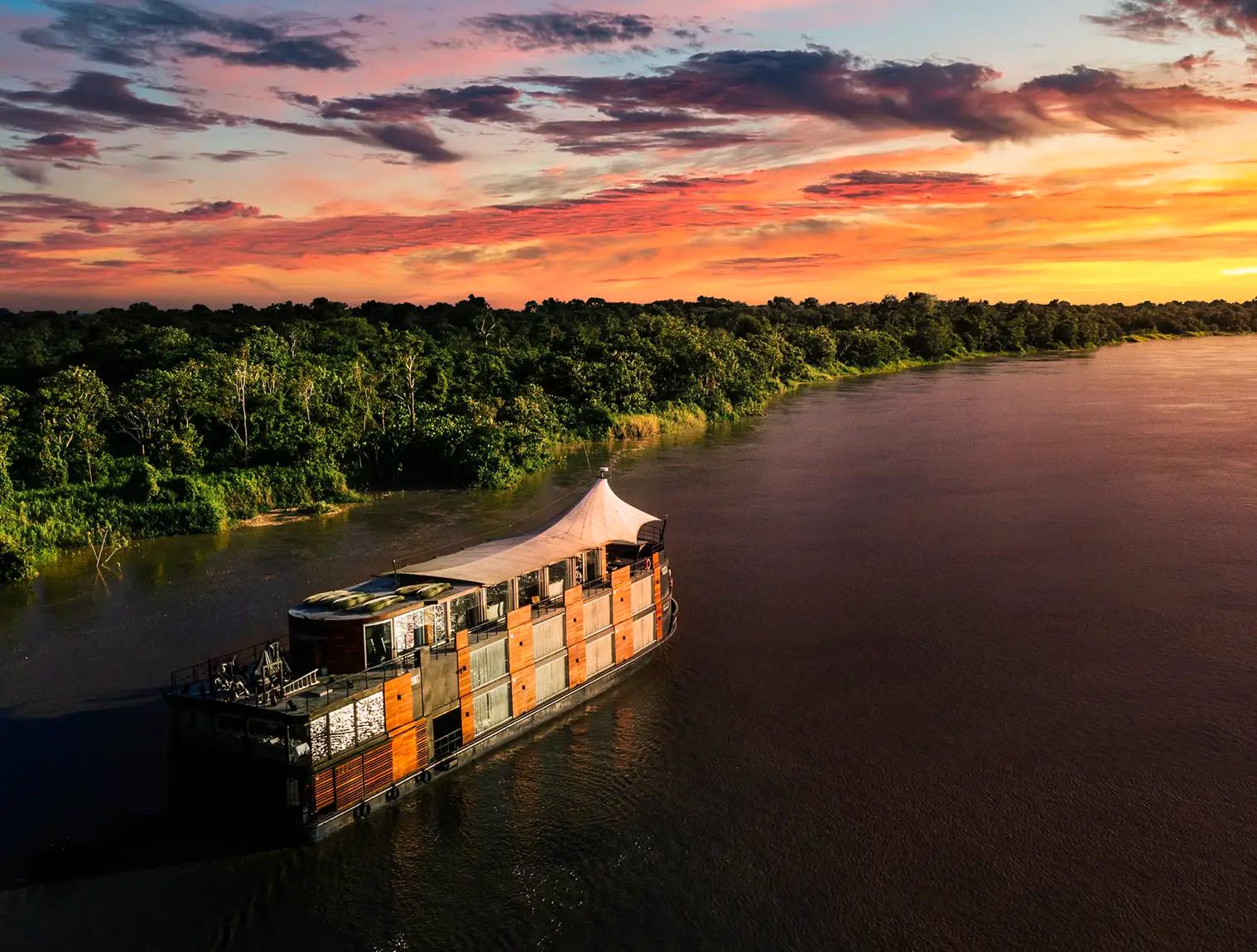
9 days from $ 3649
Cusco, Sacred Valley, Machu Picchu, Lima & Amazon Cruise
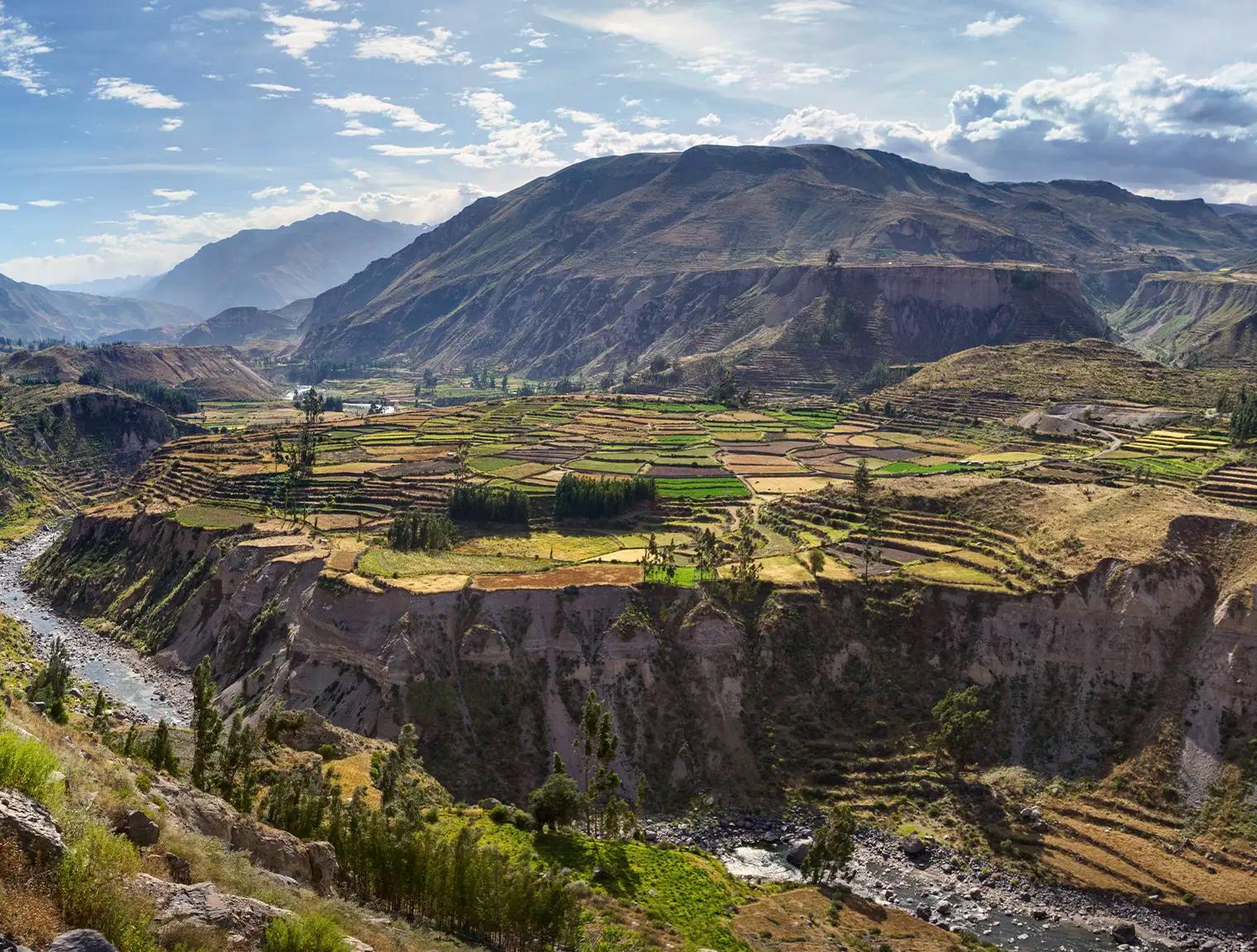
11 days from $ 2769
Machu Picchu, Cusco, Lima, , Paracas, Arequipa & Colca Canyon

Book With Confidence
We're flexible! Postpone your tour with zero cost up to 10 days prior to departure.
Email: [email protected]
Sign up to receive our newsletter for great articles, stunning photos, and special deals.
1-817-230-4971
Sales & travel support
- Skip to main content
- Skip to "About this site"
Language selection
Search travel.gc.ca.
Help us to improve our website. Take our survey !
COVID-19: travel health notice for all travellers
Peru travel advice
Latest updates: Entry and exit requirements – updated information on entry restrictions at land and river borders with Ecuador
Last updated: May 17, 2024 11:12 ET
On this page
Safety and security, entry and exit requirements, laws and culture, natural disasters and climate, peru - exercise a high degree of caution.
Exercise a high degree of caution in Peru due to high levels of crime, as well as social conflicts and strikes that may occur across the country.
Regional advisory - Avoid non-essential travel
- Huallaga and Tocache provinces in the department of San Martín
- the Upper Huallaga and Ene river valleys in the departments of Huánuco and San Martín
- Padre Abad province in the department of Ucayali
- Huacaybamba, Humalíes, Leoncio Prado and Marañón provinces in the department of Huánuco
- Concepción and Satipo provinces in the department of Junín
- Tayacaja province in the department of Huancavelica
- the districts of Abancay, Andahuaylas and Chincheros in the department of Apurímac
- Huanta and La Mar provinces, in the department of Ayacucho
- Valley of Apurimac, Ene and Mantaro rivers (VRAEM)
Border area with Colombia - Avoid non-essential travel
Avoid non-essential travel to areas within 20 km of the border with Colombia due to drug trafficking and occasional incursions by armed guerrilla forces from Colombia into Peru.
Border area with Ecuador - Avoid non-essential travel
Avoid non-essential travel to areas within 20 km of the border with Ecuador, especially in the Cordillera del Cóndor region, due to the safety threat posed by landmines.
Back to top
State of emergency in regions bordering Ecuador
On January 10, 2024, the Peruvian government declared a state of emergency in the northern regions bordering Ecuador following the Government of Ecuador’s declaration of a nationwide state of “internal armed conflict” on January 9, 2024. The state of emergency is in effect in the following regions:
If you are in these regions, you should carry identification with you at all times.
Demonstrations and strikes
Demonstrations and strikes take place regularly throughout the country. Strikes can complicate travel and disrupt public transport and services, including your ability to travel to or leave isolated tourist destinations such as Machu Picchu. They could also lead to border closures with Bolivia. Protestors may also block rivers essential for transportation in some remote regions, including the Manu region of Madre de Dios and Iquitos region. This may result in the temporary detainment of tourists.
Even peaceful demonstrations can turn violent at any time. Police have used tear gas and other methods to disperse crowds in the past. Authorities often declare a state of emergency in response to demonstrations.
Peruvian law prohibits political activities by foreigners. You may face detention or deportation if you take part in a demonstration.
- Avoid areas where demonstrations and large gatherings are taking place
- Follow the instructions of local authorities
- Consult local media to be aware of strikes and demonstrations that may affect your stay or travel plans
Mass gatherings (large-scale events)
State of Emergency
The Peruvian government periodically declares a state of emergency in certain areas to allow the military to assist police forces to respond to security incidents and natural disasters. When a state of emergency is in effect, security forces have increased rights to:
- restrict freedom of movement
- monitor correspondence
- conduct search and seizures
- detain persons of interest
Border area with Colombia
Criminal activity related to narcotics trafficking and occasional incursions by armed guerrilla forces from Colombia at Cordillera del Cóndor, Peru, pose a threat to personal security.
Border area with Ecuador
Cross the Peru–Ecuador border at official crossing points only due to the presence of landmines along the border.
Basic services in the Tumbes district have become increasingly difficult to access due to an increased number of migrants entering Peru from the North land border with Ecuador. The increased population has limited the provision of these services.
Valle de los Ríos Apurímac, Ene y Mantaro (VRAEM)
Drug trafficking.
Cocaine production and trafficking occurs inVRAEM. Travel is particularly dangerous in areas where there is coca cultivation and processing.
Domestic terrorism
Incidents of domestic terrorism have occurred in VRAEM, particularly the region where the Apurímac, Ayacucho, Cuzco and Junín departments meet.
Crime rates are high throughout the country.
- Maintain a high level of vigilance and personal security awareness, especially at night
- Avoid walking in deserted or under-populated areas
- Travel in groups whenever possible
Petty crime
Petty crime, such as pickpocketing and purse snatching, occurs, particularly in Lima, in other cities and even in crowded, public areas. Theft occurs frequently in hotels, restaurants, bus stations and airports, on intercity buses and microbuses and while hailing taxis.
- Avoid wearing expensive watches and jewellery, or showing signs of affluence
- Ensure that your belongings, including your passport and other travel documents, are secure at all times
- Never leave bags unattended
Pickpockets and bag snatchers may work in pairs or groups and employ a variety of ruses to divert their victim’s attention. A common scam involves spraying a substance on victims and then robbing them while pretending to help clean the stain, or distracting the victim by asking questions while another person perpetrates the theft. In some cases, thieves on motorcycles will snatch purses, backpacks or cellular phones.
Violent crime
Violent crime occurs. Incidents have included:
- kidnappings
Armed robbery
Armed robberies are on the rise. While most victims are not physically injured, criminals will not hesitate to use force when opposed.
- If you are robbed, hand over your cash, electronic devices and valuables without resistance
- Be particularly vigilant after visiting a bank, an ATM or a change bureau, as thieves may follow and rob victims.
- Use ATMs inside banks and during regular hours of service, when guards are on duty
Assaults have occurred along the Inca Trail and in the Huaraz region of the Cordillera Blanca mountains. Hiking in these regions should be done in groups.
Express kidnappings involving tourists have occurred. Victims are usually abducted for a few hours and forced to withdraw money from ATMs for their release. Most express kidnappings take place at night, but incidents also occur during daylight hours. Incidents often involve criminals posing as taxi drivers, or taxi drivers working for organized gangs. Virtual kidnappings occur throughout the country. Criminals use stolen cellphones to contact family members claiming to have kidnapped the owner of the phone and then ask for ransom money.
- Be suspicious of strangers approaching you on the street
- Never leave your cellphone unattended
- Be cautious when using cellphones and smart devices in public as they are often targeted by thieves, especially while people are using them
- Ensure your phone is password protected
Organized crime
Organized crime is reportedly increasing in parts of Lima Province and in some districts of the Department of Piura. In some parts of the country, military and security forces have been deployed to assist police in combatting organized crime.
Incidents of domestic terrorism occur, particularly in remote jungle areas such as:
- parts of the Huancavelica and Ucayali departments
- the Upper Huallaga river valley in the Huánuco and San Martín departments.
Incidents have included:
- temporary ambushes of small villages
- bombings or threats of violence against local security forces or community figures
Overland travel in these regions is unsafe.
Counterfeit currency
Counterfeit currency in both sol and U.S. dollars is a growing and serious problem. Counterfeit bills are widely distributed, including by banks, casinos and local stores.
Avoid moneychangers on the street, as they may carry counterfeit currency or work with pickpockets.
Credit card fraud
Credit card and ATM fraud occurs. Be cautious when using debit or credit cards:
- pay careful attention when your cards are being handled by others
- use ATMs located in well-lit public areas or inside a bank or business
- avoid using card readers with an irregular or unusual feature
- cover the keypad with one hand when entering your PIN
- check for any unauthorized transactions on your account statements
Criminals posing as taxi drivers often rob tourists along the route to and from Lima’s Jorge Chávez International Airport.
- Use a secure taxi service when arriving at and leaving the airport
- Exercise caution en route to and from your hotel
Thieves also pose as police officers to gain the confidence and cooperation of their potential victims.
- If you are stopped by local authorities, ask to see official identification and record the officer’s name, badge number and district.
- For traffic violations, request that the officer issue you a fine in writing, which is payable at a later date.
- You should also note the location of the arrest.
Legitimate police officers have also extorted money in exchange for dismissing minor offences or traffic violations. They have also stolen money and valuables during searches.
- If you are searched, even at the airport, ensure you have all your belongings before leaving
- If you are planning to participate in volunteer activities in Peru, ensure that the company organizing your trip is legitimate
- Make sure your accommodations and return arrangements are secure before travelling
Useful links
- Lima Airport Partners
- Overseas fraud
- Volunteering abroad
Spiked food and drinks
Snacks, beverages, gum and cigarettes may contain drugs that could put you at risk of sexual assault and robbery.
- Be wary of accepting these items from new acquaintances
- Never leave food or drinks unattended or in the care of strangers
Women’s safety
Women travelling alone may be subject to some forms of harassment and verbal abuse. Incidents of sexual assault, including rape, occur throughout the country, particularly in tourist destinations. In some cases, tour guides have been implicated.
- Do not travel alone, especially after dark.
- Remain particularly vigilant at bus terminals and in taxis.
- Be careful when dealing with strangers or recent acquaintances, especially regarding the acceptance of rides or other invitations.
Women reporting sexual assault should contact police immediately. Medical examinations at identified clinics are part of the investigation process. Women who have delayed reporting may experience more scrutiny by local authorities.
Advice for women travellers
Adventure tourism
Each year, several hikers and climbers are victims of serious, sometimes fatal, accidents in the Andes, including at the Huayna Picchu peak near Machu Picchu and the Cordillera Blanca region in Huaraz, where Peru’s highest peaks are located.
The Inca Trail is usually closed each year in February for maintenance. Other trails, such as those found in Ollantaytambo, may be poorly marked. Hikers have become lost. Be aware that steep or slippery areas are neither fenced nor marked.
In November 2023, the Cusipata District in Quispicanchi Province closed two access routes to Vinicunca, the “Rainbow Mountain.” The closure follows violent disputes between the municipalities surrounding the access routes. Access to Vinicunca from Quispicanchi Province will be closed indefinitely, but access remains open via the Pitumarca District in Canchis Province.
Remote areas of Peru, where popular jungle excursions operate, may not have cellphone coverage or internet access.
If you intend to hike, trek or climb:
- never do so alone, and always hire an experienced guide from a reputable company
- only use licensed companies recommended by the Ministry of Tourism for adventure tours and sports
- exercise extreme caution while climbing, as local authorities have limited rescue capabilities
- buy travel insurance that includes helicopter rescue and medical evacuation
- ensure that your physical condition is good enough to meet the challenges of your activity
- make sure that you’re properly equipped and well-informed about weather and other conditions that may pose a hazard
- inform a family member or friend of your itinerary, including when you expect to be back to camp
- know the symptoms of acute altitude sickness, which can be fatal
- obtain detailed information on trekking routes or ski slopes before setting out and do not venture off marked trails or slopes
- always leave the contact information of the tour operator with your family and friends
- always hire an experienced guide from a reputable company if you travel in remote areas
- iPerú - Peruvian government’s Tourist Information and Assistance
- APOTUR - The Peruvian Association of Incoming and Domestic Tour Operators (in Spanish)
- APAVIT - Peruvian Association of Travel and Tourist Agencies (in Spanish)
- APTAE - Peruvian association of adventure, eco, and specialized tourism (in Spanish)
- Qualified Tourism Service Companies - Ministry of foreign trade and tourism (in Spanish)
Water activities
There have been several recent white-water rafting accidents and drownings involving tourists, particularly on the Urubamba River near Cuzco. Companies offering white-water rafting, their guides and their equipment may not be held to the same standards as similar companies in Canada. Rescue services may not be consistent with international standards.
Coastal waters can be dangerous. Strong currents exist in the Pacific Ocean and in rivers. Life guards are not always present or properly trained at beaches.
Swimming in jungle lakes and rivers can be dangerous due to the presence of parasites and wildlife.
Seek advice and consult residents and local authorities about conditions before swimming, surfing or participating in other aquatic activities.
Water safety abroad
Ayahuasca ceremonies
Spiritual cleansing and ayahuasca ceremonies, offered by shamans and other individuals, involve consuming substances that can cause medical complications and severely impair cognitive and physical abilities. Exposure to these substances has led to serious illness, injury, assault and even the death of several tourists.
Ceremonies often take place in remote areas with no access to medical or mental health facilities or resources and limited communication with local authorities. Most of the time, the facilities lack basic first aid or emergency plans for those suffering from physical or psychological illness from these ceremonies. Ayahuasca ceremonies are not regulated and there is no way to assess the safety of any of the services, the operators or the shamans.
Road safety
Road conditions and road safety are poor throughout the country. Drivers are extremely aggressive, and they do not respect traffic laws. Mountainous roads can be particularly dangerous, especially at night. Poor signage also poses a hazard. Accidents causing fatalities are common.
Regular police spot checks can cause traffic delays.
When renting a vehicle, always purchase insurance. Most drivers in Peru have only the minimum required car insurance, which may not adequately cover accidents.
Vehicles are a target for robbery. Criminals have thrown objects in front of oncoming traffic in the hope that cars will stop. If this occurs and you need to stop, do so only in a safe location, such as a gas station.
- While travelling by car, keep your doors locked and windows shut at all times
- Keep your personal belongings in the trunk of the vehicle, as criminals have been known to shatter windows to “smash and grab” and to attempt entry when they see travel bags or merchandise
- Avoid travelling by road outside of major cities after dark, when there is a higher risk of robbery
State of the roads in Peru in real time – Government of Peru (in Spanish)
Thefts on boats by river pirates occur along rivers in the Amazon jungle.
Mariners should take appropriate precautions.
Live piracy report - International Maritime Bureau
Public transportation
Buses and minibuses operate between most major cities. Demonstrations and strikes can lead to disruptions to traffic and public transportation.
Many of the buses and combis in Lima are old, poorly maintained and overcrowded. Drivers of these vehicles tend to dominate the roads and disregard other drivers or pedestrians.
Intercity bus travel can be dangerous due to the risk of bus accidents, which are usually caused by excessive speed, poor vehicle maintenance and driver fatigue. Armed gangs have been known to stop buses to rob travellers, especially at night. Incidents of assaults on buses have also been reported.
The Government of Peru publishes a list of the bus companies with the highest rates of involvement in fatal or serious injury traffic accidents.
- Only use reputable transportation companies
- Contact your travel agency for a list of recommended intercity bus companies
Ministry of Transportation - Government of Peru (in Spanish)
Trains operate between Arequipa-Cusco-Puno and between Cusco-Ollantaytambo-Machu Picchu . Demonstrations, strikes and derailments can disrupt travel by train, including trains to or from Machu Picchu.
- Train services – Peru rail
- Train to Machu Picchu - Inca rail
Licensed taxis are not metered. Taxi drivers sometimes do not provide change or will continue to drive until they can obtain change.
- Do not hail taxis on the street
- Reserve a taxi by calling a reputable taxi company or use taxi services associated with major hotels
- Agree to a fare prior to departure and do not pay until you have reached your destination
- Try to carry the exact fare
We do not make assessments on the compliance of foreign domestic airlines with international safety standards.
Information about foreign domestic airlines
entry_restrictions_at_land_and_river_borders_with_ecuador
Entry restrictions at land and river borders with Ecuador
On January 11, 2024, the Government of Ecuador announced new entry restrictions in response to the ongoing state of internal armed conflict.
All foreigners entering Ecuador at crossing points with the land or river borders must present a criminal record check from their country of origin or residence. Both the original criminal record check and the Spanish translation must be apostilled and cover the past five years. Minors travelling with their family members will generally be exempt.
If you cannot provide a criminal record check, you must request an exceptional entry authorization 48 hours before entering Ecuador and send the required information to the Ministry of Tourism.
- Entry Requirements to Ecuador through land borders – Ministry of tourism (in Spanish)
- Migration information – Ecuador Immigration Agency (in Spanish)
- Changes to authentication services in Canada
- Authentication of documents
Every country or territory decides who can enter or exit through its borders. The Government of Canada cannot intervene on your behalf if you do not meet your destination’s entry or exit requirements.
We have obtained the information on this page from the Peruvian authorities. It can, however, change at any time.
Verify this information with the Foreign Representatives in Canada .
Entry requirements vary depending on the type of passport you use for travel.
Before you travel, check with your transportation company about passport requirements. Its rules on passport validity may be more stringent than the country’s entry rules.
Regular Canadian passport
Your passport must be valid for at least 6 months beyond the date you expect to leave Peru.
Passport for official travel
Different entry rules may apply.
Official travel
Passport with “X” gender identifier
While the Government of Canada issues passports with an “X” gender identifier, it cannot guarantee your entry or transit through other countries. You might face entry restrictions in countries that do not recognize the “X” gender identifier. Before you leave, check with the closest foreign representative for your destination.
Other travel documents
Different entry rules may apply when travelling with a temporary passport or an emergency travel document. Before you leave, check with the closest foreign representative for your destination.
- Foreign Representatives in Canada
- Canadian passports
Tourist visa: not required for a stay of less than 90 days per 365 day period Business visa: required Student visa: required
If you entered Peru with a business visa, you must obtain a certificate from the Peruvian Ministry of the Economy to prove that all Peruvian taxes on income earned during the trip have been paid prior to leaving the country. The certification is required even if no money was paid or earned and must be presented to the central Peruvian immigration office in Lima before departure.
Entering the country
You must register your entry into Peru at the port of entry or checkpoint.
- Only cross the border at official checkpoints
- Ensure the immigration office at your port of entry is open at the time you intend to cross the border
Other entry requirements
Customs officials may ask you to show them:
- a return or onward ticket
- proof that you have a place to stay
- proof that you have sufficient funds for the duration of your stay
Length of stay
As a Canadian tourist, you may stay in Peru for up to 90 days in a 365-day period.
Overstaying is a criminal offence. There is a fine for each day of overstay. This fee must be paid upon exiting the country.
Dual citizenship
Peruvian–Canadians entering Peru using their Canadian passport are subject to visit restrictions, including length of stay and associated fines. Dual nationals must use the same nationality to enter and exit the country.
Children and travel
Travellers under 18 exiting Peru after a stay of 183 days are automatically protected by Peru’s law on minors and will require the authorization of both parents/guardians to exit the country.
Children who have resident status in Peru must have written permission from the non-accompanying parents to leave the country.
Children born of Canadian parents in Peru require a Peruvian passport to leave the country for the first time. Contact Peruvian immigration officials for more information.
- Travelling with children
Yellow fever
Learn about potential entry requirements related to yellow fever (vaccines section).
Relevant Travel Health Notices
- Global Measles Notice - 13 March, 2024
- Zika virus: Advice for travellers - 31 August, 2023
- COVID-19 and International Travel - 13 March, 2024
- Dengue: Advice for travellers - 6 May, 2024
This section contains information on possible health risks and restrictions regularly found or ongoing in the destination. Follow this advice to lower your risk of becoming ill while travelling. Not all risks are listed below.
Consult a health care professional or visit a travel health clinic preferably 6 weeks before you travel to get personalized health advice and recommendations.
Routine vaccines
Be sure that your routine vaccinations , as per your province or territory , are up-to-date before travelling, regardless of your destination.
Some of these vaccinations include measles-mumps-rubella (MMR), diphtheria, tetanus, pertussis, polio, varicella (chickenpox), influenza and others.
Pre-travel vaccines and medications
You may be at risk for preventable diseases while travelling in this destination. Talk to a travel health professional about which medications or vaccines may be right for you, based on your destination and itinerary.
Yellow fever is a disease caused by a flavivirus from the bite of an infected mosquito.
Travellers get vaccinated either because it is required to enter a country or because it is recommended for their protection.
- There is a risk of yellow fever in this country.
Country Entry Requirement*
- Proof of vaccination is not required to enter this country.
Recommendation
- Vaccination is recommended depending on your itinerary.
- Contact a designated Yellow Fever Vaccination Centre well in advance of your trip to arrange for vaccination.
- Discuss travel plans, activities, and destinations with a health care professional.
- Protect yourself from mosquito bites.
About Yellow Fever Yellow Fever Vaccination Centres in Canada * It is important to note that country entry requirements may not reflect your risk of yellow fever at your destination. It is recommended that you contact the nearest diplomatic or consular office of the destination(s) you will be visiting to verify any additional entry requirements.
There is a risk of hepatitis A in this destination. It is a disease of the liver. People can get hepatitis A if they ingest contaminated food or water, eat foods prepared by an infectious person, or if they have close physical contact (such as oral-anal sex) with an infectious person, although casual contact among people does not spread the virus.
Practise safe food and water precautions and wash your hands often. Vaccination is recommended for all travellers to areas where hepatitis A is present.
Measles is a highly contagious viral disease. It can spread quickly from person to person by direct contact and through droplets in the air.
Anyone who is not protected against measles is at risk of being infected with it when travelling internationally.
Regardless of where you are going, talk to a health care professional before travelling to make sure you are fully protected against measles.
Hepatitis B is a risk in every destination. It is a viral liver disease that is easily transmitted from one person to another through exposure to blood and body fluids containing the hepatitis B virus. Travellers who may be exposed to blood or other bodily fluids (e.g., through sexual contact, medical treatment, sharing needles, tattooing, acupuncture or occupational exposure) are at higher risk of getting hepatitis B.
Hepatitis B vaccination is recommended for all travellers. Prevent hepatitis B infection by practicing safe sex, only using new and sterile drug equipment, and only getting tattoos and piercings in settings that follow public health regulations and standards.
Coronavirus disease (COVID-19) is an infectious viral disease. It can spread from person to person by direct contact and through droplets in the air.
It is recommended that all eligible travellers complete a COVID-19 vaccine series along with any additional recommended doses in Canada before travelling. Evidence shows that vaccines are very effective at preventing severe illness, hospitalization and death from COVID-19. While vaccination provides better protection against serious illness, you may still be at risk of infection from the virus that causes COVID-19. Anyone who has not completed a vaccine series is at increased risk of being infected with the virus that causes COVID-19 and is at greater risk for severe disease when travelling internationally.
Before travelling, verify your destination’s COVID-19 vaccination entry/exit requirements. Regardless of where you are going, talk to a health care professional before travelling to make sure you are adequately protected against COVID-19.
The best way to protect yourself from seasonal influenza (flu) is to get vaccinated every year. Get the flu shot at least 2 weeks before travelling.
The flu occurs worldwide.
- In the Northern Hemisphere, the flu season usually runs from November to April.
- In the Southern Hemisphere, the flu season usually runs between April and October.
- In the tropics, there is flu activity year round.
The flu vaccine available in one hemisphere may only offer partial protection against the flu in the other hemisphere.
The flu virus spreads from person to person when they cough or sneeze or by touching objects and surfaces that have been contaminated with the virus. Clean your hands often and wear a mask if you have a fever or respiratory symptoms.
Malaria is a serious and sometimes fatal disease that is caused by parasites spread through the bites of mosquitoes. There is a risk of malaria in certain areas and/or during a certain time of year in this destination.
Antimalarial medication may be recommended depending on your itinerary and the time of year you are travelling. Consult a health care professional or visit a travel health clinic before travelling to discuss your options. It is recommended to do this 6 weeks before travel, however, it is still a good idea any time before leaving. Protect yourself from mosquito bites at all times: • Cover your skin and use an approved insect repellent on uncovered skin. • Exclude mosquitoes from your living area with screening and/or closed, well-sealed doors and windows. • Use insecticide-treated bed nets if mosquitoes cannot be excluded from your living area. • Wear permethrin-treated clothing. If you develop symptoms similar to malaria when you are travelling or up to a year after you return home, see a health care professional immediately. Tell them where you have been travelling or living.
In this destination, rabies is carried by dogs and some wildlife, including bats. Rabies is a deadly disease that spreads to humans primarily through bites or scratches from an infected animal. While travelling, take precautions , including keeping your distance from animals (including free-roaming dogs), and closely supervising children.
If you are bitten or scratched by an animal while travelling, immediately wash the wound with soap and clean water and see a health care professional. Rabies treatment is often available in this destination.
Before travel, discuss rabies vaccination with a health care professional. It may be recommended for travellers who are at high risk of exposure (e.g., occupational risk such as veterinarians and wildlife workers, children, adventure travellers and spelunkers, and others in close contact with animals).
Safe food and water precautions
Many illnesses can be caused by eating food or drinking beverages contaminated by bacteria, parasites, toxins, or viruses, or by swimming or bathing in contaminated water.
- Learn more about food and water precautions to take to avoid getting sick by visiting our eat and drink safely abroad page. Remember: Boil it, cook it, peel it, or leave it!
- Avoid getting water into your eyes, mouth or nose when swimming or participating in activities in freshwater (streams, canals, lakes), particularly after flooding or heavy rain. Water may look clean but could still be polluted or contaminated.
- Avoid inhaling or swallowing water while bathing, showering, or swimming in pools or hot tubs.
Travellers' diarrhea is the most common illness affecting travellers. It is spread from eating or drinking contaminated food or water.
Risk of developing travellers' diarrhea increases when travelling in regions with poor standards of hygiene and sanitation. Practise safe food and water precautions.
The most important treatment for travellers' diarrhea is rehydration (drinking lots of fluids). Carry oral rehydration salts when travelling.
Typhoid is a bacterial infection spread by contaminated food or water. Risk is higher among children, travellers going to rural areas, travellers visiting friends and relatives or those travelling for a long period of time.
Travellers visiting regions with a risk of typhoid, especially those exposed to places with poor sanitation, should speak to a health care professional about vaccination.
Insect bite prevention
Many diseases are spread by the bites of infected insects such as mosquitoes, ticks, fleas or flies. When travelling to areas where infected insects may be present:
- Use insect repellent (bug spray) on exposed skin
- Cover up with light-coloured, loose clothes made of tightly woven materials such as nylon or polyester
- Minimize exposure to insects
- Use mosquito netting when sleeping outdoors or in buildings that are not fully enclosed
To learn more about how you can reduce your risk of infection and disease caused by bites, both at home and abroad, visit our insect bite prevention page.
Find out what types of insects are present where you’re travelling, when they’re most active, and the symptoms of the diseases they spread.
There is a risk of chikungunya in this country. The risk may vary between regions of a country. Chikungunya is a virus spread through the bite of an infected mosquito. Chikungunya can cause a viral disease that typically causes fever and pain in the joints. In some cases, the joint pain can be severe and last for months or years.
Protect yourself from mosquito bites at all times. There is no vaccine available for chikungunya.
Cutaneous and mucosal leishmaniasis causes skin sores and ulcers. It is caused by a parasite spread through the bite of a female sandfly.
Risk is generally low for most travellers. Protect yourself from sandfly bites, which typically occur after sunset in rural and forested areas and in some urban centres. There is no vaccine or medication to protect against leishmaniasis.
- In this country, dengue is a risk to travellers. It is a viral disease spread to humans by mosquito bites.
- Dengue can cause flu-like symptoms. In some cases, it can lead to severe dengue, which can be fatal.
- The level of risk of dengue changes seasonally, and varies from year to year. The level of risk also varies between regions in a country and can depend on the elevation in the region.
- Mosquitoes carrying dengue typically bite during the daytime, particularly around sunrise and sunset.
- Protect yourself from mosquito bites . There is no vaccine or medication that protects against dengue.
Zika virus is a risk in this country.
Zika virus is primarily spread through the bite of an infected mosquito. It can also be sexually transmitted. Zika virus can cause serious birth defects.
During your trip:
- Prevent mosquito bites at all times.
- Use condoms correctly or avoid sexual contact, particularly if you are pregnant.
If you are pregnant or planning a pregnancy, you should discuss the potential risks of travelling to this destination with your health care provider. You may choose to avoid or postpone travel.
For more information, see Zika virus: Pregnant or planning a pregnancy.
American trypanosomiasis (Chagas disease) is a risk in this country. It is caused by a parasite spread by infected triatomine bugs. The infection can be inactive for decades, but humans can eventually develop complications causing disability and even death.
Risk is generally low for most travellers. Protect yourself from triatomine bugs, which are active at night, by using mosquito nets if staying in poorly-constructed housing. There is no vaccine available for Chagas disease.
Animal precautions
Some infections, such as rabies and influenza, can be shared between humans and animals. Certain types of activities may increase your chance of contact with animals, such as travelling in rural or forested areas, camping, hiking, and visiting wet markets (places where live animals are slaughtered and sold) or caves.
Travellers are cautioned to avoid contact with animals, including dogs, livestock (pigs, cows), monkeys, snakes, rodents, birds, and bats, and to avoid eating undercooked wild game.
Closely supervise children, as they are more likely to come in contact with animals.
There is a risk of plague in this country. Plague is a bacterial disease that can cause serious illness, and if left untreated, death.
The occurrence of cases in areas where the plague bacteria are known to circulate can be influenced by weather and environmental conditions. In some countries, this results in seasonal outbreaks. Travellers to areas where plague routinely occurs may be at risk if they are camping, hunting, or in contact with rodents.
Plague is spread by:
- bites from fleas infected with the plague
- direct contact with body fluids or tissues from an animal or person who is sick with or has died from plague
Overall risk to travellers is low. Protect yourself by reducing contact with fleas and potentially infected rodents and other wildlife.
Person-to-person infections
Stay home if you’re sick and practise proper cough and sneeze etiquette , which includes coughing or sneezing into a tissue or the bend of your arm, not your hand. Reduce your risk of colds, the flu and other illnesses by:
- washing your hands often
- avoiding or limiting the amount of time spent in closed spaces, crowded places, or at large-scale events (concerts, sporting events, rallies)
- avoiding close physical contact with people who may be showing symptoms of illness
Sexually transmitted infections (STIs) , HIV , and mpox are spread through blood and bodily fluids; use condoms, practise safe sex, and limit your number of sexual partners. Check with your local public health authority pre-travel to determine your eligibility for mpox vaccine.
Tuberculosis is an infection caused by bacteria and usually affects the lungs.
For most travellers the risk of tuberculosis is low.
Travellers who may be at high risk while travelling in regions with risk of tuberculosis should discuss pre- and post-travel options with a health care professional.
High-risk travellers include those visiting or working in prisons, refugee camps, homeless shelters, or hospitals, or travellers visiting friends and relatives.
Medical services and facilities
Quality of care varies throughout the country.
Private hospitals and clinics in urban centres are well-staffed and -equipped to handle any emergency or medical issue. Public hospitals and rural facilities, even in some tourist destinations and major cities, may not meet Canadian standards or may be inadequate to treat serious conditions.
Cases of serious injury or illness in remote areas may require evacuation to the nearest adequate medical facility in the country. Clinic, hospital and evacuation expenses can be costly and the service provider often expects immediate cash payment or confirmation of payment from an insurance company.
Make sure you get travel insurance that includes coverage for medical evacuation and hospital stays.
Travel health and safety
Keep in Mind...
The decision to travel is the sole responsibility of the traveller. The traveller is also responsible for his or her own personal safety.
Be prepared. Do not expect medical services to be the same as in Canada. Pack a travel health kit , especially if you will be travelling away from major city centres.
You must abide by local laws.
Learn about what you should do and how we can help if you are arrested or detained abroad .
Penalties for possession, use or trafficking of illegal drugs are severe. Convicted offenders can expect lengthy jail sentences, regardless of the amount of narcotics seized at arrest.
If you are arrested in Peru, you should expect lengthy delays to resolve your case, pre-trial detention in harsh conditions and significant related expenses.
- Pack your own luggage and monitor it closely at all times
- Never transport other people’s packages, bags or suitcases
Drugs, alcohol and travel
Identification
You must carry photo identification at all times. Keep a photocopy of your passport in a safe place, in case it's lost or confiscated. Failure to show identification could result in detention.
Peruvian authorities may impose fines and other penalties for any action considered to be disrespectful at historical and archaeological sites such as Machu Picchu, Ollantaytambo and Saqsayhuaman. Visitors to Machu Picchu must adhere to strict regulations regarding entry restrictions and behaviour within the site. Check with your travel guide or agent for the latest information.
Peruvian law strictly prohibits the export of antiques and artefacts (huacos) from pre-colonial civilizations. Purchase reproductions of colonial or pre-colonial art from reputable dealers only and insist on obtaining documentation from Peru's National Institute of Culture to prove that the object is a reproduction and may be exported.
The export of coca tea bags and products is prohibited.
It is illegal to remove certain fauna and flora items from Peru. Items made from or displaying animals, insects or plants may be seized. If you are convicted of possession of such items, you could face heavy fines or jail sentences.
National Forest and Wildlife Service (SERFOR) - Ministry of Agriculture and Irrigation of Peru (in Spanish)
Photography
It is forbidden to photograph military installations.
2SLGBTQI+ travellers
Peruvian law does not prohibit sexual acts between individuals of the same sex. However, homosexuality is not widely accepted in Peruvian society.
Travel and your sexual orientation, gender identity, gender expression and sex characteristics
Dual citizenship is legally recognized in Peru.
If you are a Canadian citizen, but also a citizen of Peru, our ability to offer you consular services may be limited while you're there. You may also be subject to different entry/exit requirements .
Travellers with dual citizenship
International Child Abduction
The Hague Convention on the Civil Aspects of International Child Abduction is an international treaty. It can help parents with the return of children who have been removed to or retained in certain countries in violation of custody rights. The convention applies between Canada and Peru.
If your child was wrongfully taken to, or is being held in Peru, and if the applicable conditions are met, you may apply for the return of your child to the Peruvian court.
If you are in this situation:
- act as quickly as you can
- contact the Central Authority for your province or territory of residence for information on starting an application under The Hague Convention
- consult a lawyer in Canada and in Peru to explore all the legal options for the return of your child
- report the situation to the nearest Canadian government office abroad or to the Vulnerable Children’s Consular Unit at Global Affairs Canada by calling the Emergency Watch and Response Centre
If your child was removed from a country other than Canada, consult a lawyer to determine if The Hague Convention applies.
Be aware that Canadian consular officials cannot interfere in private legal matters or in another country’s judicial affairs.
- List of Canadian Central Authorities for the Hague Convention
- International Child Abduction: A Guidebook for Left-Behind Parents
- The Hague Convention - Hague Conference on Private International Law
- Canadian embassies and consulates by destination
- Emergency Watch and Response Centre
You must carry an international driving permit. A foreign driver's licence can be used only in Lima and only for 30 days after arrival.
Carry identification and vehicle registration at all times.
International Driving Permit
The currency is the Peruvian sol (PEN). The U.S. dollar is widely accepted.
Credit cards are not commonly accepted outside major cities. Many establishments will request to see a passport to confirm the identity of the person using the credit card.
ATMs are not easily accessible in small towns. They often have limits to the amount and number of daily withdrawals.
El Niño
The complex weather phenomenon called El Niño happens at irregular intervals of 2 to 7 years. El Niño generally generates heavy rainfalls, occurring at the same time as the rainy season, from November to May.
- Keep informed of regional weather forecasts before and during your travels, and plan accordingly.
- Ensure you have adequate insurance to cover the consequences of such events, including the disruption of travel plans.
Seismic activity
Earthquakes.
Peru is in an active seismic zone and is prone to earthquakes.
Dangerous landslides can also occur, even after minor earthquakes.
Latest earthquakes - Government of Peru (in Spanish)
Tsunamis can occur following seismic activity. Tsunami evacuation routes are posted along the Costa Verde in Lima and several locations on the coast.
Directorate of Hydrography and Navigation (in Spanish)
There are active and potentially active volcanoes in southern Peru. Debris from erupting volcanoes may clog rivers and cause them to overflow, resulting in potential flash floods and mudslides. Transportation and services may be affected. Ash clouds may cause disruptions to domestic and international flights. If you live or are travelling near active volcanoes:
- monitor levels of volcanic activity through the local media
- pay careful attention to all warnings issued and follow the advice of local authorities
- Be prepared to modify your travel arrangements or even evacuate the area on short notice
Geophysical Institute of Peru (in Spanish)
Higher tides are experienced several times throughout the year and may cause flooding and damage along the coast.
Rainy season
The rainy season extends from November to May in the Peruvian Andes.
Seasonal flooding, mudslides and landslides can hamper overland travel and reduce the provision of essential services such as utilities, emergency and medical care, food, fuel and water supplies. Roads may become impassable and bridges damaged.
Keep informed of regional weather forecasts and plan accordingly.
- Emergency monitoring – National Institute of Civil Defence (in Spanish)
- Nationwide weather warnings – National Meteorology and Hydrology Service of Peru (in Spanish)
- Tornadoes, cyclones, hurricanes, typhoons and monsoons
Local services
- Police: 105
- Tourist police: +51 980 122 335 (Whatsapp number)
- Medical assistance: 116
- Firefighters: 116
Consular assistance
For emergency consular assistance, call the embassy of Canada to Peru, in Lima, and follow the instructions. At any time, you may also contact the Emergency Watch and Response Centre in Ottawa.
The decision to travel is your choice and you are responsible for your personal safety abroad. We take the safety and security of Canadians abroad very seriously and provide credible and timely information in our Travel Advice to enable you to make well-informed decisions regarding your travel abroad.
The content on this page is provided for information only. While we make every effort to give you correct information, it is provided on an "as is" basis without warranty of any kind, expressed or implied. The Government of Canada does not assume responsibility and will not be liable for any damages in connection to the information provided.
If you need consular assistance while abroad, we will make every effort to help you. However, there may be constraints that will limit the ability of the Government of Canada to provide services.
Learn more about consular services .
Risk Levels
take normal security precautions.
Take similar precautions to those you would take in Canada.
Exercise a high degree of caution
There are certain safety and security concerns or the situation could change quickly. Be very cautious at all times, monitor local media and follow the instructions of local authorities.
IMPORTANT: The two levels below are official Government of Canada Travel Advisories and are issued when the safety and security of Canadians travelling or living in the country or region may be at risk.
Avoid non-essential travel
Your safety and security could be at risk. You should think about your need to travel to this country, territory or region based on family or business requirements, knowledge of or familiarity with the region, and other factors. If you are already there, think about whether you really need to be there. If you do not need to be there, you should think about leaving.
Avoid all travel
You should not travel to this country, territory or region. Your personal safety and security are at great risk. If you are already there, you should think about leaving if it is safe to do so.
- Tourist Visa
- Student Visa
- Volunteer Visa
- Business Visa
- Family Visa
- Retirement Visa
- Religious Visa
- Digital Nomad Visa
- Public Holidays & Festivals
- Politics of Peru
Peruvian Economy
- Weather & Climate in Peru
- Important Facts & Figures - Peru
- Cultural Centers
- International Parishes & Churches
- Casinos & Gambling
- Customs Regulations & Info
- How many days did I get?
- Tourist Visa extension in Peru
- Peruvian Overstay Fine
- International Document for Antecedentes Peru
- Paying Administration Charges
- Permit to Sign Contracts
- Interpol - Ficha de Canje
- Travel Permit
Subsanacion - Submitting documents
- Extending a Migraciones deadline
- Residence visa extension
- Renewal Carné de Extranjería
- Update Migraciones information
- Carné replacement
- Marrying in Peru
- Driver's License in Peru
- Police Clearance Certificate Peru
- Travel Authorization for Minors
- Finding a Job in Peru
- Domestic Workers in Peru
- Labor Regulations Peru
- Air Passenger Rights
- How Dangerous is Peru?
- Appearance & Behavior
- Money & Credit Cards
- Tips for your Journey
- Taking a Taxi
- Health & Medical Care
- Earthquakes in Peru
- Drugs & Illegal Substances
- Meeting the Opposite Sex
- Woman Traveling Alone
- Cybersecurity Basics
- Crime & Safety Report
- Arts, Crafts & Souvenirs
- Malls & Commercial Centers
- Supermarkets
- Markets - Mercados
- Department Stores
- Shopping Peruvian Way
- Post, Cellphones, Wifi, Internet...
- Courier & Mail Services
- Radio Stations
- Television Stations
- Business Information
- Chambers of Commerce
- Peruvian Ministries
- Institutions & Associations
- Earthquakes
- Emergency Numbers
- Ambulances & Services
- Pharmacies & Medicine
- Homeopathic & Alternative Medicine
- International Hospitals
- Supporting Institutions
- National Symbols of Peru
- Political History of Peru
- Peruvian Legends, Myths & Tales
- Gods, Spirits, Deities & Worshipping
- Personalities & Founders
- Peruvian Archaeology
- International Schools
- Top Universities
- Glossary of Terms
- Lima International Airport
- Important Facts & Figures - Lima
- Population Development in Lima
- Weather & Climate in Lima
- Begging & Beggars in Lima
- Lima History
- Huacas (Adobe Pyramids)
- Historical Buildings
- Plazas (City Squares)
- Historical Churches & Convents
- Citytours & Sightseeing
- Cinemas & Cineclubs
- Parks & Gardens
- Lima for Kids
- Districts of Lima
- Embassies & Consulates
- Tourist Attractions & Sights
- Travel Information
- Long Distances Buses
- National Peruvian Airlines
- Starter & Appetizer
- Main Courses
- Salsas, Sauces & Dips
- Drinks & Beverages
- Peruvian Cheese
- Aji - Chili Peppers
- Grains, Coffee, Beans & Nuts
- Common Herbs
- Other Ingredients
- Distinguish Real & Fake Money
- Monetary Systems of Peru
- Handling Money in Peru
- ATMs, Credit Cards & Travelers Cheques
- Changing Money in Peru
- Tipping in Peru
- Money Transfers - Peru
- Current Peruvian Banknotes
- Current Peruvian Coins
- Wealth and Pride Coin Series
- Natural Resources Coin Series
- Threatened Wildlife Coin Series
- Builders of the Republic Coin Series
- Woman in Process of Independence Coins
- Banks & Banking
- Old Banknotes
- Books & Documents
- Videos, Clips & Documentaries
- Laws, Norms, Legal Codes & Decrees

- Legal Stuff
- Covid entry requirements and regulations for Peru
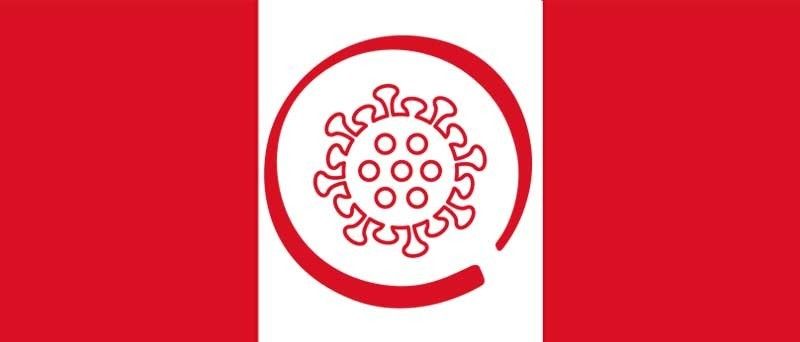
After over two years of strict Covid regulations to enter and move around Peru, finally at the beginning of October 2022 the Corona rules were significantly eased, making traveling to and in Peru not only simpler but also more relaxed again. And yesterday, October 26, 2022, we were all surprised to hear that finally the state of emergency is lifted.
Important Update October 27, 2022 - No more restrictions to travel to and in Peru
Today, October 27, 2022, it was made official with the publication of the Supreme Decree 130-2022-PCM in Peru's official gazette El Peruano that starting November 1, 2022, the State of Emergency in Peru is finally lifted and all (!!!) Covid entry requirements as well as all other regulations, and restrictions that were in place to avoid the spreading of Covid are repealed.
So, no more proof of a vaccination certificate or negative PCR test (even though the public is encouraged to get vaccinated), no more masks anywhere (even though the public is encouraged to wear one) and no more national provisions of any kind.
However, on ministerial level prevention and control measures to stop the spread of Covid remain in place and, if and where necessary, the Peruvian Ministry of Health will publish Ministerial Resolutions stipulating necessary measures.
So, finally, after well over two years, traveling to and in Peru is back to "normal" again.
The Covid situation in Peru until October 31, 2022
When the first Covid cases were confirmed in Peru in mid-March 2020, the government reacted with extreme measures closing all borders within a couple of days, suspending all international and national travel by air, land, sea and river, shutting down the country completely and sending everyone into lockdown, and this for months. In October 2020, these extremely extreme measures were (partly) lifted and traveling to Peru by air and in Peru by air and land was possible again. However, the Peruvian government put one of the strictest Covid regimes in Latin America in place and entering and traveling in Peru was only possible under strict and constantly changing rules which included next to many others, for example, compulsory vaccinations, mandatory masks everywhere and anytime, outlawing unvaccinated Peruvians, residents and foreigners. Only in February 2022, land borders were opened again.
While since mid-2022 the Covid regulations were increasingly handled more relaxed and most businesses didn’t strictly enforce the rules anymore, with an announcement from the Peruvian Minister of Health in September 2022 and an update of the Covid regulations some of the unpleasant and outdated Covid rules (for example, mandatory health declaration to enter Peru, mask mandates, checking of vaccine certificates to enter indoor spaces) were officially eliminated or at least eased.
However, be aware that Peru is still in a state of emergency (for now, at least until the end of October 2022) and the national health emergency was already extended until the end of November 2022. Additionally, it was announced that prevention and control measures to stop the spread of Covid remain in place until February 24, 2023. And usually every four to eight weeks, the Peruvian government updates the Covid regulations either only extending the state of emergency and the national health emergency for another month or changing entry requirements and rules for getting around the country.
Furthermore, depending on case numbers and hospital utilization, different alert levels - ranging from moderate to high to very high and extreme - with corresponding public health measures and movement restrictions - are still in place on the regional level and are re-evaluated every few weeks.
And Peru still requires that foreign visitors present a physical or digital vaccination certificate (depending on the regulations in your home country proving two or three shots against Covid) or present a negative PCR test result to enter Peru.
But be aware that regardless of the official Peruvian requirements to enter the country, to travel in Peru and to use services in Peru, the one or other airline flying you into Peru, some national airlines, a few long-distance bus companies, the one or other tour operator, ... might still ask to see proof of three doses of a vaccine against Covid to let you use their services. If you are only vaccinated twice, a negative PCR test may be required.
So, to enjoy your stay in Peru and avoid any problems, especially with airlines flying you into Peru, with entering the country and traveling, it is recommended to be vaccinated with three doses. If you are only vaccinated twice and this is ok in your home country, we recommend getting in contact with the service providers you are planning to use (especially international and national airlines or national bus companies) to check if they are fine with your vaccination status, require a third dose or a negative PCR test.
Covid entry requirements for Peru until October 31, 2022
For international passengers on commercial flights and travelers crossing into Peru at a land border, Peru requires the following (October 12, 2022):
- Peruvians and foreign residents 12 years and older must present a vaccination certificate proving they had 3 doses of a vaccine against Covid (see Supreme Decree 118-2022-PCM , article 4.3).
- Non-resident foreigners (visitors) must present proof of being vaccinated according to the “vaccination scheme” of their home country (see Supreme Decree 118-2022-PCM , article 4.3).
- Those not vaccinated according to the above rules can present a negative real-time COVID-19 molecular (RT-PCR) test result that is not older than 48 hours after being issued and before boarding the plane (see Supreme Decree 118-2022-PCM , article 4.3).
- Children under the age of 12 years just have to be healthy (asymptomatic) - we highly recommend checking if the airline requests any document / test result to prove that the child is healthy (see Supreme Decree 118-2022-PCM , article 4.3).
- If you show Covid symptoms upon arrival, you can be forced to take a Covid test and will be put into quarantine, no matter your vaccination status.
- Pre-registration on the immigration app prior to arrival (optional (!!!) and only for travelers flying into Peru)
- Since October 12, 2022 travelers do not need to fill in the Affidavit of health anymore (Ministerial Resolution 811-2022-MINSA)
- Even though not specifically mentioned in the current Covid regulations ( Supreme Decree 118-2022-PCM ) from September 30, 2022, but announced by the Peruvian Minister of Health on September 22, 2022, the mask mandate on domestic and international flights and indoor spaces with ventilation (which the airport should be) finally is history.
Above requirements may change at any time, so we highly recommend contacting your airline a few days before your flight to Peru.
Covid regulations when traveling in Peru until October 31, 2022
Peru surely is one of the most amazing countries to visit: breathtaking landscapes, diverse and partly untouched nature, ancient cultures with all the impressive monuments they left us, lovely and inviting people and an incomparable gastronomy.
However, Covid hit Peru hard and despite partly extreme strict measures to get the pandemic under control, many people got infected and lots died over the past two and a half years. And despite high vaccination rates, the Peruvian government stuck way too long to certain restrictions and regulations which finally were eased a bit at the beginning of October 2022.
While mostly vaccination certificates aren't checked anymore (not in supermarkets, malls, restaurants, hotels, etc.) making it possible again and enjoyable to travel to Peru even if you are unvaccinated, if you don't want to make a PCR test to enter Peru, to fly domestically and to travel completely unhindered best have at least your first and second dose of a Covid vaccine. And, even though not legally required for tourists just for Peruvian residents and even though the situation relaxed quite a bit over the past months, if you are older than 12 years, the one or other airline, restaurant, tour operator, mall, other private company, etc. might still want to see proof of three shots.
So, if you are planning to visit Peru, here some general information about the most important regulations and some recommendations:
- It's obligatory to wear a single KN95 / FFP2 mask or double masks (a community mask (cloth) above a three-layer surgical mask) in indoor spaces without ventilation, in hospitals and health centers, and on busses ( Supreme Decree 118-2022-PCM , article 4.1).
- Wearing a mask outdoors and in indoor spaces with ventilation is optional ( Supreme Decree 118-2022-PCM , article 4.1).
- In case you suffer from any respiratory symptoms, wearing a single KN95 / FFP2 mask or double masks (a community mask (cloth) above a three-layer surgical mask) is obligatory ( Supreme Decree 108-2022-PCM , article 4.1).
- According to the official regulations, face shields aren't obligatory anymore.
- On national flights, resident passengers over the age of 12 years must have received 3 shots of a vaccine against Covid (foreigners just visiting aren't mentioned, but some national airlines apply the 3 shot rule to them as well). If you haven't received the 3 doses, a negative real-time COVID-19 molecular ( RT-PCR ) test result that is not older than 48 hours after being issued and before boarding the plane has to be presented (see Supreme Decree 108-2022-PCM , article 4.4). Children under the age of 12 years just have to be healthy (asymptomatic). Masks are obligatory.
- On intercity / interprovincial busses , resident passengers over the age of 12 years must have received 3 shots of a vaccine against Covid (foreigners just visiting aren't mentioned, but some national bus companies apply the 3 shot rule to them as well). If you haven't received the 3 doses, a negative real-time COVID-19 molecular (RT-PCR) test result that is not older than 48 hours after being issued and before boarding the bus has to be presented (see Supreme Decree 108-2022-PCM , article 4.5). Children under the age of 12 years just have to be healthy (asymptomatic). Masks are obligatory.
- Residents of Peru over the age of 18 years wanting to enter indoor spaces must permanently wear a mask and must prove that they had their first, second and third shot. (see Supreme Decree 108-2022-PCM , article 4.6) Please note: Even though not specifically mentioned in the current regulations (Supreme Decree 118-2022-IN) if the indoor space is ventilated no masks are required anymore and most of these indoor spaces do not check the vaccination certificate anymore.
- In most other places , including, for example, archaeological sites, parks, beaches, rivers, lagoons, swimming pools, sport stadiums, etc. everyone over 5 years must present their vaccination certificate proving 2 shots , everyone older than 18 years 3 shots (see Supreme Decree 108-2022-PCM , article 5). Please note: Even though not specifically mentioned in the current regulations (Supreme Decree 118-2022-IN) most of these places do not check the vaccination certificate anymore.
- In October 2020, immigration officers at the airport stopped the stamping of passports upon arrival and departure to minimize the risk of spreading Covid-19. While travelers didn't have a physical stamp in their passport, their arrival and departure was and still is digitally recorded (see our glossary under TAM and our article " How many days did I get "). In May 2022, the stamping of passports was resumed and you get a passport stamp again.
- Follow official regulations and respect restrictions. Fines are costly.
- Respect safety and security protocols and hygiene measures in places you visit and follow the instructions of tourism professionals, guides, drivers, hotel staff, etc.
- If you need a PCR or antigen test, many hotels and other accommodation providers in Peru either offer this service at their own implemented facilities or can advise and / or coordinate an appointment with a laboratory or clinic nearby. You can as well make the test at the Jorge Chavez International Airport (be aware that PCR test results usually take between 6 and 12 hours).
- Make sure you have a good travel insurance that provides medical coverage not only for injury and illness during your travel in Peru but also for the treatment of Covid and a possible repatriation.
Stay safe and healthy!
- 77 Comments
- Subscribe Unsubscribe
- Collapse All Expand All
or post as a guest
Peru Newsflash

New lizard species discovered in Peru

Peru has the second-worst drivers in the world

Machu Picchu reopens for the first time after the social outbreak

Peru extends the state of emergency in 44 districts
Peru event calendar, upcoming events in peru.
More in the Peru Event & Entertainment Calendar
Latest Content...

International Christian School of Lima - ICS Lima

Peruvian Digital Nomad Visa

Legislative Decree No. 1582 (Modification of the Peruvian Foreigner Law, Nov 2023)

Queso Rojo de Lluta

Peruvian Queso Andino

Peruvian Quesillo

Peruvian Queso Mantecoso

Peruvian Queso Paria

Peruvian Queso Fresco

Extension of a Migraciones deadline

Amnesty for Migraciones fines

Update your information in the Migraciones database

Replacement for a lost, stolen or damaged carné

Renewal of the Carné de Extranjería
Latest video.

Maria Reiche - Memories
Long reads....

The Mystery of the Nazca Lines in Peru

Francisco Pizarro González (1474-1541)

The colorful Fabrics and Textiles of Peru

The Jeweled Frog and the Condor

lima·easy - /ˈli mə/ - /ˈi zi/
In loving memory of "Jack" & "Lola"
Nomadic Matt's Travel Site
Travel Better, Cheaper, Longer
Peru Travel Guide
Last Updated: September 1, 2023
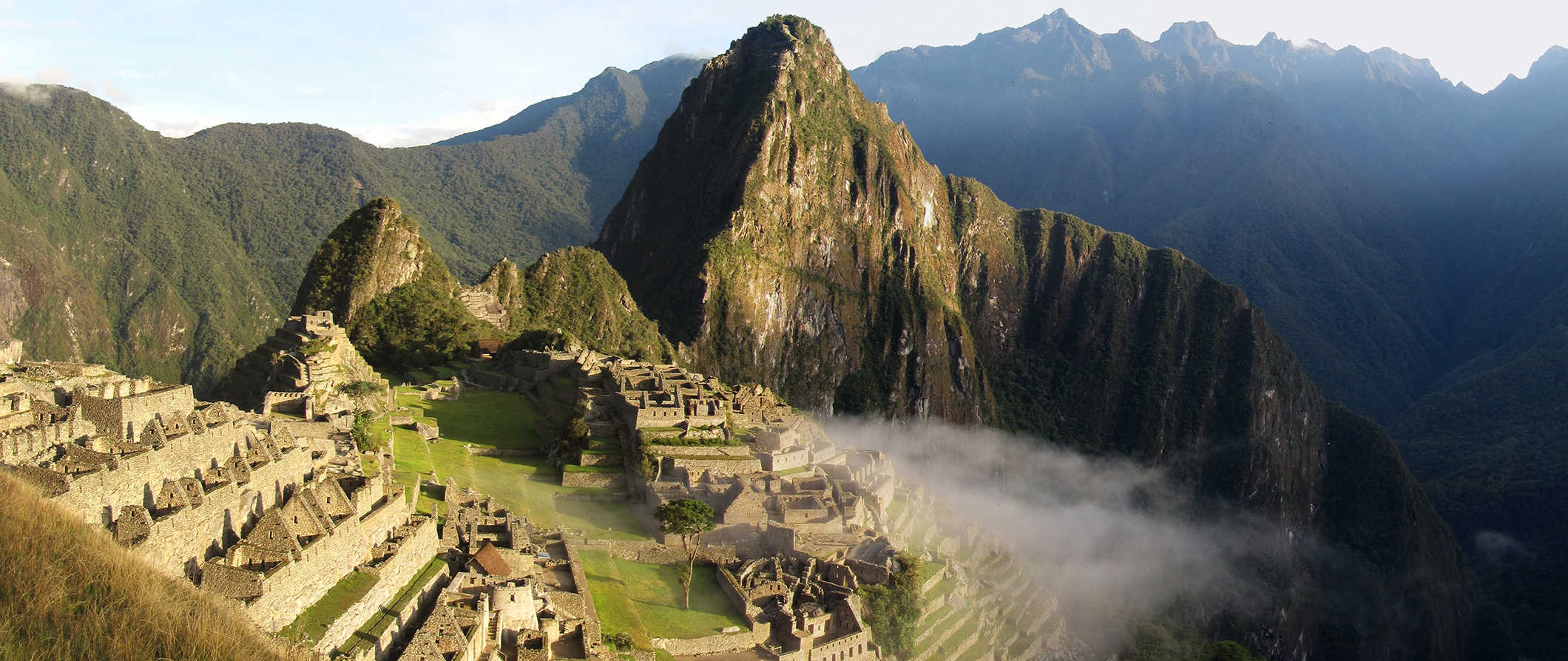
Travelers flock to Peru to hike the famous Inca Trail, explore the lush jungles, and devour their way through the incredible food scene of Lima.
But while the Inca Trail and Machu Picchu attract the majority of the attention (2,500 people visit Machu Picchu every day), there is much more to see and do in Peru if you’re willing to get out there and explore.
From the famous Lake Titicaca to the beaches in the north to the vibrant indigenous culture, Peru is bursting with things to see and do.
While many travelers just visit for a week to see the highlights, you can easily spend a month here (or more) and still not see everything.
Best of all, traveling around Peru is inexpensive. You don’t need a lot of money to visit here (even if you hike the Inca trail).
This guide to Peru can help you plan your trip, save money, and make the most out of your time in this beautiful destination!
Table of Contents
- Things to See and Do
- Typical Costs
- Suggested Budget
- Money-Saving Tips
- Where to Stay
- How to Get Around
- How to Stay Safe
- Best Places to Book Your Trip
- Related Blogs on Peru
Top 5 Things to See and Do in Peru
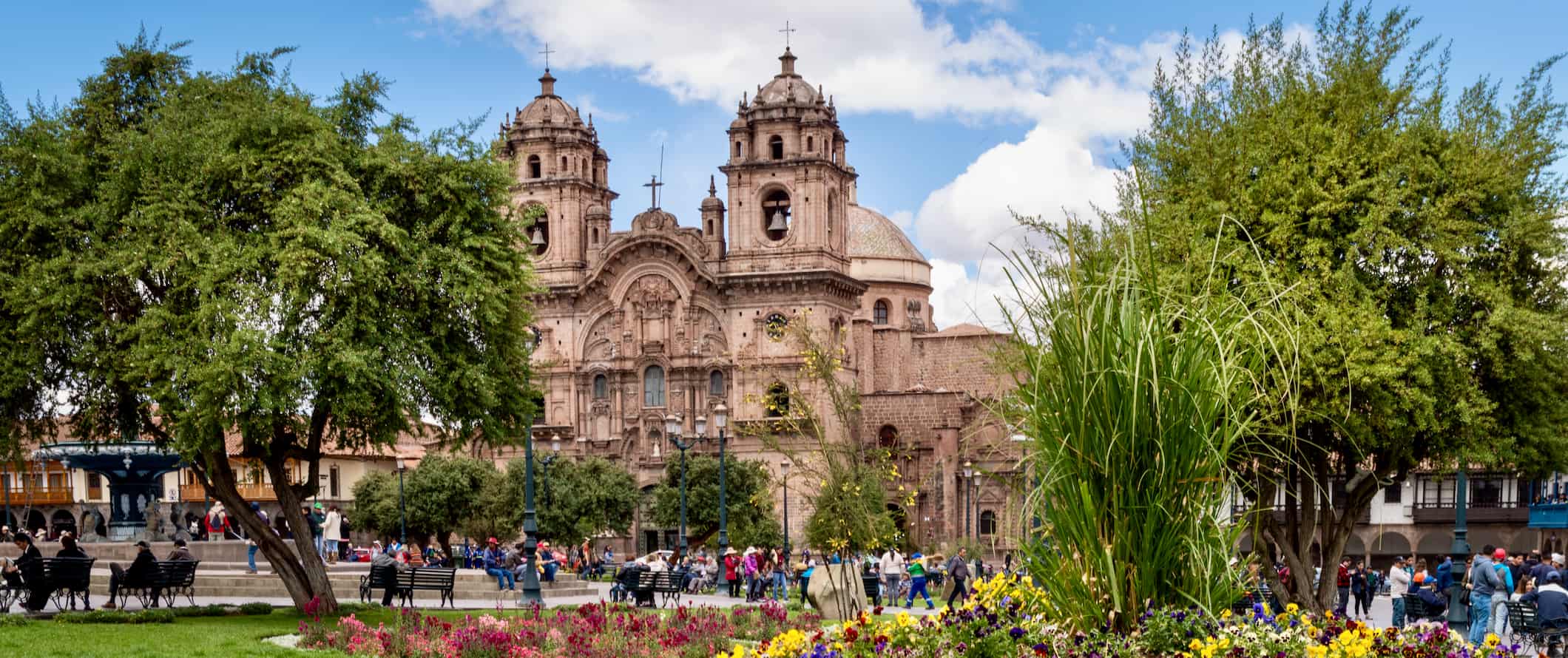
1. Explore Machu Picchu
This legendary “lost city of the Incas” is one of the most-visited tourist attractions in South America. Here you have the chance to wander around the old Inca city observing ancient aqueducts, granite and limestone temples, and other forms of Inca architecture that are all beautifully preserved. There are two ways to see Machu Picchu depending on the amount of adventure and exercise you want. There is a 4-day/3 night hike that takes you through 43 kilometers (26 miles) of steep, yet scenic uphill terrain along winding Andean mountain trails starting from Ollantaytambo. The Inca Trail gets you to the majestic Machu Picchu at dawn in time to see it before the clouds arrive mid-morning. The alternative is to wake up super early to get the train there and enter along with the tour groups competing for the beautiful morning sunset photos. (There are also longer 7-8 day hikes too if you want an even bigger challenge. Multi-day hikes start around 2,600 PEN. You can also just buy a day pass if you don’t want to hike.
2. Check out Lima
Lima is a chaotic and beautiful introduction to the country. Check out the trendy, vibrant Miraflores neighborhood that overlooks the Pacific and has plenty of restaurants and bars to try. Also, visit the Larco Museum to see its pre-Columbian artifacts, the Aliaga House for Peruvian art and artifacts, and Plaza Mayor for colonial beauty. Tour the city’s colorful markets for both food and shopping, wander around the world’s only Cat Park, or check out the Park of Love for good luck in love. At night, head to the artsy Barranco district for the nightlife and try a local drink with pisco, a local brandy. The city is a foodie hub too so don’t forget to try the ceviche!
3. Fly over the Nazca Lines
The Nazca Lines are a series of ancient geoglyphs that dominate the San José desert and Nazca Valley. There are over 10,000 lines and 300 different plant and animal figures that make up this UNESCO World Heritage Site. No one really knows how they got there (maybe aliens?) but the park itself is free to visit. If you want to splash out and get a better view, take a scenic helicopter or plane tour (they cost around 400 PEN).
4. Relax at Lake Titicaca
This stunning lake covers over 7,790 square kilometers (3,000 square miles) and sits at 3,810 meters (12,500 feet) above sea level, making it the world’s largest high-altitude lake. With deep blue water and spectacular sunsets across the lake lined with snowy mountains, this lake attracts people from all over the world to the nearby towns, which offer a mix of colonial architecture and bustling markets. There are three islands on the lake that are home to pre-Inca ruins: Isla del Sol, Taquile, and Amantani. Every year, the Peruvian side of Lake Titicaca at Puno celebrates the Fiesta de la Virgen de Candelaria in February. However, the best and driest time to visit is June, July, and August.
5. Hike the Colca Canyon
Other things to see and do in peru, 1. hike the inca trail.
Getting to Machu Picchu is best via the famed Inca Trail . This multi-day hike allows you to see the mountains, jungles, and follow the route the Incas used to take. It is a truly spectacular hike, but it is challenging and you may experience altitude sickness. There are two ways to do this hike: you can sign up to be part of an organized tour, or you can hire your own private guide. You cannot hike the trail independently. Tours start around 2,600 PEN for a 4-day, 3-night tour with a reliable, reputable company. The final leg of the hike can actually get a bit crowded, so if you can do a longer 7-day hike you’ll be able to beat the crowds and enjoy the incredible landscape before you arrive. The driest time is May-October but also unfortunately the most crowded. If you go from November-April, prepare for mud and perhaps rain but fewer crowds.
2. Visit the Islas Flotantes de los Uros
The Floating Islands of the Uros may sound like an Indiana Jones title, but it is actually the name of the group of man-made islands in Lake Titicaca. The islands are home to the indigenous Uros people who have built their own houses, islands, and boats from the tortora reeds which grow along the banks of the lake. This is an extremely touristy site and is a bit exploited as such, so it’s not for everyone. The boat tours start at 165 PEN.
3. Surf at Máncora Beach
Great fresh seafood, watersports, horseback riding, whale watching, fishing with locals, visiting the mangroves, and plenty of relaxation are the order of the day at this popular beach resort. Máncora is one of the finest beaches in South America and its year-round sunshine, two ocean currents, and beginner-friendly waves also make it Peru’s surfing Mecca. Accommodation prices can be expensive from December to March, so it’s best to book in advance. Whale watching costs 135 PEN, surfing classes start at 95 PEN, and SUP tours with sea turtles cost 175 PEN.

4. Step back through time at Batán Grande
Batán Grande, also known as the Sicán Archaeological Complex, is an archaeological site comprising 50 pyramids and tombs, which are thought to date to 750-1300 CE. Located near Chiclayo, this site was once the ancient Sicán capital and has yielded many impressive pre-Columbian artifacts. For example, a gold Tumi ceremonial knife weighing almost seven pounds was recovered from one of the royal tombs! Bring plenty of water, sunscreen, and snacks for the day.
5. Discover Cusco
This colonial city is a major tourist destination and sits on Inca-built stone foundations not far from Machu Picchu. The area is popular with trail walkers, history lovers, and party goers who come to enjoy the city’s nightlife and festivals. Cusco is the undisputed archaeological capital of the Americas and an essential part of your trip to Peru. The Cusco Tourist Ticket grants admission to most of the popular archaeological sites and attractions in the Cusco area (with some notable exceptions, including Machu Picchu). Note that transportation and guide services are separate. You can purchase either a 10-day pass that includes admission to over 16 sites (130 PEN) or one of several different “circuit” tickets that include admission to a smaller number of sites and are valid for one day only (70 PEN). Be sure to visit Coricancha (15 PEN) and Sacsayhuaman (included in the Cusco Tourist Ticket) during your visit. Right outside Cusco, take a day trip to the incredible Rainbow Mountains. For great food, head to Green Point. Plan to spend around 3-5 days in Cusco as there is plenty to see and it’s a good place to acclimate before doing any hiking as the city sits at 3,200 meters (10,500 feet) above sea level.
6. Get your Amazon fix in Iquitos
Accessible only by boat or plane, jungle-locked Iquitos is the largest city within the Peruvian rainforest. The city sits at the mouth of the Amazon and is the perfect destination for eco-tourism. The nearby Pacaya Samiria National Reserve is Peru’s largest reserve at two million hectares. It’s home to a huge range of nearly 1,000 birds, mammals, fish, reptiles, and more. A 3-day, 2-night tour through the reserve starts from around 1,400-1,500 PEN per person including food.
7. Sandboard in Huacachina
This little town is a desert oasis and a welcome relief after hiking through Machu Picchu. It’s very affordable and hostels here offer great deals for sandboarding and sand buggy tours around the nearby dunes. Two-hour tours cost about 100-125 PEN, which includes a sand buggy driver and sandboard rental. Most tours leave around 4pm so you can catch the sunset on the dunes. There is also a lagoon surrounded by palm trees in Huacachina, and you can rent a rowboat to paddle around it. A half-hour rental costs around 5 PEN per person. Huacachina is easily reached by bus from Lima, Cusco, Nazca, Arequipa, and Paracas.
8. See penguins in Paracas
Paracas is in the south of Peru and is sometimes called the “Poor Man’s Galapagos” for its impressive wildlife, consisting of over 400 different species. Thousands of birds, as well as large sea lion and penguin populations, call the area home. You can visit the Paracas National Reserve via an organized boat tour. Be sure to go early. A full-day tour of Paracas includes a boat trip to the Islas Ballestas and a bus trip around the national reserve in the afternoon. It costs about 150 PEN.
9. Walk through the White City
Arequipa is a beautiful city with a historical center that was constructed primarily from volcanic rock. Start getting to know the city by wandering around the Plaza de Armas and take in the city’s architecture over a glass of wine overlooking the main square with views of the stunning Basilica Catedral de Arequipa. Then, visit the gorgeous, vibrantly colorful Santa Catalina Monastery, see a frozen Inca mummy, and enjoy the local cuisine with favorites like shrimp soup or spicy stuffed peppers. It’s easy to see why Arequipa is undoubtedly one of the most beloved destinations in the country; everyone who visits here loves it.
10. Go to El Parque de la Reserva
This park in downtown Lima is home to the largest water fountain complex in the world, called El Circuito Mágico del Agua . There are 13 distinct fountains in total, including the Tunnel Fountain of Surprises, the Children’s Fountain, and the Fantasia Fountain, whose water jets are synchronized to music during the evening laser light shows. The park is open daily from 3pm-10pm, with beautiful, colorful light shows taking place at 6:50pm, 7:50pm, 8:30pm, and 9:30pm. The entrance fee is 4 PEN. The park also hosts a lot of events and is a popular place with dog owners too.
11. Visit Chachapoyas
This region in the Andean mountains was home to the Chachapoya civilization that lived there between 500-1432 (they were eventually conquered by the Aztecs). Today, you can visit Kuelap, the fortified city at known as “The Machu Picchu of the North.” The ruins are accessible via a guided tour, 4-hour hike, or cable car from the nearby town of Nuevo Tingo for 21 PEN roundtrip. Be sure to also visit Gocta, a beautiful waterfall that, at 770 meters (2,526 feet), is one of the tallest in the world. You can get there by taking a tour from Chachapoyas.
12. Tour Trujillo
Trujillo is the second-oldest Spanish city in Peru, located on the coast with eternal spring-like weather and widely considered the capital culture of Peru. While here, visit the archaeological site of Chan Chan, the world’s largest adobe city ever built and the largest pre-Columbian city. It was built by the Chimu, a civilization that inhabited the area until 1470 when they were defeated by the Incas. Admission is 11 PEN. Be sure to also visit Huanchaco, a small fishing town directly on the beach.
13. See Vinicunca, Rainbow Mountain
Chances are you’ve seen these colorful mountains on social media. Over the past few years, Rainbow Mountain has become a huge tourist attraction. Just keep in mind that the colors are not as vivid in real life and the place is super crowded (it’s a very popular site). Day trips and multi-day hikes are available from Cusco, usually starting around 110-135 PEN per person. There is also an “Alternative” Rainbow Mountain called Palcccoyo where you can enjoy an incredibly colorful scenic panoramic at 5,200 meters (17,060 feet). If you want to escape the hordes of people (though it’s also pretty busy these days).
14. Hike the Salkantay
If you want an alternative to the busy Inca Trail, try hiking the Salkantay. It sees a fraction of the tourists and is half the price of the Inca Trail — but just as stunning! There aren’t as many ruins, but there are epic mountain views and summits of up to 5,200 meters (17.060 feet)! Hikes can vary in length, but the 7-day hike offers the best views. You’ll need to be in decent shape though. 5-day hikes start around 1,700 PEN.
Peru Travel Costs
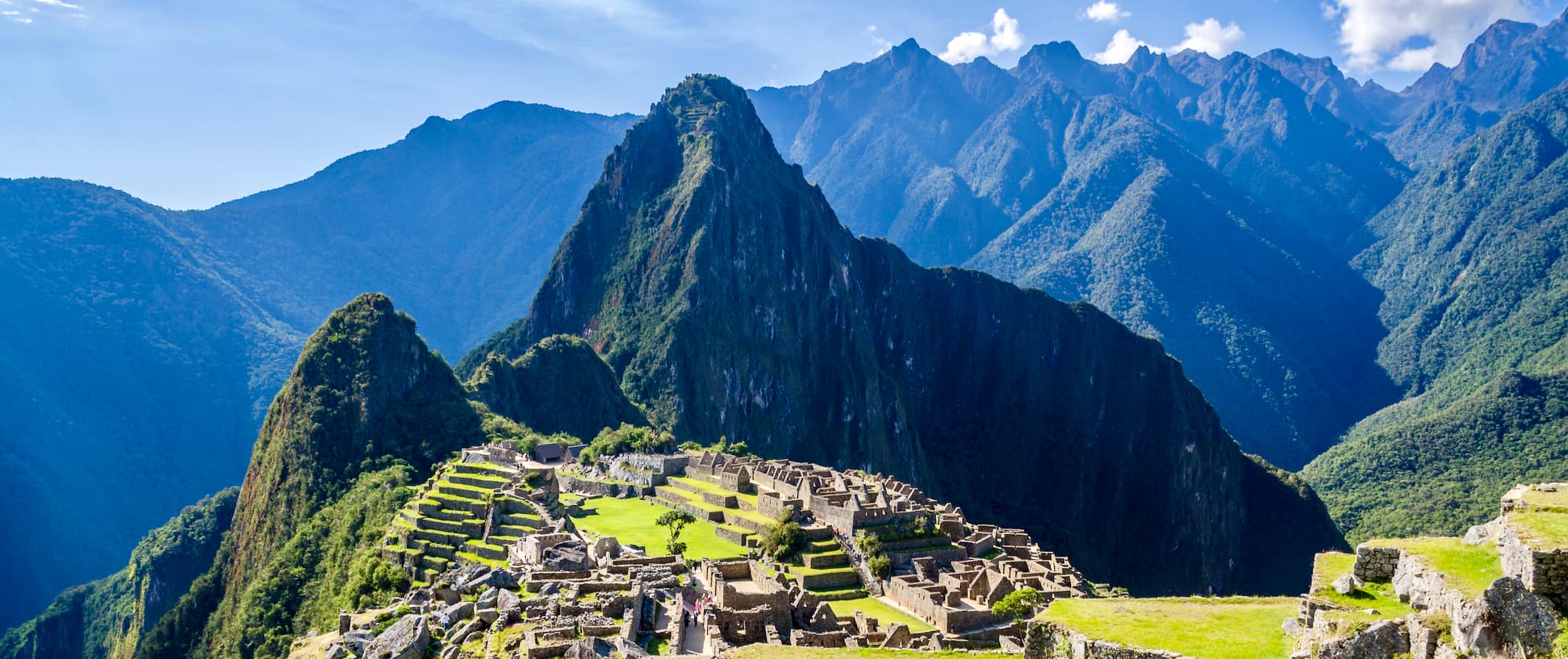
Accommodation – A bed in a 4-6-bed dorm costs 35-65 PEN while a bed in a dorm with 10 or more beds generally costs 32-38 PEN. A private room costs 115-170 PEN per night. Free Wi-Fi is standard and most hostels also have a kitchen or include free breakfast.
Budget hotel rooms with basic amenities like Wi-Fi, TV, and occasionally free breakfast cost around 85-105 PEN per night.
On Airbnb, which has limited availability in Peru, private rooms average around 100 PEN while entire homes start at 200 PEN per night. Book early though or prices will double.
For those traveling with a tent, wild camping is permitted as long as you’re not on somebody’s land.
Food – Cuisine in Peru varies from region to region, though you can expect to find staples like potatoes (most potatoes in the world originated here), quinoa, seafood, and indigenous animals like guinea pig and alpaca. Be sure to try ceviche, which is the national dish (it’s a seafood dish with fresh raw fish). Other popular dishes include stir-fried beef, roasted cuy (guinea pig), arroz con pato (rice with duck), and roasted chicken.
Overall, dining out in Peru is very inexpensive. Street food is incredibly cheap, costing 5-7 PEN for a meal from a parrilla (grill) set up on the side of the road. A plate of food at a casual takeaway restaurant serving Peruvian cuisine costs around 10 PEN.
A meal of traditional cuisine at a casual restaurant with table service costs around 15-25 PEN. If you want to splash out, a three-course meal at a mid-range restaurant costs 45 PEN.
Fast food (think McDonald’s) is 20 PEN for a combo meal. A large pizza is around 28-30 PEN.
Beer is around 8 PEN while a glass of wine or a latte is around 9 PEN. Bottled water is 2 PEN. A cocktail is 15-20 PEN and up, though many restaurants have extended happy hour specials (sometimes even all day).
If you plan on cooking, expect to pay 60-80 PEN per week for groceries such as pasta, rice, seasonal produce, and some meat. The best places to shop are the local markets, though Plaza Vea is the big grocery store chain with affordable prices as well. However, given how cheap food is here, it’s best to just eat out all the time. Buy snacks and fruit at the markets but eat out all other meals.
Backpacking Peru Suggested Budgets
On a backpacker’s budget of 135 PEN per day, you can stay in a hostel dorm, eat out for a few meals at cheap local street stalls and cook some meals, limit your drinking, take the bus to get around, and do mostly free or cheap activities like relaxing on the beach and going hiking.
On a mid-range budget of 400 PEN per day, you can afford a private Airbnb room, eat out for all your meals, drink more, take the occasional taxi to get around, and do more paid activities like going surfing or day-tripping to Machu Picchu.
On a “luxury” budget of 700 PEN or more per day, you can stay in a hotel, eat out anywhere you want, drink as much as you’d like, take some domestic flights, and do a longer multi-day trek to Machu Picchu. This is just the ground floor for luxury though. The sky is the limit!
You can use the chart below to get some idea of how much you need to budget daily, depending on your travel style. Keep in mind these are daily averages — some days you’ll spend more, some days you’ll spend less (you might spend less every day). We just want to give you a general idea of how to make your budget. Prices are in PEN.
Peru Travel Guide: Money-Saving Tips
Peru is generally pretty cheap, but it is easy to splash out here on food and tours. Here are a few hacks to cut down your costs in Peru:
- Stay at hospedajes – These are family-run hotels and are the cheapest accommodation you can find outside of hostel dorms. Try to stay in these as often as possible.
- Take public transportation – Embrace public transportation to get around — it’s super affordable so skip the taxis. You’ll save a fortune.
- Eat the meal of the day – These are set meals, often including multiple plates, that restaurants offer. Look around for set menu meals to eat out on the cheap.
- Travel off-season – For a low-cost trip, the best times to visit Peru are the fringe months of April and May or September and October. Prices are usually cheaper during these months.
- Take the colectivos – These are cheap buses that cost around 2-10 PEN for a ride. They are a bit confusing as they don’t necessarily have a schedule, but there is always a door person whom you can ask if the bus is going to your location. There are not always marked bus stops, so look for gathering crowds.
- Book tours last minute – If you are looking to do the Inca Trail and have a bit of extra time to wait for a deal, showing up in Cusco and booking a last-minute tour can save you lots of money. Booking months in advance means paying the premium price but if you can wait your patience may be rewarded. I wouldn’t recommend trying to get on last-minute if you have your heart set on doing it though since it might not work out.
- Go on a free walking tour – This is a great way to learn the history behind the places you are seeing and avoid missing any must-see stops. Free Walking Tour Peru has tours that can guide you around both Lima and Cusco. Just remember to tip your guide at the end!
- Bring a water bottle – The tap water here isn’t safe to drink so bring a reusable water bottle with a filter to save money and reduce your plastic use. LifeStraw is my go-to brand as their bottles have built-in filters to ensure your water is always clean and safe.
Where to Stay in Peru
Peru has a ton of hostels. Here are some of my favorite places to stay throughout the country:
- Pariwana Hostel (Lima)
- 1900 Backpackers Hostel (Lima)
- Loki Hostel (Cusco)
- Kokopelli (Cusco)
- Wild Rover Hostel (Cusco)
- Hospedaje Turistico Recoleta (Cusco)
- Arequipay Backpackers Downtown (Arequipa)
- Loki del Mar (Mancora)
- The Point Mancora Beach (Mancora)
How to Get Around Peru
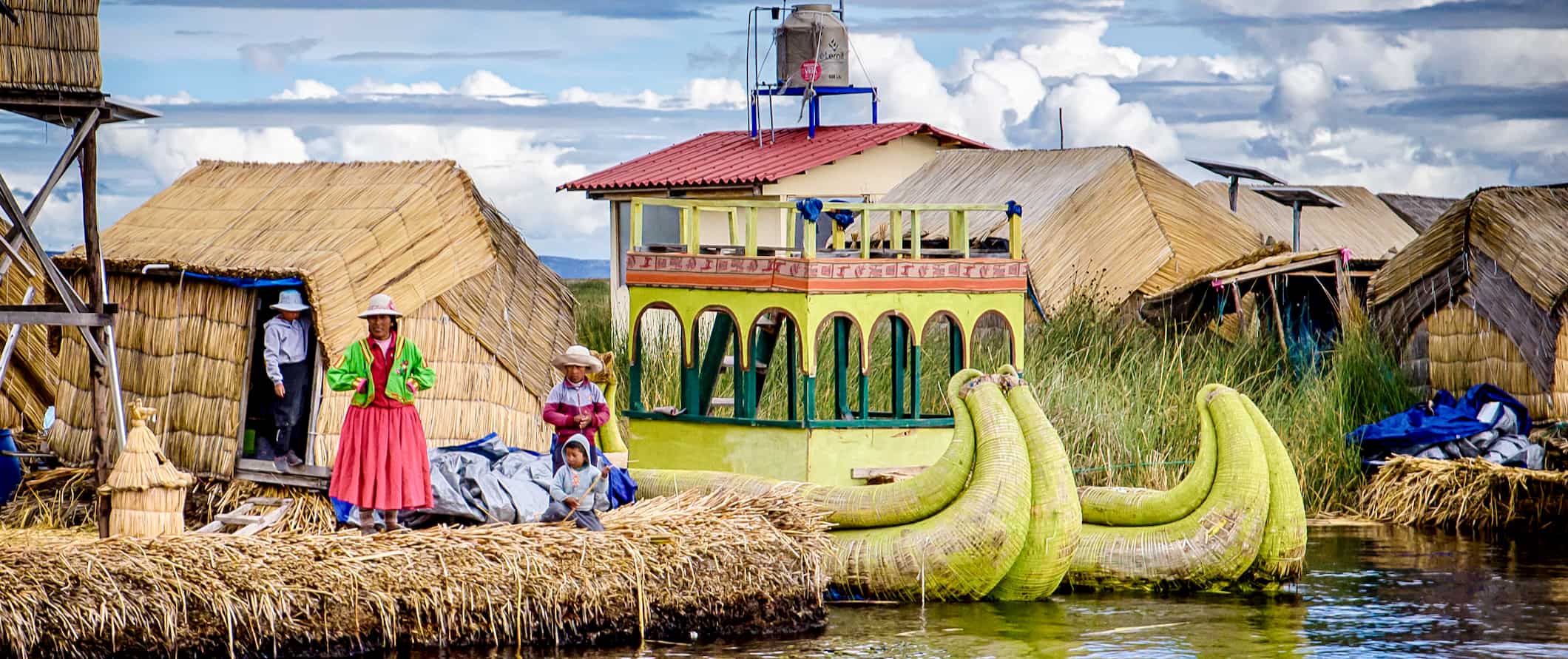
Public transportation – City buses cost around 1.50-3 PEN per trip. Microbuses ( colectivos ) are available and prices vary depending on the distance. Trips generally cost 2-10 PEN, though they are a bit hectic and take some getting used to.
Bus – Buses can take you all over Peru and are the most common way to get around for budget travelers. The usual price for a 10-hour bus journey is around 40 PEN depending on how nice the bus company is. You can use Cruz del Sur to look up bus schedules and prices. Keep in mind that any journey through the mountains will be a slow ride! Lima to Cusco takes over 21 hours and costs 185 PEN, though you can get a ticket for as low as 39 PEN if you book in advance.
Peru Hop is another reliable and comfortable bus company designed for backpackers. This bus is a hop-on/hop-off service you can take around the country. Three-day journeys from Lima to Cusco start from 683 PEN, while 7 days in Southern Peru costs 836 PEN.
Flying – Peru has five international airports (Lima, Arequipa, Cusco, Iquitos, and Piura), as well over a dozen airports with domestic service. LATAM, Avianca, and Star Peru are the main domestic airlines.
Flying between destinations isn’t always the cheapest option, but it’s a whole lot quicker. A flight from Lima to Cusco takes just over an hour (as opposed to the 21 hours by bus) and prices start around 250 PEN. Lima to Arequipa starts around 200 PEN.
Train – Like the rest of South America, the rail system in Peru is basically non-existent. There are nice tourist options though, like PeruRail and Inca Rail, which both run trains between Ollantaytambo and Machu Picchu Pueblo (the gateway to Machu Picchu). On PeruRail, tickets start from 179 PEN. Inca Rail also runs between Cusco and Machu Picchu Pueblo with tickets starting around 220 PEN.
From Lima, there’s just one train: the Ferrocarril Central Andino, the world’s highest passenger train, which travels across the Andes to Cerro de Pasco and Huancayo. One-way fare starts from 230 PEN. However, service is limited — sometimes the train only runs once a month. Journeys are currently suspended due to Covid so be sure to check their website for updates.
Car rental – I don’t suggest renting a car here as the drivers are aggressive, the roads are poorly maintained, and accidents are common. If you do decide to rent a car, use Discover Cars to find the best prices.
When to Go to Peru
Peru has just two seasons: wet and dry. May through October is the dry season, while November through April is the rainy season. The wettest months are from January to the end of April. This isn’t a great time to visit Peru — at least not in the mountain areas, where roads and hiking trails may become blocked or closed.
Most people come to Peru from the beginning of May to the end of November, with July and August being the busiest months. May and September are great months to visit, as tourism slows down slightly but temperatures are still pleasant.
If you want to spend more time in the mountains, June to September has clear, sunny days (but chilly nights). This is a good time to trek the Inca Trail. It’s also the best time to visit the Amazon Basin, when mosquitos are fewer.
Temperatures on the desert coast can get as high as 25-35°C (77-95°F) from December to April, while temperatures cool off from May-October. In the highlands from May-October, you can expect temperatures to reach 20-25°C (68-77°F).
How to Stay Safe in Peru
Peru is a pretty safe place to backpack and travel around, even for solo travelers, and even for solo female travelers. Your biggest worry is petty theft, which is rampant in the bigger cities and on overnight buses. Don’t flaunt expensive jewelry or belongings. Avoid taking your phone out in public if you can. Lock your bags on overnight buses and keep your valuables secure and out of sight. It’s easy to get robbed if you aren’t careful here (especially at night).
If you’re in Lima, don’t walk around alone at night, unless you’re in the safer neighborhoods (Miraflores and Barranco). Smaller cities and towns are perfectly safe to walk around alone day and night.
Solo female travelers should generally feel safe here, however, the standard precautions apply (never leave your drink unattended at the bar, never walk home alone intoxicated, etc.).
Scams aren’t super common but if you’re worried about getting ripped off, here’s a list of common travel scams to avoid .
If you’re doing any hiking, check the weather in advance and bring plenty of water. If you’re hiking to Machu Picchu, arrive early to adjust to the altitude. 3-5 days early can make all the difference!
If you experience an emergency, dial 011 for assistance. If you’re in one of the bigger cities, you can also seek out the tourism police.
For more in-depth coverage of how to stay safe in Peru, check out this post that answers some frequently asked questions and concerns.
The most important piece of advice I can offer is to purchase good travel insurance. Travel insurance will protect you against illness, injury, theft, and cancellations. It’s comprehensive protection in case anything goes wrong. I never go on a trip without it as I’ve had to use it many times in the past. You can use the widget below to find the policy right for you:
Peru Travel Guide: The Best Booking Resources
These are my favorite companies to use when I travel. They consistently have the best deals, offer world-class customer service and great value, and overall, are better than their competitors. They are the companies I use the most and are always the starting point in my search for travel deals.
- Skyscanner – Skyscanner is my favorite flight search engine. They search small websites and budget airlines that larger search sites tend to miss. They are hands down the number one place to start.
- Hostelworld – This is the best hostel accommodation site out there with the largest inventory, best search interface, and widest availability.
- Booking.com – The best all around booking site that constantly provides the cheapest and lowest rates. They have the widest selection of budget accommodation. In all my tests, they’ve always had the cheapest rates out of all the booking websites.
- Get Your Guide – Get Your Guide is a huge online marketplace for tours and excursions. They have tons of tour options available in cities all around the world, including everything from cooking classes, walking tours, street art lessons, and more!
- SafetyWing – Safety Wing offers convenient and affordable plans tailored to digital nomads and long-term travelers. They have cheap monthly plans, great customer service, and an easy-to-use claims process that makes it perfect for those on the road.
- LifeStraw – My go-to company for reusable water bottles with built-in filters so you can ensure your drinking water is always clean and safe.
- Unbound Merino – They make lightweight, durable, easy-to-clean travel clothing.
- Top Travel Credit Cards – Points are the best way to cut down travel expenses. Here’s my favorite point earning credit cards so you can get free travel!
Peru Travel Guide: Related Articles
Want more info? Check out all the articles I’ve written on Peru travel and continue planning your trip:
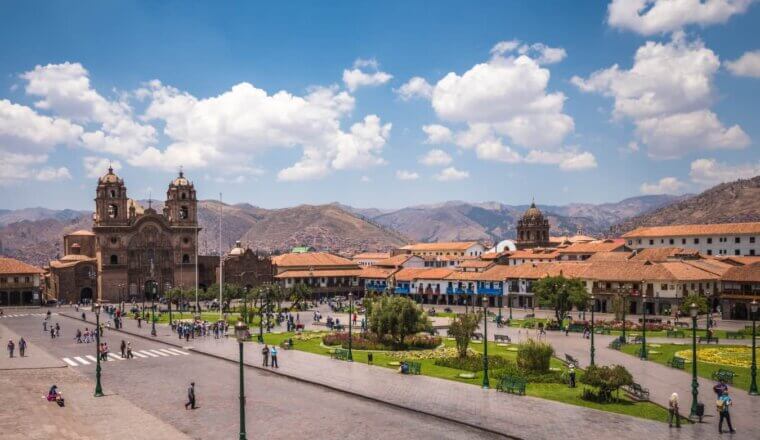
The 6 Best Hostels in Cusco
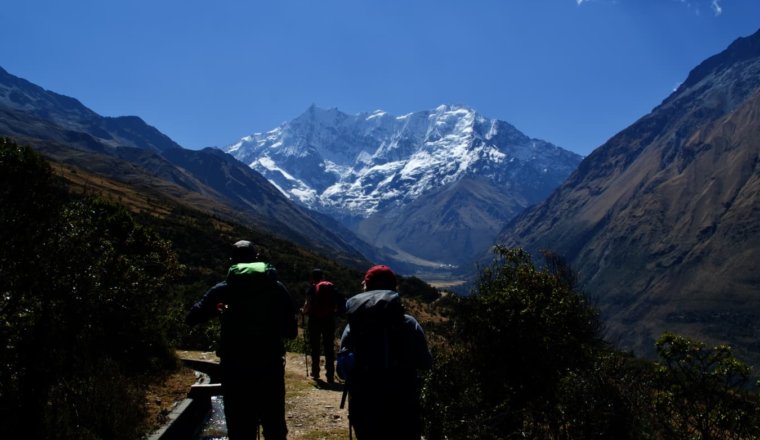
The 4 Best Tour Companies in Peru
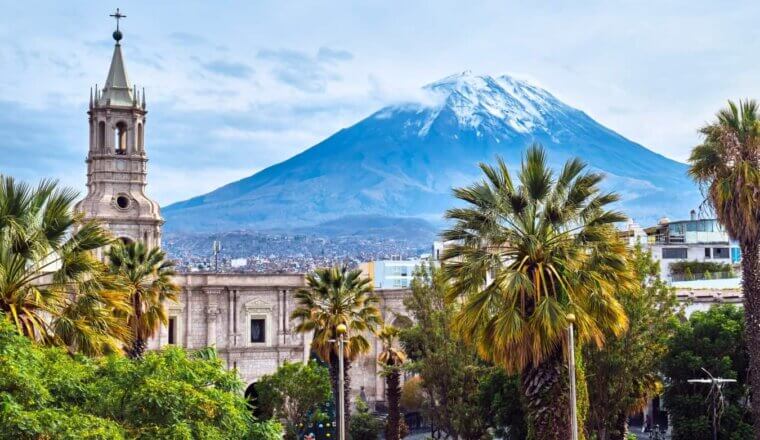
Is Peru Safe to Visit?
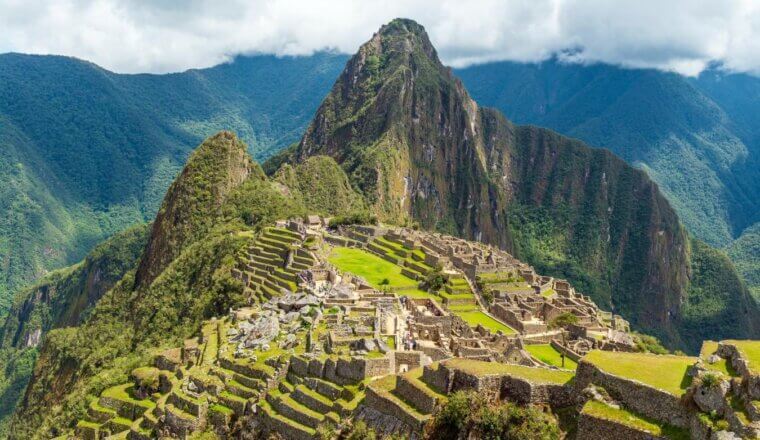
How to Hike the Inca Trail
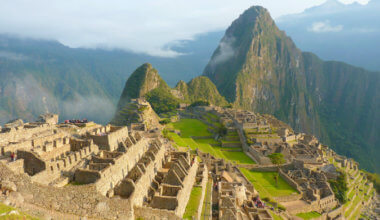
How to Turn Right at Machu Picchu and Find Atlantis
Get my best stuff sent straight to you, pin it on pinterest.
- Where To Stay
- Transportation
- Booking Resources
- Related Blogs
You are using an outdated browser. Upgrade your browser today or install Google Chrome Frame to better experience this site.
Peru Traveler View
Travel health notices, vaccines and medicines, non-vaccine-preventable diseases, stay healthy and safe.
- Packing List
After Your Trip
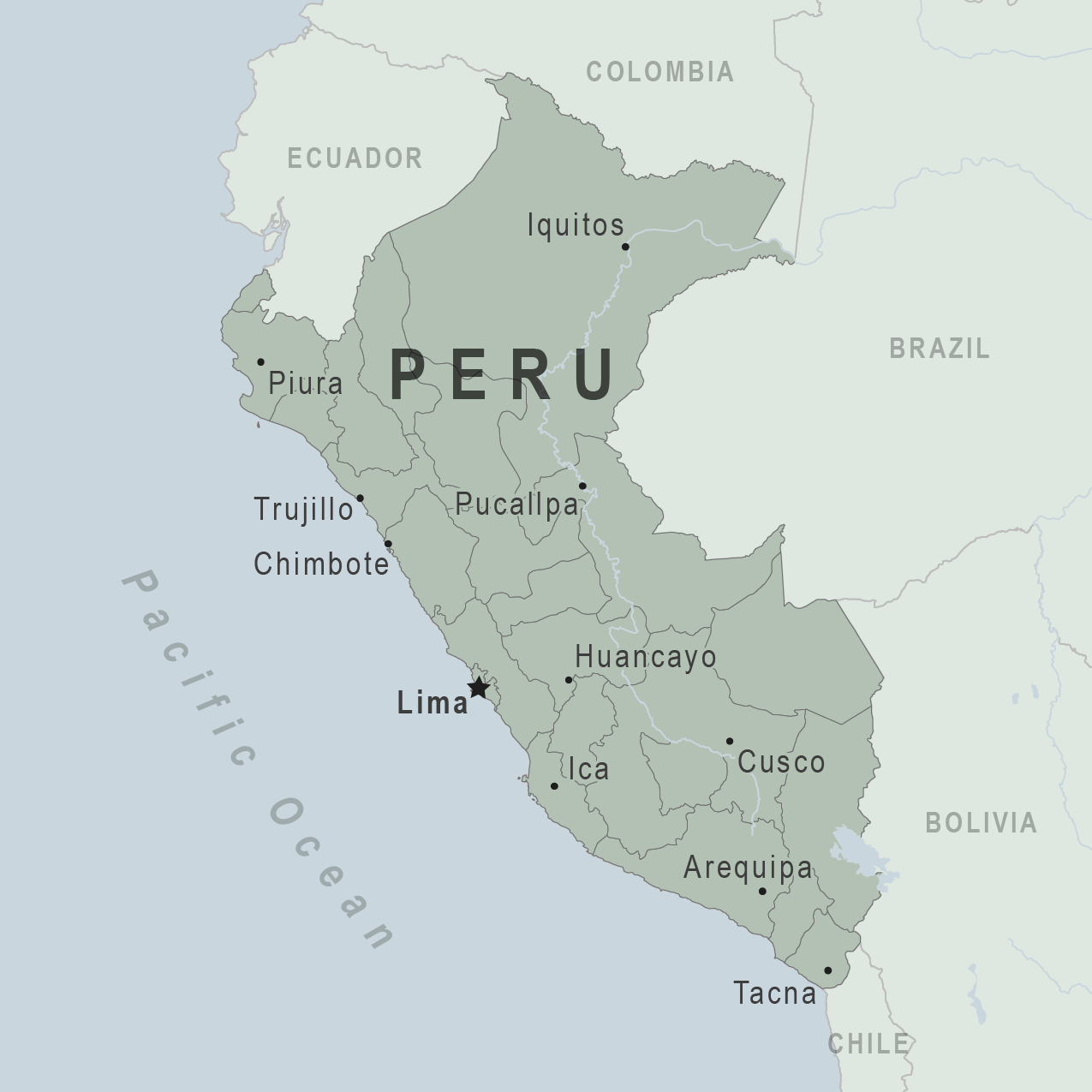
Be aware of current health issues in Peru. Learn how to protect yourself.
Level 1 Practice Usual Precautions
- Updated Dengue in the Americas May 16, 2024 Dengue is a risk in many parts of Central and South America, Mexico, and the Caribbean. Some countries are reporting increased numbers of cases of the disease. Travelers to the Americas can protect themselves by preventing mosquito bites. Destination List: Argentina, Brazil, Colombia, Costa Rica, Curaçao, Ecuador, including the Galápagos Islands, French Guiana (France), Guadeloupe, Guatemala, Guyana, Honduras, Martinique (France), Mexico, Nicaragua, Panama, Paraguay, Peru, Uruguay
- Oropouche Fever in South America April 24, 2024 There are outbreaks of Oropouche fever in parts of Brazil, Bolivia, and Peru. Travelers to affected areas should take steps to avoid bug bites. Destination List: Bolivia, Brazil, Peru
⇧ Top
Check the vaccines and medicines list and visit your doctor at least a month before your trip to get vaccines or medicines you may need. If you or your doctor need help finding a location that provides certain vaccines or medicines, visit the Find a Clinic page.
Routine vaccines
Recommendations.
Make sure you are up-to-date on all routine vaccines before every trip. Some of these vaccines include
- Chickenpox (Varicella)
- Diphtheria-Tetanus-Pertussis
- Flu (influenza)
- Measles-Mumps-Rubella (MMR)
Immunization schedules
All eligible travelers should be up to date with their COVID-19 vaccines. Please see Your COVID-19 Vaccination for more information.
COVID-19 vaccine
Hepatitis A
Recommended for unvaccinated travelers one year old or older going to Peru.
Infants 6 to 11 months old should also be vaccinated against Hepatitis A. The dose does not count toward the routine 2-dose series.
Travelers allergic to a vaccine component or who are younger than 6 months should receive a single dose of immune globulin, which provides effective protection for up to 2 months depending on dosage given.
Unvaccinated travelers who are over 40 years old, immunocompromised, or have chronic medical conditions planning to depart to a risk area in less than 2 weeks should get the initial dose of vaccine and at the same appointment receive immune globulin.
Hepatitis A - CDC Yellow Book
Dosing info - Hep A
Hepatitis B
Recommended for unvaccinated travelers younger than 60 years old traveling to Peru. Unvaccinated travelers 60 years and older may get vaccinated before traveling to Peru.
Hepatitis B - CDC Yellow Book
Dosing info - Hep B
CDC recommends that travelers going to certain areas of Peru take prescription medicine to prevent malaria. Depending on the medicine you take, you will need to start taking this medicine multiple days before your trip, as well as during and after your trip. Talk to your doctor about which malaria medication you should take.
Find country-specific information about malaria.
Malaria - CDC Yellow Book
Considerations when choosing a drug for malaria prophylaxis (CDC Yellow Book)
Malaria information for Peru.
Cases of measles are on the rise worldwide. Travelers are at risk of measles if they have not been fully vaccinated at least two weeks prior to departure, or have not had measles in the past, and travel internationally to areas where measles is spreading.
All international travelers should be fully vaccinated against measles with the measles-mumps-rubella (MMR) vaccine, including an early dose for infants 6–11 months, according to CDC’s measles vaccination recommendations for international travel .
Measles (Rubeola) - CDC Yellow Book
Rabid dogs are commonly found in Peru. If you are bitten or scratched by a dog or other mammal while in Peru, there may be limited or no rabies treatment available.
Consider rabies vaccination before your trip if your activities mean you will be around dogs or wildlife.
Travelers more likely to encounter rabid animals include
- Campers, adventure travelers, or cave explorers (spelunkers)
- Veterinarians, animal handlers, field biologists, or laboratory workers handling animal specimens
- Visitors to rural areas
Since children are more likely to be bitten or scratched by a dog or other animals, consider rabies vaccination for children traveling to Peru.
Rabies - CDC Yellow Book
Recommended for most travelers, especially those staying with friends or relatives or visiting smaller cities or rural areas.
Typhoid - CDC Yellow Book
Dosing info - Typhoid
Yellow Fever
Recommended for travelers ≥9 months old going to areas <2,300 m (≈7,550 ft) elevation in the regions of Amazonas, Cusco, Huánuco, Junín, Loreto, Madre de Dios, Pasco, Puno, San Martín, and Ucayali, and designated areas of Ancash (far northeast), Apurímac (far north), Ayacucho (north and northeast), Cajamarca (north and east), Huancavelica (far north), La Libertad (east), and Piura (east). Generally not recommended for travel limited to the following areas west of the Andes: the regions of Lambayeque and Tumbes, and designated areas of Cajamarca (west-central), and Piura (west). Not recommended for travel limited to areas >2,300 m (≈7,550 ft) elevation, areas west of the Andes not listed above, the city of Lima (the capital), and the highland tourist areas (the city of Cusco, the Inca Trail, and Machu Picchu).
Yellow Fever - CDC Yellow Book
Avoid contaminated water
Leptospirosis
How most people get sick (most common modes of transmission)
- Touching urine or other body fluids from an animal infected with leptospirosis
- Swimming or wading in urine-contaminated fresh water, or contact with urine-contaminated mud
- Drinking water or eating food contaminated with animal urine
- Avoid contaminated water and soil
Clinical Guidance
Avoid bug bites, chagas disease (american trypanosomiasis).
- Accidentally rub feces (poop) of the triatomine bug into the bug bite, other breaks in the skin, your eyes, or mouth
- From pregnant woman to her baby, contaminated blood products (transfusions), or contaminated food or drink.
- Avoid Bug Bites
Chagas disease
- Mosquito bite
Leishmaniasis
- Sand fly bite
- An infected pregnant woman can spread it to her unborn baby
Airborne & droplet
- Breathing in air or accidentally eating food contaminated with the urine, droppings, or saliva of infected rodents
- Bite from an infected rodent
- Less commonly, being around someone sick with hantavirus (only occurs with Andes virus)
- Avoid rodents and areas where they live
- Avoid sick people
Tuberculosis (TB)
- Breathe in TB bacteria that is in the air from an infected and contagious person coughing, speaking, or singing.
Learn actions you can take to stay healthy and safe on your trip. Vaccines cannot protect you from many diseases in Peru, so your behaviors are important.
Eat and drink safely
Food and water standards around the world vary based on the destination. Standards may also differ within a country and risk may change depending on activity type (e.g., hiking versus business trip). You can learn more about safe food and drink choices when traveling by accessing the resources below.
- Choose Safe Food and Drinks When Traveling
- Water Treatment Options When Hiking, Camping or Traveling
- Global Water, Sanitation and Hygiene | Healthy Water
- Avoid Contaminated Water During Travel
You can also visit the Department of State Country Information Pages for additional information about food and water safety.
Prevent bug bites
Bugs (like mosquitoes, ticks, and fleas) can spread a number of diseases in Peru. Many of these diseases cannot be prevented with a vaccine or medicine. You can reduce your risk by taking steps to prevent bug bites.
What can I do to prevent bug bites?
- Cover exposed skin by wearing long-sleeved shirts, long pants, and hats.
- Use an appropriate insect repellent (see below).
- Use permethrin-treated clothing and gear (such as boots, pants, socks, and tents). Do not use permethrin directly on skin.
- Stay and sleep in air-conditioned or screened rooms.
- Use a bed net if the area where you are sleeping is exposed to the outdoors.
What type of insect repellent should I use?
- FOR PROTECTION AGAINST TICKS AND MOSQUITOES: Use a repellent that contains 20% or more DEET for protection that lasts up to several hours.
- Picaridin (also known as KBR 3023, Bayrepel, and icaridin)
- Oil of lemon eucalyptus (OLE) or para-menthane-diol (PMD)
- 2-undecanone
- Always use insect repellent as directed.
What should I do if I am bitten by bugs?
- Avoid scratching bug bites, and apply hydrocortisone cream or calamine lotion to reduce the itching.
- Check your entire body for ticks after outdoor activity. Be sure to remove ticks properly.
What can I do to avoid bed bugs?
Although bed bugs do not carry disease, they are an annoyance. See our information page about avoiding bug bites for some easy tips to avoid them. For more information on bed bugs, see Bed Bugs .
For more detailed information on avoiding bug bites, see Avoid Bug Bites .
Some diseases in Peru—such as dengue, Zika, louse-borne typhus, and Chagas disease—are spread by bugs and cannot be prevented with a vaccine. Follow the insect avoidance measures described above to prevent these and other illnesses.
Stay safe outdoors
If your travel plans in Peru include outdoor activities, take these steps to stay safe and healthy during your trip.
- Stay alert to changing weather conditions and adjust your plans if conditions become unsafe.
- Prepare for activities by wearing the right clothes and packing protective items, such as bug spray, sunscreen, and a basic first aid kit.
- Consider learning basic first aid and CPR before travel. Bring a travel health kit with items appropriate for your activities.
- If you are outside for many hours in heat, eat salty snacks and drink water to stay hydrated and replace salt lost through sweating.
- Protect yourself from UV radiation : use sunscreen with an SPF of at least 15, wear protective clothing, and seek shade during the hottest time of day (10 a.m.–4 p.m.).
- Be especially careful during summer months and at high elevation. Because sunlight reflects off snow, sand, and water, sun exposure may be increased during activities like skiing, swimming, and sailing.
- Very cold temperatures can be dangerous. Dress in layers and cover heads, hands, and feet properly if you are visiting a cold location.
Stay safe around water
- Swim only in designated swimming areas. Obey lifeguards and warning flags on beaches.
- Practice safe boating—follow all boating safety laws, do not drink alcohol if driving a boat, and always wear a life jacket.
- Do not dive into shallow water.
- Do not swim in freshwater in developing areas or where sanitation is poor.
- Avoid swallowing water when swimming. Untreated water can carry germs that make you sick.
- To prevent infections, wear shoes on beaches where there may be animal waste.
Many popular destinations in Peru, such as Machu Picchu, are at high altitudes. You may experience altitude sickness as a result. Talk to your doctor about ways to prevent and treat altitude sickness.
See Travel to High Altitudes .
Leptospirosis, a bacterial infection that can be spread in fresh water, is found in Peru. Avoid swimming in fresh, unchlorinated water, such as lakes, ponds, or rivers.
Keep away from animals
Most animals avoid people, but they may attack if they feel threatened, are protecting their young or territory, or if they are injured or ill. Animal bites and scratches can lead to serious diseases such as rabies.
Follow these tips to protect yourself:
- Do not touch or feed any animals you do not know.
- Do not allow animals to lick open wounds, and do not get animal saliva in your eyes or mouth.
- Avoid rodents and their urine and feces.
- Traveling pets should be supervised closely and not allowed to come in contact with local animals.
- If you wake in a room with a bat, seek medical care immediately. Bat bites may be hard to see.
All animals can pose a threat, but be extra careful around dogs, bats, monkeys, sea animals such as jellyfish, and snakes. If you are bitten or scratched by an animal, immediately:
- Wash the wound with soap and clean water.
- Go to a doctor right away.
- Tell your doctor about your injury when you get back to the United States.
Consider buying medical evacuation insurance. Rabies is a deadly disease that must be treated quickly, and treatment may not be available in some countries.
Reduce your exposure to germs
Follow these tips to avoid getting sick or spreading illness to others while traveling:
- Wash your hands often, especially before eating.
- If soap and water aren’t available, clean hands with hand sanitizer (containing at least 60% alcohol).
- Don’t touch your eyes, nose, or mouth. If you need to touch your face, make sure your hands are clean.
- Cover your mouth and nose with a tissue or your sleeve (not your hands) when coughing or sneezing.
- Try to avoid contact with people who are sick.
- If you are sick, stay home or in your hotel room, unless you need medical care.
Avoid sharing body fluids
Diseases can be spread through body fluids, such as saliva, blood, vomit, and semen.
Protect yourself:
- Use latex condoms correctly.
- Do not inject drugs.
- Limit alcohol consumption. People take more risks when intoxicated.
- Do not share needles or any devices that can break the skin. That includes needles for tattoos, piercings, and acupuncture.
- If you receive medical or dental care, make sure the equipment is disinfected or sanitized.
Know how to get medical care while traveling
Plan for how you will get health care during your trip, should the need arise:
- Carry a list of local doctors and hospitals at your destination.
- Review your health insurance plan to determine what medical services it would cover during your trip. Consider purchasing travel health and medical evacuation insurance.
- Carry a card that identifies, in the local language, your blood type, chronic conditions or serious allergies, and the generic names of any medications you take.
- Some prescription drugs may be illegal in other countries. Call Peru’s embassy to verify that all of your prescription(s) are legal to bring with you.
- Bring all the medicines (including over-the-counter medicines) you think you might need during your trip, including extra in case of travel delays. Ask your doctor to help you get prescriptions filled early if you need to.
Many foreign hospitals and clinics are accredited by the Joint Commission International. A list of accredited facilities is available at their website ( www.jointcommissioninternational.org ).
In some countries, medicine (prescription and over-the-counter) may be substandard or counterfeit. Bring the medicines you will need from the United States to avoid having to buy them at your destination.
Malaria is a risk in some parts of Peru. If you are going to a risk area, fill your malaria prescription before you leave, and take enough with you for the entire length of your trip. Follow your doctor’s instructions for taking the pills; some need to be started before you leave.
Select safe transportation
Motor vehicle crashes are the #1 killer of healthy US citizens in foreign countries.
In many places cars, buses, large trucks, rickshaws, bikes, people on foot, and even animals share the same lanes of traffic, increasing the risk for crashes.
Be smart when you are traveling on foot.
- Use sidewalks and marked crosswalks.
- Pay attention to the traffic around you, especially in crowded areas.
- Remember, people on foot do not always have the right of way in other countries.
Riding/Driving
Choose a safe vehicle.
- Choose official taxis or public transportation, such as trains and buses.
- Ride only in cars that have seatbelts.
- Avoid overcrowded, overloaded, top-heavy buses and minivans.
- Avoid riding on motorcycles or motorbikes, especially motorbike taxis. (Many crashes are caused by inexperienced motorbike drivers.)
- Choose newer vehicles—they may have more safety features, such as airbags, and be more reliable.
- Choose larger vehicles, which may provide more protection in crashes.
Think about the driver.
- Do not drive after drinking alcohol or ride with someone who has been drinking.
- Consider hiring a licensed, trained driver familiar with the area.
- Arrange payment before departing.
Follow basic safety tips.
- Wear a seatbelt at all times.
- Sit in the back seat of cars and taxis.
- When on motorbikes or bicycles, always wear a helmet. (Bring a helmet from home, if needed.)
- Avoid driving at night; street lighting in certain parts of Peru may be poor.
- Do not use a cell phone or text while driving (illegal in many countries).
- Travel during daylight hours only, especially in rural areas.
- If you choose to drive a vehicle in Peru, learn the local traffic laws and have the proper paperwork.
- Get any driving permits and insurance you may need. Get an International Driving Permit (IDP). Carry the IDP and a US-issued driver's license at all times.
- Check with your auto insurance policy's international coverage, and get more coverage if needed. Make sure you have liability insurance.
- Avoid using local, unscheduled aircraft.
- If possible, fly on larger planes (more than 30 seats); larger airplanes are more likely to have regular safety inspections.
- Try to schedule flights during daylight hours and in good weather.
Medical Evacuation Insurance
If you are seriously injured, emergency care may not be available or may not meet US standards. Trauma care centers are uncommon outside urban areas. Having medical evacuation insurance can be helpful for these reasons.
Helpful Resources
Road Safety Overseas (Information from the US Department of State): Includes tips on driving in other countries, International Driving Permits, auto insurance, and other resources.
The Association for International Road Travel has country-specific Road Travel Reports available for most countries for a minimal fee.
For information traffic safety and road conditions in Peru, see Travel and Transportation on US Department of State's country-specific information for Peru .
Maintain personal security
Use the same common sense traveling overseas that you would at home, and always stay alert and aware of your surroundings.
Before you leave
- Research your destination(s), including local laws, customs, and culture.
- Monitor travel advisories and alerts and read travel tips from the US Department of State.
- Enroll in the Smart Traveler Enrollment Program (STEP) .
- Leave a copy of your itinerary, contact information, credit cards, and passport with someone at home.
- Pack as light as possible, and leave at home any item you could not replace.
While at your destination(s)
- Carry contact information for the nearest US embassy or consulate .
- Carry a photocopy of your passport and entry stamp; leave the actual passport securely in your hotel.
- Follow all local laws and social customs.
- Do not wear expensive clothing or jewelry.
- Always keep hotel doors locked, and store valuables in secure areas.
- If possible, choose hotel rooms between the 2nd and 6th floors.
To call for emergency services while in Peru, dial 116 for the fire department and 105 for the police. Write these numbers down to carry with you during your trip.
Learn as much as you can about Peru before you travel there. A good place to start is the country-specific information on Peru from the US Department of State.
Healthy Travel Packing List
Use the Healthy Travel Packing List for Peru for a list of health-related items to consider packing for your trip. Talk to your doctor about which items are most important for you.
Why does CDC recommend packing these health-related items?
It’s best to be prepared to prevent and treat common illnesses and injuries. Some supplies and medicines may be difficult to find at your destination, may have different names, or may have different ingredients than what you normally use.
If you are not feeling well after your trip, you may need to see a doctor. If you need help finding a travel medicine specialist, see Find a Clinic . Be sure to tell your doctor about your travel, including where you went and what you did on your trip. Also tell your doctor if you were bitten or scratched by an animal while traveling.
If your doctor prescribed antimalarial medicine for your trip, keep taking the rest of your pills after you return home. If you stop taking your medicine too soon, you could still get sick.
Malaria is always a serious disease and may be a deadly illness. If you become ill with a fever either while traveling in a malaria-risk area or after you return home (for up to 1 year), you should seek immediate medical attention and should tell the doctor about your travel history.
For more information on what to do if you are sick after your trip, see Getting Sick after Travel .
Map Disclaimer - The boundaries and names shown and the designations used on maps do not imply the expression of any opinion whatsoever on the part of the Centers for Disease Control and Prevention concerning the legal status of any country, territory, city or area or of its authorities, or concerning the delimitation of its frontiers or boundaries. Approximate border lines for which there may not yet be full agreement are generally marked.
Other Destinations
If you need help finding travel information:
Message & data rates may apply. CDC Privacy Policy
File Formats Help:
- Adobe PDF file
- Microsoft PowerPoint file
- Microsoft Word file
- Microsoft Excel file
- Audio/Video file
- Apple Quicktime file
- RealPlayer file
- Zip Archive file
Exit Notification / Disclaimer Policy
- The Centers for Disease Control and Prevention (CDC) cannot attest to the accuracy of a non-federal website.
- Linking to a non-federal website does not constitute an endorsement by CDC or any of its employees of the sponsors or the information and products presented on the website.
- You will be subject to the destination website's privacy policy when you follow the link.
- CDC is not responsible for Section 508 compliance (accessibility) on other federal or private website.
Cookies on GOV.UK
We use some essential cookies to make this website work.
We’d like to set additional cookies to understand how you use GOV.UK, remember your settings and improve government services.
We also use cookies set by other sites to help us deliver content from their services.
You have accepted additional cookies. You can change your cookie settings at any time.
You have rejected additional cookies. You can change your cookie settings at any time.
- Passports, travel and living abroad
- Travel abroad
- Foreign travel advice
Warnings and insurance

The Foreign, Commonwealth & Development Office ( FCDO ) provides advice about risks of travel to help British nationals make informed decisions. Find out more about FCDO travel advice .
Areas where FCDO advises against all but essential travel
Your travel insurance could be invalidated if you travel against advice from the Foreign, Commonwealth & Development Office (FCDO).
Within 20km south of the Peru-Colombia border
FCDO advises against all but essential travel to areas within 20km south of the Putumayo River and border between Peru and Colombia (Loreto region) except for:
- the Amazon River
- the area of the triple border with Brazil and Colombia from and including the towns of Caballococha in Peru up to the actual triple border at Santa Rosa de Yavari town
The Valley of the Apurímac, Ene, and Mantaro Rivers ( VRAEM )
FCDO advises against all but essential travel to the Valley of the Apurímac, Ene, and Mantaro Rivers, also known as the VRAEM region.
Most visits to Peru are incident free. FCDO advises against all but essential travel to the two areas above for safety and security reasons.
Find out more about why FCDO advises against travel .
Before you travel
No travel can be guaranteed safe. Read all the advice in this guide and any specific travel advice that applies to you:
- disabled people
- LGBT+ people
Follow and contact FCDO travel on Twitter , Facebook and Instagram . You can also sign up to get email notifications when this advice is updated.
Travel insurance
If you choose to travel, research your destinations and get appropriate travel insurance . Insurance should cover your itinerary, planned activities and expenses in an emergency.
Related content
Is this page useful.
- Yes this page is useful
- No this page is not useful
Help us improve GOV.UK
Don’t include personal or financial information like your National Insurance number or credit card details.
To help us improve GOV.UK, we’d like to know more about your visit today. Please fill in this survey (opens in a new tab) .
- Destinations
Wild Junket

My 10-Day Peru Itinerary
Last Updated on May 16, 2024
Planning a trip to Peru but no idea where to start or begin? Check out my detailed 10-day Peru itinerary that packs in the country’s best adventures.
Peru is the stuff of dreams: ancient ruins remain immaculately preserved on the high-altitude mountains of the Sacred Valley, alpacas roam freely in charming cobblestoned villages, and the beautifully-dressed indigenous people continue to live the way their ancestors have done for centuries. Few countries in South America have managed to retain their pre-Hispanic culture and traditions as well as Peru has.
One of the reasons why Peru has become such a popular travel destination is because it’s jampacked with many bucket-list worthy sights: from the world-renown Machu Picchu to the Andes Mountains, Amazon Rainforest, and Ica Desert. With only 10 days in Peru, you can tread the thousand-year-old cobblestones of Cusco , hike through the stunning Sacred Valley , swoosh down sand dunes at Huacachina, and feast on gourmet meals in cosmopolitan Lima. In this article, I will be sharing our 10-day Peru itinerary as well as details on where we stayed, ate and explored.

Table of Contents
How to Get to Peru
Best time to visit peru, is it safe to travel peru, travel peru independently or group tour, how to cope with altitude sickness, travel insurance for peru, cost of travel in peru, start at plaza las armas, take a tour of the lima cathedral, wander around the museo palacio arzobispal, visit the catacomb at the monasterio de san francisco, where to stay in lima, see the ancient ruins at huaca pucllana, walk along the miraflores boardwalk, chill at parque de los amores, explore the district of barranco, dine in world-class restaurants, take a boat to islas ballestas, where to stay in huacachina, peru itinerary day 4: huacachina, get up close to alpacas at awana kancha, wander around pisac market, explore pisac ruins, visit museo inkariy, where to stay in ollantaytambo, hike up the ollantaytambo ruins, see the ollantaytambo market, marvel the unesco maras salt mines, stop at mountain view experience, admire moray circular terraces, wander around chinchero, visit the chinchero market, stop at the centro de produccion texil illapa, which machu picchu ticket to choose, take the train to machu picchu, details about the train to machu picchu, where to stay in machu picchu pueblo, start at plaza de armas, catch sunset at the campanario de san cristobal, where to stay in cusco, wander through san pedro market, visit museo inka, see the 12-angled stone on calle hatun rumiyoc, hang out in san blas, have dinner with a view at limbus restobar, see the qorikancha sun temple, explore the sacsayhuaman ruins, explore the ancient qenko ruins, puno & lake titicaca, iquitos and the amazon, enjoy your trip to peru, the ultimate peru itinerary & guide.
With 10 days in Peru, you’ll barely scratch the surface of this mega-diverse country, but you will get a taste of Peru’s highlights. This Peru itinerary focuses mainly on the capital Lima, the desert oasis of Huacachina, Machu Picchu and Cusco.
Summary of this Peru Itinerary:
- Days 1-2: Lima
- Days 3-4: Paracas & Huacachina
- Days 5-6: Sacred Valley
- Days 7-8: Machu Picchu
- Day 9: Cusco
- Day 10: Fly home!
Download my Peru itinerary on Google Maps.
How to use this map : Click on the top left of the map to display the list of locations, then click on the locations to display further information. To open a larger version in a new tab, click on the top right corner of the map. Star the map to save it to your own Google Maps.
This Peru itinerary starts and ends in the capital city, Lima. Many travelers avoid Lima, but I personally think it’s a good place to start/end your Peru trip thanks to the multitude of museums and world-class restaurants here.
The main gateway to Peru is the Lima Jorge Chavez International Airport (LIM). LATAM Airlines is the national airline and serves many major cities in the world. You can get flights from New York to Lima for just US$300 return and Los Angeles to Lima for around $500 return.
We flew from Cancun to Lima (a 5-hour direct flight) for just US$300 return. You can also get reasonably priced flights to Lima from London. Similarly, you’ll find flights from Madrid to Lima offering reasonable rates, providing you with multiple options for affordable travel to Peru’s capital.

How to Get around Peru
Back when we first traveled Peru in 2008 as backpackers, it was way too expensive to fly around Peru. But now, domestic flights are incredibly affordable, making it easy to travel around Peru without spending 15+ hours on a bus. For instance, a flight from Lima to Cusco cost around US$50-80 (instead of a 21-hour bus journey), while flying from Cusco to Puno just costs $40-70 each way. Check for flights here.
We hired a car in Lima and another one in Cusco to explore the Sacred Valley. Renting a car is definitely an easy way to travel around Peru, but driving in Peru requires some grit as the steep mountain roads of the Sacred Valley aren’t easy to navigate. But, if you’ve got experience driving abroad, it is doable and definitely makes for an adventure!
It’s really cheap to hire an economy car in Lima ; we paid around US$20 a day. Our Cusco car rental cost a lot more, around US$280 for 7 days, which was not cheap but gave us more freedom. We always use DiscoverCars.com as they’ve consistently given us the best prices and customer service.

If you’re on a budget, buses are the cheapest way to get around Peru. Some bus companies are incredible, with reclining bed/seats similar to airplanes’ first class seating. On our first trip to Peru, we took Cruz del Sur from Lima to Cusco, and even though the journey took 21 hours, it was way more comfortable than we’d imagined! Bookaway is the best resource to book bus journeys in Peru.
For those who don’t drive but prefer your own transport, Taxidatum is a useful service that allows you to make a private driver reservation online. Taxidatum can pick you up at the airport, hotel, or anywhere. They’ll wait for you as well as take you around the Sacred Valley. The trip between Cusco and Ollantaytambo cost roughly US$40.

The best time to visit Peru is during the dry season, which runs from April to October . During this time, there is little rainfall and temperatures are milder, making it ideal for outdoor activities.
We’ve traveled Peru in April and July, and found the weather to be always sunny, warmish, and perfect on both times. Keep in mind that June to August is peak tourist season in Peru, so expect crowds and higher prices during these months. November to April is the rainy season, temperatures are warmer but wetter. Be sure to pack waterproof gear!
You can also time your trip to coincide with Inti Raymi , the largest Andean festival in Peru . The Festival of the Sun falls on June 22, 2020 and celebrates the Sun God Inti. There will be big parades in Cusco as well as sacrifices of llamas and re-enactment of Inti Raymi.

Like other countries in South America, Peru has been experiencing many anti-government protests in recent years. During our recent visit, we didn’t witness any protests or riots on the streets, but we did experience the paro nacional, nationwide strikes that caused all transport and businesses to shut for a few days.
We were not allowed to leave our hotel in Ollantaytambo for 2 days as the road was blocked and our hotel staff said it wasn’t safe. Our train to Machu Picchu got cancelled too, but we managed to rebook them for another day. Some travelers we met weren’t so lucky and had to fly home without visiting Machu Picchu (imagine that)! Keep yourself informed about the situation in Peru and try to add in some flexibility to your schedule. I personally I feel that Peru is a safe place to travel, especially if you’re traveling along the well trodden tourist trail.

We traveled Peru independently on both trips there and had no issues whatsoever. But if you don’t speak Spanish or are planning to travel Peru with kids , your best bet is to book a tour package.
If you prefer to travel with a group, check out this 12-Day Classic Peru tour with small-group operator G Adventures. I’ve traveled with them many times (to Mongolia, Antarctica, Brazil, Svalbard and Nepal) and can highly recommend them. Every single trip was epic and I’ve made some lifelong friendships on my trips with them.
Another alternative is to travel independently but go on day tours to places that are harder to access. You can find a wide range of day trips with prices and reviews at Viator. They have free cancellations and mobile vouchers which make it really convenient. Here’s a look at some popular day tours in Peru:
- Huacachina and Isla Ballesta from Lima
- Machu Picchu Day Trip from Cusco
- Rainbow Mountain Day Tour from Cusco
- Pisac & Ollantaytambo Day Tour
- Cusco: 2-Day Sacred Valley & Machu Picchu trip
- Short Inca Trail

Altitude Sickness in Peru
When you fly into Cusco from Lima, there’s a chance of getting altitude sickness as the whole city of Cusco lies at an imposing 11,000 feet (3,399m) above sea level. I personally suffered from altitude sickness the day after we landed in Cusco. I felt nauseous, dizzy, and weak, and spent the whole day in bed. Thankfully, I felt fine in the evening after taking some Acetazolamide (or Diamox) and coca tea.
TIP 1: If you have time, travel from Lima to Cusco by bus, as a gradual ascent will help your body to acclimatize to the altitude. The bus journey is 21 hours, but you can easily break it up by staying in Huacachina and Nasca on your way to Cusco.
TIP 2 : For those tight on time, you can also fly to Cusco and head straight to the Sacred Valley, which is lower, at 8,000 feet (2,440m) above sea level. This will help your body get used to the altitude.

Altitude sickness can hit anyone, irregardless of age or fitness level. Symptoms of altitude sickness include shortness of breath, dizziness, headaches, stomachaches, even vomiting. Here are some things I learned:
- Take it easy on the first day. I know there are many things to do in Cusco , but you’ll have time to explore after you’ve acclimatized.
- Drink lots of water before and during your trip to Cusco. Also, avoid heavy meals since your stomach takes longer to digest food at high altitudes.
- Coca is a great natural remedy for altitude sickness. It was revered because of its healing qualities and is still utilized in exactly the same way today as it was in Incan times. Most hotel lobbies have them readily available.
- Bring Acetazolamide (or Diamox) with you; otherwise most pharmacies in Cusco also sell it.
It’s important to have travel insurance, whether you’re traveling Peru for 10 days or a month. Travel insurance will have you covered in case of any incident, theft or loss of luggage. If you’re traveling Peru with kids , having travel insurance will cover both you and your child.
Safety Wing is the most popular travel insurance company for COVID19-coverage. I use their Nomad Insurance plan , which covers COVID-19 as any other illness as long as it was not contracted before your coverage start date. Refer to my travel insurance guide for more details.

Prices in Peru are affordable and you can find really cheap hostels and local diners. The highest expenses will probably be the domestic flights (around US$50-80 each way) and tours. Expect to pay US$5-10 for a restaurant meal and around $20 for a hostel dorm bed and $50 for a standard three-star hotel room.
Inter-city buses are cheap and can range from $10-30 depending on the route. Renting a car can set you back at around US$20-40/day. Gasoline prices are currently around $1 per liter.

10-Day Peru Itinerary
Peru itinerary day 1: lima.
This Peru itinerary starts in the country’s capital city, Lima. Many travelers avoid Lima as it’s massive, cosmopolitan, and honestly not the Peru of people’s dreams. That was what we thought on our first trip to Peru as backpackers, but as we found out from our recent trip, Lima is actually quite an appealing city with an amalgam of modern beachfront districts, bohemian enclaves, and a historical center with Spanish colonial architecture. Read my list of things to do in Lima for more details.
Plaza Las Armas is the main square in Lima and a great place to start your exploration of the city. The square is home to the Government Palace, the Archbishop’s Palace, and the Cathedral of Lima, as well as a number of other important historical buildings.
From its conception in 1535—the same year in which Francisco Pizarro founded the city of Lima—to the present day, the Plaza de Armas has remained the focal point of the city.

Overlooking the Plaza las Armas, the Lima Cathedral is one of the most important religious sites in Peru. The cathedral was built in the 16th century and is a beautiful example of Spanish colonial architecture. With the entry ticket, you can get a free tour of the cathedral to learn more about its history and see its stunning interior.

Next door to Lima Cathedral is the Palacio Arzobispal (or Archbishop’s Palace), a gorgeous colonial-style building that houses the Archbishop of Lima.
The palace is open to the public and visitors can explore its grounds and gardens, as well as take a tour of the interior. You can buy a combo ticket for this site and the Cathedral.

One of the most unique things to do in Lima is a visit of the underground catacomb at the Monasterio de San Francisco. This 17th-century monastery is one of the city’s most important historical sites, and its catacombs are said to be the largest in all of South America.
The entrance ticket comes with a free tour, which takes you through the various parts of the monastery before descending into the dark tunnels of the catacombs. You’ll see bones and skulls lining the walls. It’s a little bit eerie but also very fascinating.

Airbnb: Miraflores Apartment
We booked a spacious and comfortable 3-bedroom apartment in Lima’s upscale Miraflores neighborhood and couldn’t believe how cheap it was. At just $45/night, it was incredible value for money.
Just steps from restaurants and supermarkets, the apartment has an amazing location and functional features. If you’ve got a bigger family, check out this gorgeous 4-room apartment .
Luxury: Belmond Miraflores Park
Situated in the upscale Miraflores district, this five-star hotel offers lavish amenities, including a rooftop pool with panoramic views of the Pacific Ocean, a spa, gourmet dining options, and elegant rooms and suites adorned with modern decor and upscale furnishings. Check rates here.
Mid-Range: Casa Andina Premium Miraflores
Located in the heart of Miraflores, this mid-range hotel offers well-appointed rooms and suites with modern amenities. Its convenient location allows guests to explore nearby attractions such as Kennedy Park, Larcomar shopping center, and the Malecón de Miraflores. Check rates here.
Budget: Hostal Plaza Mayor Lima
Situated in the heart of the historic center, this budget-friendly hotel offers cozy accommodations with quirky decor and basic amenities, including free Wi-Fi and shared bathrooms. Its laid-back atmosphere and vibrant surroundings make it a favorite among budget-conscious travelers looking to explore. Check rates here.

Peru Itinerary Day 2: Lima
Did you know that there’s an ancient ruin right in the heart of the city? Start your morning at Huaca Pucllana, an ancient adobe and clay pyramid that was once the ceremonial center of the Lima Culture. The Lima culture was one of the most advanced cultures in pre-Columbian Peru.
The site is now a protected archaeological park, and you can visit Huaca Pucllana on a guided tour , which includes a walk around the archaeological site and an explanation of its history and significance.

Huaca Pucllana is located in the Miraflores district of Lima, and here, you’ll find a lovely boardwalk that runs along the edge of the cliffs, with great views of the ocean. The boardwalk is also home to a string of restaurants and cafes, as well as some parks and playgrounds. It’s the best spot in Lima to catch the sunset.

Along the Miraflores boardwalk, be sure to stop by Parque de los Amores, a park dedicated to love. The park is home to a number of sculptures and murals, as well as a beautiful view of the city.
The local’s favorite chain, Besos Frances creperie , has several locations along the boardwalk, but the one at Parque de los Amores is the most popular.

The bohemian district of Barranco is a district bursting with charm and character, earning its reputation as one of the city’s most vibrant and culturally rich neighborhoods.
One of the most captivating aspects of Barranco is its colorful colonial-era buildings adorned with intricate wooden balconies, which line its narrow cobblestone streets. These architectural gems serve as a testament to the district’s storied past, offering a glimpse into Lima’s colonial history while providing a picturesque backdrop for leisurely strolls.

Renowned for over a decade as a culinary hotspot, Lima is blessed with some of the world’s best restaurants. Central ranks #1 in the World’s Best Restaurants 2024 list and is drawing people from around the world to Lima. Prepare to embark on a culinary journey that celebrates the diverse bounty of tubers, flowers, and grains sourced from the Amazon and Andes regions. These establishments offer innovative concepts that showcase the richness and complexity of Peruvian ingredients in every dish.
For a fusion of Peruvian and Japanese flavors, head to Maido , where the concept of nikkei cuisine takes center stage. Here, traditional Japanese techniques intertwine seamlessly with Peruvian ingredients to create an unforgettable dining experience that tantalizes the taste buds.
Alternatively, pay homage to the godfather of Peruvian gastronomy, Gaston Acurio, at Astrid y Gaston . This iconic restaurant promises a gastronomic adventure that pays homage to Peru’s culinary heritage while embracing contemporary techniques and flavors.

Peru Itinerary Day 3: Paracas & Islas Ballestas
It’s time to hit the road and kick-start your Peru road trip! Our destination for the day is Huacachina, but we’ll be making a few stops before getting there.
You’ll first drive four hours south of Lima to the sprawling, unspoiled Paracas National Reserve. It’s home to a huge variety of wildlife, including penguins, sea lions, and birds. Spanning over 3,350 km² of area, the protected area spans desert, ocean and islands and the iconic red sand beaches. The Paracas Candelabra geoglyph, a huge hillside etching of mysterious origins, sits on the Paracas Peninsula.
From Paracas, you can catch a boat to the Ballestas Islands. Nicknamed “the poor man’s Galapagos”, the rocky islands have gained popularity due to their rich wildlife and stunning views. It’s easy and cheap to visit these islands, and those dreaming of going to the Galapagos will find the trip a nice compromise.

Drive to Huacachina Oasis
Then continue driving just 1 hour 20mins to the Huacachina Oasis, one of my favorite spots in Peru . Surrounded by colossal sand dunes, the oasis is nestled around the Huacachina Lagoon, with waters that are believed to have therapeutic properties. There’s a small town right in the heart of the oasis, fringed by palm trees and lined with restaurants. You’ll probably reach just in time to see the sunset from the top of the dunes! Book Ballestas Islands Guided Boat tour here.

Sure! Here are three hotels in Huacachina, Peru, catering to different budgets:
Luxury: Hotel Mossone
Hotel Mossone is the biggest hotel in Huacachina; we stayed there on our second trip. The hotel features outdated but spacious family rooms and a swimming pool. Its restaurant overlooks the main square and center of Huacachina. Check rates here.
Mid-Range: Hotel El Huachinero
We stayed at this hotel on our first trip to Peru and absolutely loved it! The rooms are very comfortable and all overlook the swimming pool, which is backdropped by the sand dunes. We came back here on our second trip and spent an afternoon having an amazing lunch here while cooling off in their pool. Check rates here.
Budget: Viajero Kokopelli Huacachina Hostel
This fun, youth hostel has a gorgeous pool right at the base of the sand dunes and lots of comfy sunloungers by the pool. Rooms are comfortable and there are basic amenities such as a communal kitchen. The hostel also organizes sandboarding and dune buggy tours for guests who want to explore the surrounding desert. Check rates here.

Rise bright and early to catch sunrise over the sand dunes! The best way to explore the Ica Desert is on a dune buggy, which brings you up and down the vertiginous dunes. It’s an absolutely thrilling ride; my daughter absolutely loved it! You can book a dune buggy tour easily from your hotel or operators.
After the dune buggy tour, take your time to stroll around the oasis town. It’s very compact but there are quite a few nice cafes and bars to chill at. We had a pool at our hotel just by the base of the sand dunes, so we spent the morning soaking in the water and feasting on the gorgeous views.
That afternoon, drive back to Lima to prepare for your flight the next morning. I suggest staying the night near the Lima Airport. We stayed at the Holiday Inn Lima Airport , just a short shuttle ride from the airport. The breakfast spread was amazing and the location very convenient indeed. Check rates here.

Peru Itinerary Day 5: Sacred Valley
Next morning, catch an early morning flight from Lima to Cusco, the capital city of the Inca Empire. The flight is just 1 hour and there are regular departures everyday; and domestic flights are cheap, at around US$75 each way. Check for flights here.
However, in order to avoid altitude sickness, head straight to the Sacred Valley as the altitude is much lower. Don’t worry, you’ll have time to explore Cusco at the end of the trip! The easiest way to get from Cusco to the Sacred Valley is to rent a car. We hired a car for 5 days from Cusco Airport and found it an excellent way to explore the Sacred Valley. Our Cusco car rental cost around US$280, which was not cheap but gave us more freedom. We always book on Discover Cars , as they’ve consistently given us the best rates and service.

Leaving Cusco behind, drive 30 minutes to the Awana Kancha , an educational farm and living museum of the Andes. The farm is home to four species of the native camelid family: alpacas, llamas, guanacos and vicunãs. These long-necked creatures have historically roamed the Andes and provided clothing, fuel and companionship as domesticated animals for over 5,000 years.
Feeding these cheeky creatures is a lot of fun, and their inquisitive nature makes meeting them an enjoyable experience. Just be careful about saliva and spitting! Don’t miss out on Awana Kancha’s fascinating exhibits on Peruvian textiles’ manufacturing and making. Entry is free, but donations are much appreciated!

After meeting the animals, continue driving for 1 hour to reach Pisac, one of the main towns in Sacred Valley . Make a stop at its bustling market, where Peruvians from all over the valley come to trade their goods.
The Pisac market sells everything from fresh fruits and vegetables to live chickens and cuy (guinea pigs). Grab some empanadas for a quick lunch or sit down for a dieta de pollo (chicken noodle soup). You can also find traditional clothing, hand-crafted jewelry and other souvenirs. It’s a great place to interact with the Quechua community and get a feel for rural life in Sacred Valley.

Pisac ruins are among Peru’s most extensive archeological sites, and said to be bigger than Machu Picchu. Located on the long crest of a 3000m high mountain overlooking the Southern end of the Sacred Valley, the Pisac ruins offer spectacular views of the valley.
The sheer size and location of the site suggests that Pisac was an important defence against any potential invasion of Cusco. One of the main sites here is Inti Punku, or the ‘Sun Gate’. From here, you get a stunning view of the valley below and the entire site. Plan to spend at least 2 hours here. You can also consider booking this Private Pisac Ruins and Alpaca Farm Day Trip.
Stay the night in Pisac town or Urubamba (a 30-minute drive away). Check out my hotel suggestions above.

From Pisac, it’s just a 30-minute drive to the town of Calca, home to the impressive Museo Inkariy . This new museum is one of the best that we’ve visited in Peru: it shows the fascinating pre-Colombian civilizations that came before the Inca.
You learn about each civilization, including the Inca, through key artifacts, musical instruments, tools, and even life-sized figures of its people. Great for both adults and kids! Entry: 35 Soles or US$9.
It’s then a 1-hour drive to our destination for the night: Ollantaytambo, the main town of the Sacred Valley.

Luxury: Tambo del Inka
One of the best hotels in Sacred Valley is Tambo del Inka, which sits right along the Urubamba River and has a private train station to Machu Picchu. This gorgeous property is laid out on a sprawling green area, and gives the perfect rustic luxury experience. Check rates here.
Mid Range: Del Pilar Ollantaytambo
We stayed at this countryside hotel and loved being surrounded by the mountains. The hotel’s location (a 20-minute drive from Ollantaymbo) may be inconvenient for those without a car, but we loved being surrounded by the mountains. The hotel has quality furnishings, an excellent recreation room with boardgames and pool table, as well as mountain bikes that you can use for free! Check rates here.
Budget: Wayras Hostal
Wayras Hostal has an excellent location next to the Ollantaytambo train station. We stayed here for 1 night as it was convenient to catch the early morning train to Machu Picchu and they provided free parking. The triple rooms are comfortable, with thick duvets and the sound of the river outside the window. Check rates here.

Peru Itinerary Day 6: Sacred Valley
Perched on the hilltops of the town, the Ollantaytambo fortress is a showcase of amazing Incan stonework. During the Spanish conquest of Peru, it was used as a fortress by the Inca resistance. In fact, the Inca repelled the Spanish army from this location. Sadly, the Spaniards returned with greater forces later and forced the Inca to withdraw to Vilcabamba.
The most prominent features are the Temple Hill and the Temple of the Sun, with their massive stones stacked at perfect angles. These huge rocks still bear ancient carvings in relief. The complex also includes a stepped terrace, known as the Princess Baths, where ritual bathing took place.

Lying at the foot of the Ollantaytambo ruins is the outdoor Ollantaytambo market. It’s more of a souvenir market these days, jam-packed with handicrafts and souvenirs of every shape and size. Prices here are higher than in Cusco. You can also spot “Inca emperors” here who are dressed up for photos.

It’s a 30-minute steep drive from Urubamba up to the Maras salt mines, but the journey is undoubtedly some of the most breath-taking scenery in Peru. Salineras de Maras is a collection of about 3,000 small pools that sit on the slopes of the mountains. I remember first hearing about these salt mines from a documentary, Añay Kachi (highly worth watching!).
The indigenous communities have been harvesting salt from the springs here by hand for over 600 years, prior to the Inca times . After many years of struggle and unfair working conditions, the salt workers became owners of the salt mine, creating a cooperative. Today they proudly own and operate the salt business and the salt mines are a UNESCO World Heritage Site .
You can still see the salt workers hard at work today, but it’s no longer allowed to walk free around the salt pools. Entry: 35 Soles or US$9. Or consider booking this Maras Salt Mines Tour with Lunch.

As you leave Maras behind, you’ll spot the gorgeous glamping huts of Mountain View Experience . Here, A-framed wooden huts stand precariously on the meadow, with wild vicunas roaming around you. One of the huts even come with an outdoor hot tub! We didn’t stay here as it was out of the way, but we wish we did! It’s gloriously in the middle of the mountains and the location is just spectacular.

A 30-minute drive from Maras is the intriguing Moray archaeological site, where you’ll find circular terraces or “muyus” built on mountaintops. Constructed by the Incas, these circumscribed circles were designed to create microclimates. Scientists believe that this was a kind of agricultural laboratory. The site resembles an amphitheater and has been immaculately preserved.

From Moray, it’s a 40-minute zigzagging drive up the mountains is the picturesque town of Chinchero , located at 12,460 feet (3,800m) above sea level, even higher than Cusco ! The old town is perched on steep hill slopes, so every step is an upward ascent. If you start walking away from the village, you’ll find the Inca terraces.
This town was the country resort of Inti Tupac, the son of famous Inca king, Pachacutec. He ordered the construction of these agricultural terraces, which are still in use today. The soil in Chincero is actually the most fertile in the whole Sacred Valley, and many local produce like quinoa and potatoes are grown here.

Try to time your visit to coincide with market day, on Tuesday, Thursday, and especially Sunday. The Chinchero market is less commercial than its counterpart in Pisac, and is well worth visiting! Traditionally dressed locals from the hills descend for the produce market on Sunday, a fascinating opportunity to see actual bartering.
*Don’t mistake this for the artisanal market in Chinchero ruins. The Chichero Market is down the road and is more of a fresh produce market. It’s a lot more authentic and untouristy.

On your way back down, stop at the Illapa Artisanal Center to learn about the weaving practices in Chinchero. The locals, dressed in traditional attire, will demonstrate how alpaca wool is spun and dyed to create their lovely textiles. They were so kind to offer us coca tea for the altitude, and talk to us about the differences between the local communities. Entry is free, but a purchase or tips is appreciated.
Head back to Ollantaytambo (1-hour drive) for the evening.

Peru Itinerary Day 7: Machu Picchu
Finally, you’ve reached the best part of this Peru itinerary! A trip to Peru is not complete without a visit to Machu Picchu, but visiting Machu Picchu is not as easy as it used to be. To preserve the archaeological site, the Peruvian government has now put a limit to the number of daily visitors. Visitors must book an entrance time in advance, and there’s a limited number of tickets for available for each time slot.
I recommend booking your tickets at least a month in advance – especially if you’d like to do any hikes within Machu Picchu itself. But which hike to choose and which timeslot? Read my guide on how to get to Machu Picchu .

I recommend booking a hike even if you’re not sure if you’ll walk it, as it allows you entrance to the main Citadel anyway and you can decide when you’re there. We were glad that we booked the tickets with Huchuy Picchu hike , as that allowed us to get away from the crowd and see new perspectives of Machu Picchu.
For those without kids, Wayna Picchu is a great option as it is considered one of the best day hikes in the world. The peak stands at 8,923ft (2,720m) and the climb to the summit is a strenuous, 1-hour uphill trek. Expect to use your hands at some point to hike the trail. Wayna Picchu is only opened to people over 12 years old.
Machu Picchu Mountain’s summit is higher at 10,111ft (3,082m). This hiking trail is less steep but longer than the route to Wayna Picchu. It takes around 1.5hours each way. The trek has no age limit. Book your Machu Picchu mountain hike.

The train journey from Ollantaytambo to Machu Picchu Pueblo (also known as Aguas Calientes) is perhaps one of the best train journeys in the world . You’ll whizz alongside the raging Urubamba River, stare up steep canyons, and gaze upon snow-peaked mountains, while retracing Hiram Bingham’s footsteps into the lost city of the Incas.
Ollantaytambo is the closest town to Machu Picchu Pueblo (there’s no road access) and there are regular train departures on both Peru Rail and Inca Rail . They use the same tracks and serve the same stations, and ticket prices are approximately the same.
Be sure to buy your tickets in advance online to get the best price and departure times for your trip. The Vistadome and 360 ° trains have huge glass windows and are worth the splurge (from US$65 each way). If you don’t mind missing out on the scenery, night trains are much cheaper (at around US$25 each way). Consider this Machu Picchu one day by train (everything is included).

- TIME: The train from Ollantaytambo to Aguas Calientes takes around 1.5 hours and the journey back takes 2 hours.
- COST: Vistadome trains start from US$65/way. The cheapest trains on Peru Rail start from US$25/way; Inca Rail from US$40/way.
- WHERE: Trains leave from the station at the end of Avenida Ferrocarril in Ollantaytambo, a 10-minute walk from Plaza de Armas.
- STAY: Book a hotel right next to the train station so it’s an easy hop to the train. We stayed at Wayras Hostal just steps from the station.
- TIP: Book a morning train to Machu Picchu and just one entrance ticket to Machu Picchu, so you can spend the whole day in the site. I recommend staying at least 1 night in Machu Picchu Pueblo just to relax and enjoy the hot springs in town.

I recommend staying at least 1 night in Machu Picchu Pueblo (Aguas Calientes) as it’ll give you time to unwind and visit the hot springs in town. It’s advisable to book accommodation ahead in high season as hotels get fully booked quickly.
Luxury: Inkaterra Machu Picchu Pueblo Hotel
Named one of the unique lodges of the world by National Geographic, this lodge is a colonial-style property decorated with traditional Andean tapestries and terracotta tiles (pictured). The straw-roofed restaurant overlooks the Vilcanota River. Check the rates.
Midrange: Hotel Taypikala Machu Picchu
Located steps from the main square, this midrange hotel features large windows with mountain views, rooms decorated with bamboo floors and wooden furnishing. The room was very comfortable and right by the running river. We enjoyed our stay here! Check the rates.
Budget: Inti Llaqta
Located 5 minutes’ walk from the main square, this hostel offers cheap rooms and a rooftop with panoramic views of Machu Picchu. Check the rates.

Peru Itinerary Day 8: Machu Picchu-Cusco
Alas, it’s time to leave Machu Picchu and take train back to Ollantaytambo. I suggest taking the morning train so you can have some time to explore Cusco in the afternoon.
The drive from Ollantaytambo back to Cusco is 2 hours direct. You’ll find many touts calling out “Cusco Cusco” at the Ollantaytambo bus station; find the smallest van (so it takes the least time to fill up) and you’ll be on your way to Cusco.

As the capital of the Inca empire, Cusco was known as the “navel of the world”. Start at the main square of the city, Plaza de Armas , where you can do some people watching. The two iconic buildings surrounding Plaza De Armas are the Cusco Cathedral and Iglesia de La Compania de Jesus .
Overlooking the glorious Plaza de Armas is a slew of coffee shops with balconies offering gorgeous views. Cappuccino Cafe is one of our favorite spots on Plaza De Armas — coffee here is excellent and views are amazing. Plaza Cafe also has great views, though the food is overpriced. Read my guide to things to do in Cusco for details.

One of the best viewpoints in Cusco is the San Cristobal belfry. It’s just a 15-minute walk from Plaza de Armas, but it’s a steep uphill climb. Make sure you’ve acclimatized to the altitude before hiking up here.
For just 10 soles (US$2.50) you can climb up to the top of this 17th century baroque style tower for a 360 degree view of the city. Definitely the best spot in Cusco for a photo!

Ultra Luxury: Palacio del Inka
Arguably the best hotel in Cusco, this heritage hotel is housed in a historical complex right in front of Qoricancha. It has a lavish and tastefully designed interior as well as an indoor swimming pool and restaurant. Check rates here.
Luxury: Aranwa Cusco Boutique Hotel
If you’re looking to splurge, one of the best luxury hotels in Cusco is the Aranwa Cusco Boutique Hotel. This luxurious hotel offers 5-star amenities in a refurbished 16th-century mansion, that was declared a National Monument in 1980. Check rates here.
Mid Range: Loreto Boutique Hotel
If you are looking for a simple and affordable hotel, then consider Loreto Boutique Hotel. We stayed at Loreto Boutique Hotel, located inside a historic Incan building. You can still see some of its original (though refurbished) walls inside the rooms. Check rates here.
Budget: Dragonfly Hostels Cusco
The hostel boasts a colorful and lively decor, an outdoor garden for guests to soak in the sun, and a fully-equipped shared kitchen. When you are not out exploring Cusco, come hang out in the on-site bar and meet other travelers from around the world. Check the rates here.

Peru Itinerary Day 9: Cusco
Start your morning with a stroll around Mercado Central de San Pedro. Just a 10-minute walk from Plaza de Armas, the traditional market is lively and vibrant, a cacophony of colors and smells. You’ll find everything from fresh juices to alpaca products and colorful local textiles.
San Pedro isn’t a tourist market where you go to get refrigerator magnets — it is an actual working market that many locals frequent daily. It’s a great spot to get a glimpse into local lives.

From there, head to the Inca Museum , the best spot to learn about the Inca empire. Run by Cusco’s San Antonio Abad University, the museum has a huge collection of artifacts housed in the equally impressive colonial home of a Spanish admiral. For a truly special experience and to explore the Inca Museum, Qorikancha, and San Pedro Market, it’s best to book a private walking tour.
There are 24 exhibition rooms, filled with information dating from pre-Inca societies to the height of the Inca Empire to Spanish conquest. The museum’s mummified bodies are a highlight, as well as the courtyard where indigenous artisans weave textiles. Book your tickets here.

Tucked away in the narrow street of Hatun Rumiyoc, the 12-angled stone is an amazing sight you can’t miss. This architectural enigma has 12 perfectly cut angles that fit flawlessly into the Inca wall. The stone itself is huge and forms part of the wall at the Palace of the Archbishop’s. Be sure not to touch it as it is prohibited, but feel free to take pictures. To admire the 12-Angled Stone, it’s best to book this walking tour.

One of the coolest areas in Cusco, San Blas is a bohemian district tucked away from the main tourist area. It’s beautiful, less crowded and laid back. The cobblestoned walkways and white-washed buildings are chocked full of indie boutiques, jewelry shops and awesome coffee shops and bars. It is definitely worth the steep walk up the hill!

When in San Blas, head up to the Limbus Restobar , for dinner on its spectacular patio. Enjoy traditional Peruvian dishes and a glass of Pisco Sour (cocktail from Peru) at Limbus while watching the sun set over San Blas. View House , just a little further up the hill offers a more casual rooftop setting as well as excellent views and strong cocktails.

Peru Itinerary Day 10: Cusco
Start the day at Qorikancha, the most important temple during the Inca Empire. Once upon a time, the walls and floors of the Qorikancha were covered in gold, but the 16th-century war with the Spanish conquistadors destroyed most of the temple and stripped off its gold.
With most of the temple demolished, the Spanish decided to build its own church in place of the temple. Using the original foundation of the Qorikancha, the Spanish built the present-day Convent of Santo Domingo. Nowadays, visitors can visit inside the church and see the old Incan foundations. Book the entrance ticket here.

Located in the northern outskirts of Cusco, the Sacsayhuaman Ruins are an ancient site worth the trek for both the impressive stonework and spectacular views of Cusco. Perched over a hill, Sacsayhuaman was a religious site as well as the scene of a bloody battle between Inca forces and the Spanish conquistadors.
Most of the ruins have been removed, but the parts that are deemed too difficult to remove have stayed. Visitors will find the remnants of an almighty Inca citadel. Book your ticket in advance here .

From Sacsayhuaman, head over to the Qenko ruins, which was used for worship and sacrificial rituals. This archaeological site is a network of tunnels and secret rooms. It’s said that during the summer solstice, the shadow of the main rock at the entrance reveals the form of a puma, one of the Incas’ sacred animals.
Sadly it’s your last day in Peru! Catch a late flight back to Lima. The 1h40m flight usually costs between US$80 to 100 each way. Check for flights here.

More Peru Itinerary Ideas
If you’ve got more than 10 days in Peru, there are definitely a lot more of the country worth exploring. Here are some parts of Peru that I’ve been and would recommend visiting.
Puno is known as Peru’s capital folklórica (folkloric capital). As a commercial hub, its colonial and naval history can be glimpsed in its spots of old architecture, the colorful traditional dress worn by many inhabitants and the scores of young cadets in the streets. It serves as the jumping-off point for Lake Titicaca.
A 30-minute boat ride from Puno takes you on Lake Titicaca to Uros Island, one of the many floating islands built out of reeds. It’s said that the islands were created by the Uros people to escape attacks on the mainland. The families living on the island will show you around their home, which is all made of reed. One of the most interesting things you’ll do is ride on the dragon boat, also made entirely of reed, for an additional 10 soles (US$2.60) per person. Consider taking this full-day tour.

Arequipa is a gorgeous historical city blessed with a pleasant climate and eternal sunshine. Among its many treasures are photogenic plazas lined by palm trees, colonial-era architecture that have earned the city its UNESCO World Heritage title, and regional dishes. It’s easy to see why Arequipa is nicknamed the “White City” or “Ciudad Blanca” — Sillar, petrified ash from decades worth of volcanic eruptions, is used as the primary building material for Arequipa’s churches and mansions.
Situated beneath the towering gaze of the Misti Volcano, and within easy reach of one of the world’s deepest canyons – Colca Canyon, home of the majestic condor – Peru’s second most populous city possesses thrills and attractions to suit all tastes. Among the urban centers of the southern Andes, Arequipa is undoubtedly the most attractive and a must-see for any traveler on a trip to Peru. Here you can book tickets in advance for Colca Canyon Full-Day Guided Tour.

Huaraz sits in the middle of a valley carved by the Río Santa with the Cordillera Blanca on its eastern slopes and the Cordillera Negra on the west. The main thing that draws people to Huaraz is the excellent outdoor activities on offer in the Cordillera Blanca, a vast mountain range topped withh incredible snow-capped peaks, 30 of which reach over 6.000 meters of altitude (19,685 feet).
You can go on multi-day treks, day hikes, rock-climbing expeditions or mountain biking adventures. Our favorite day hikes are those around Lake 69 and Lake Churup. The lesser-visited lake Awaq will give you a more intimate experience, as will the Quilcayhuanca Valley (more for a two-day camping trip because it’s enormous) or any valley south from there.

Located right on the Amazon River, Iquitos is a destination catered to adventurous travelers with a love for nature. Iquitos is the capital of the Peruvian Amazon and is known as the gateway to the Amazon.
Luxury river cruises and rustic lodges in Iquitos provide the perfect base for daily excursions that take you deeper into the heart of the Amazon rainforest in Peru. You can photograph lush jungle landscapes, spot wild animals in their natural habitat, and taste Peruvian superfoods straight from the tree. Book tickets in advance for full-day tour in the Peruvian jungle.

Peru is such a unique and spectacular country with epic experiences and world-renown attractions for the adventure traveler. 10 days in Peru will barely let you scrape the surface, but it will give you a peek at what there is on offer.
I hope this Peru itinerary will help you plan your own adventure. Feel free to bookmark it or print it out and bring this itinerary with you on your Peru trip.
Be sure to leave a comment below if you have any questions. We’ll be happy to help in any way we can!
Looking for more tips to plan your trip to Peru? Take a look at some of our other posts:
- How to Get to Machu Picchu
- 30 Cool Things to Do in Lima, Peru
- 18 Fun Things to Do in Cusco, Peru
- My Guide to the Sacred Valley, Peru
- Peru with Kids
- 2-Week Ecuador Itinerary
- 10-Day Colombia Itinerary
- 2-Week Argentina Itinerary
- 2-Week Chile Itinerary
Disclaimer: This post contains affiliate links i.e. I’ll get a small commission when you book anything through my links, at NO extra cost to you. I only recommend companies I have personally used and enjoyed.
Inspired? Pin it!

Nellie Huang
Nellie Huang is the founder of WildJunket. Originally from Singapore, Nellie has traveled to over 150 countries across 7 continents. She is a book author and Lonely Planet guidebook writer. As an adventure travel blogger, she has a special interest in unusual destinations and deep experiences. Follow her travels on her Facebook and Instagram .
Leave a Comment Cancel Comment
Save my name, email, and website in this browser for the next time I comment.
This site uses Akismet to reduce spam. Learn how your comment data is processed .
You May Also Like
Colombia itinerary: a detailed guide for 10 days in colombia, peru with kids: my guide to planning a peru family trip, how to get to machu picchu in 2024.
United flights to Lima from $ 585 *
Changed bag rules and optional services Cruise open_in_new Packages open_in_new
Best fares Packages: bundle & save Premium cabin offers
United's most popular flights to Lima (LIM)
New York/Newark (EWR) to
Houston (IAH) to
San Francisco (SFO) to
Denver (DEN) to
Washington, D.C. (IAD) to
Los Angeles (LAX) to
Chicago (ORD) to
Boston (BOS) to
Miami (MIA) to
San Diego (SAN) to
Austin (AUS) to
Seattle (SEA) to
Orlando (MCO) to
Cleveland (CLE) to
Atlanta (ATL) to
Washington, D.C. (DCA) to
Baltimore (BWI) to
Fort Lauderdale (FLL) to
Salt Lake City (SLC) to
Cincinnati (CVG) to
*Prices have been available for round trips within the last 48 hours and may not be currently available. For Economy class, fares listed may be Basic Economy, which is our most restrictive fare option and subject to additional restrictions . Additional baggage charges and fees for other optional service may apply. Other terms and conditions may apply.
Business class deals on flights to Lima (LIM)
Dallas (DFW) to

Things to do after your flight to Lima (LIM)
Fly to Lima with United Airlines from over 200 airports within the United States and an additional 100 airports internationally.
Lima’s top attractions
- Stroll through Plaza Mayor and admire the historic architecture.
- Visit the Cathedral of Lima, which dates back to the 16 th century.
- Journey into the past at the Monasterio de San Francisco (Monastery of San Francisco), a UNESCO World Heritage site.
- Discover more about the varied local cultures at the Museo de la Nación (Museum of the Nation).
- Soak up sweeping views from Cerro San Cristóbal, a tall hill just north of the city center.
- Ride the surf at Punta Rocas and La Herradura.
- Watch a traditional folk dance performance.
- Experience diverse cuisines and nightlife in Miraflores and Barranco.
Best time to travel to Lima
The driest months are between May and September. The summer months of December to February are the peak tourist season despite the most rain. Visit in January for the annual Lima Anniversary. In February, the city celebrates the pisco sour, the country’s national drink, with many festivities. Visit the district of Santiago de Surco to see the Festival de la Vendimia (International Harvest Festival), which celebrates the grape harvest and winemaking. Other events include processions in honor of Santa Rosa de Lima, celebrated in the winter, and Señor de los Milagros (Lord of the Miracles), every year during the month of October.
Find your vacation package to Lima with United Vacations.
Find more flights to Lima (LIM) with United

More flights to Lima with United Airlines
- Houston - Lima
- San Francisco - Lima
- Denver - Lima
- Los Angeles - Lima
- Chicago - Lima
- Boston - Lima
- Miami - Lima
- San Diego - Lima
- Austin - Lima
- Seattle - Lima
- Orlando - Lima
- Cleveland - Lima
- Atlanta - Lima
- Washington, D.C. - Lima
- Baltimore - Lima
- Fort Lauderdale - Lima
- Salt Lake City - Lima
- Cincinnati - Lima
- Dallas - Lima
- Las Vegas - Lima
- Phoenix - Lima
- Vancouver - Lima
- San Antonio - Lima
- Indianapolis - Lima
- Tampa - Lima
- Minneapolis - Lima
- Philadelphia - Lima
- Albuquerque - Lima
- Portland, OR - Lima
- Pittsburgh - Lima
- Nashville - Lima
- Omaha - Lima
- Raleigh - Lima
- Honolulu - Lima
- Cedar Rapids - Lima
- Detroit - Lima
- Billings - Lima
- Columbus - Lima
- Sacramento - Lima
- Kansas City - Lima
- Orange County - Lima
- Saint Louis - Lima
- New Orleans - Lima
- Oklahoma City - Lima
- Hartford - Lima
- New York/Newark - Lima
- Boise - Lima
- Buffalo - Lima
- Cancun - Lima
- Charlotte - Lima
7 best ways to get to Peru on points and miles

Update: Some offers mentioned below are no longer available. View the current offers here .
While Peru is currently closed to Americans , Peru's Ministry of Culture recently made a special exception to open Machu Picchu to a lone Japanese tourist . While the rest of us can only dream of the day when we're able to ascend the trail to the Lost City, now is a great time to begin saving up for it. Here's how to get to Peru using your airline miles.
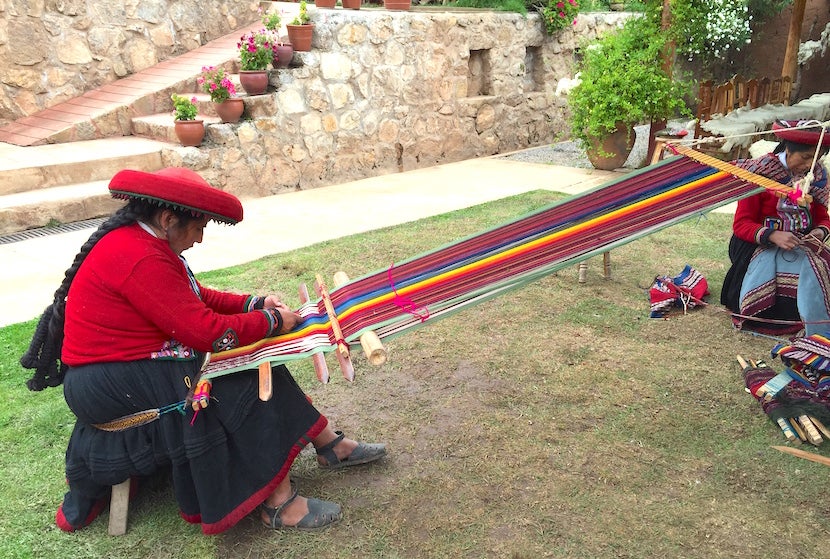
Airlines That Fly to Peru
If you're flying to Peru from the U.S., you'll almost certainly have to fly to Lima (LIM), unless you're taking an unnecessarily circuitous route. Here are the major airlines currently flying North America to Lima, either nonstop or with just one stop to the capital.
- Aerolineas Argentinas flies from New York (JFK) and Miami (MIA) to Buenos Aires (EZE), from which you can continue on to Lima.
- Aeromexico flies from various U.S. airports to its hub in Mexico City (MEX) and Lima.
- Air Canada flies to Lima from its hub in Toronto (YYZ) four times weekly and from Montreal (YUL) on Sundays and Wednesdays.
- Avianca operates flights to Lima from its hubs in Bogotá (BOG), San José (SJO) and San Salvador (SAL).
- American Airlines flies to Lima from Dallas (DFW) and Miami (MIA).
- Copa flies from the U.S. to Lima via its hub in Panama City (PTY).
- Delta operates a nonstop flight to Lima from its hub in Atlanta (ATL).
- JetBlue operates nonstop from Ft. Lauderdale (FLL) to Lima.
- LATAM flies to Lima from Los Angeles (LAX), Miami (MIA) and New York (JFK).
- Spirit also flies from Ft. Lauderdale (FLL).
- United flies from both Houston (IAH) and Newark (EWR) to Lima.
Mileage Table
First, let's look at the various miles and points you can use and the airlines to which they apply that you might be interested in flying to Lima.
Once you get to Lima, you can take cheap flights around the country on Avianca, LATAM and Peruvian Airlines.
Airline and Mileage Options
Now let's focus on the airlines with the most convenient options from the U.S. (sorry, Aerolineas Argentinas!) and discuss how to use your miles to fly them to/from Lima.
Here they are in alphabetical order.
1. Aeromexico
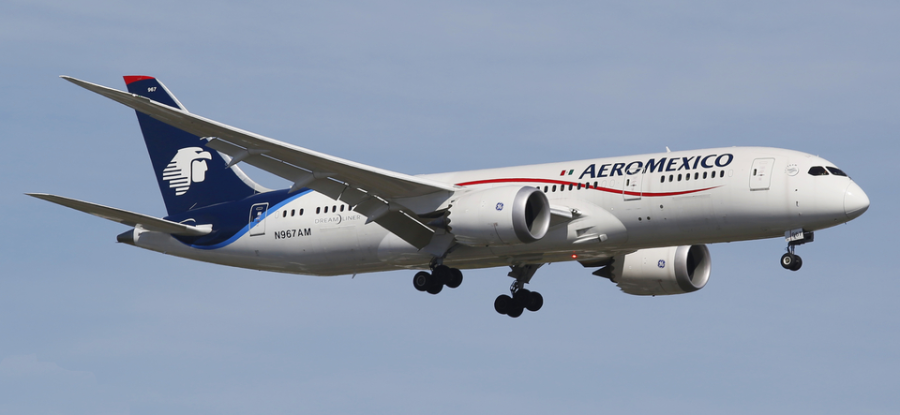
There are a few reasons to consider this SkyTeam carrier for your trip to Lima. First, it flies to several major U.S. gateways, including Boston (BOS), Chicago (ORD), Dallas (DFW), Detroit (DTW), Houston (IAH), Las Vegas (LAS), Los Angeles (LAX), Miami (MIA), New York (JFK), Orlando (MCO), San Antonio (SAT), San Francisco (SFO) and Washington Dulles (IAD).
While most of these flights are operated on old 737s with recliner-style business-class seats, one daily flight from JFK is operated by a 787 (and sometimes the LA route gets one, too) with nicer business-class seats (though not the newest ones aboard the 787-9s ).
From Mexico City (MEX), it flies three daily nonstops to Lima aboard 737s. Because of the number of U.S. gateways, your chance of finding an award is usually better than on some other airlines, and availability on the MEX-LIM leg tends to be pretty open.
Where to search: I'd suggest using Delta.com to search for SkyTeam availability since the search engine is much better about pulling in partner awards than in years past. However, I was hard-pressed to find many Aeromexico awards using the site as the engine seems to favor finding higher-level awards on Delta itself rather than on partners.
If you find individual flight segments with award availability on Aeromexico, like the one below from New York-JFK to Mexico City and an onward connection to Lima, you can call into Delta and ask an agent to book it and waive the phone booking fee.

Miles to use: Delta is your best bet here and it's a 1:1 transfer partner of American Express Membership Rewards as well as Marriott Bonvoy (and for every 20,000 points you transfer, you get a 5,000-mile bonus). The rates using Flying Blue miles could be better...theoretically. Unfortunately, Flying Blue 's phone agents seem to have little to no access to Aeromexico award space based on several phone calls I made to their mileage desk armed with individual segment awards I'd found on Delta.com.
Though Delta removed its award charts from its site back in 2015, you can expect to pay the following amounts at the lowest level:
- Economy: 88,000+ miles
- Business: 132,000+ miles
Your other option is Air France/KLM Flying Blue, a transfer partner of all four major transferable points programs. Before you get your hopes up, the program just switched over to a revenue-based model and the redemption rates are illogical , to say the least.
Whereas before you could search for awards a month at a time, you now have to do so day by day. I would instead suggest searching on Delta.com, and then trying to find matching award space once you're logged in to your Flying Blue account on the Air France or KLM sites.
The lowest business-class award I could find on Aeromexico for the next year was 50,500 miles each way.

As for economy awards, they should price out at 20,000 miles each way, but I could not find any that were solely on Aeromexico. My guess is something might be going on with award space on the airline for the moment.
2. American Airlines
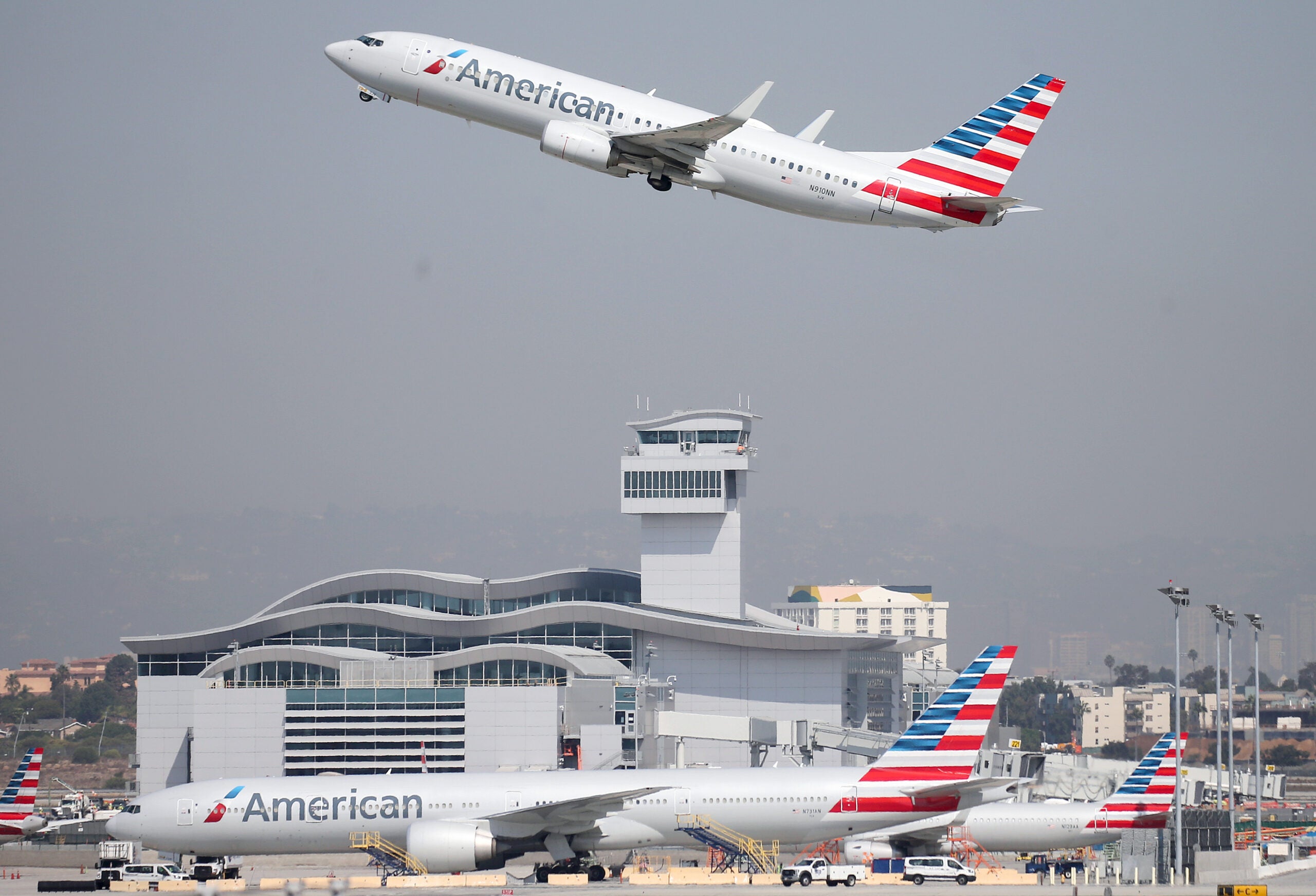
American flies two daily nonstops to Lima from its hub in Miami (MIA). One is aboard a 757 and one is aboard a 767, both with fully lie-flat seats . It also operates a daily nonstop from Dallas (DFW) using another 757.
Where to search: For awards on American itself, the airline's own site is the best place to search for award availability, though you can also use BritishAirways.com and AlaskaAir.com .
Miles to use: You have a couple of choices here, including American's own AAdvantage program, Alaska's Mileage Plan and even British Airways Avios.
American's off-peak dates for this region on are January 16 – June 14 and September 7 – November 14, and it will charge you the following amount of miles round-trip:
- Economy: 35,000 miles off-peak, 40,000 miles peak
- Business: 60,000 miles
The airline's AAdvantage program is a transfer partner of Marriott Bonvoy, as is Alaska Mileage Plan , which will charge you the following amounts round-trip:
- Economy: 40,000 miles
Now for the interesting option. American partners with British Airways. BA's award chart is distance-based , so longer flights or those with multiple segments will cost you more miles. However, American's flights from Miami to Lima will cost the following amount of Avios round-trip, which can be a real bargain.
- Economy: 25,000 Avios
- Business: 75,000 Avios
From Dallas to Lima, the amounts are:
- Economy: 40,000 Avios
- Business: 120,000 Avios
That economy award is still decent, but the business-class one less so. The only thing is that award availability on BA's site does not match up to what you will find using AA.com, so you might have to search for awards first, then call the BA mileage desk. When I did so, they were able to see the same awards I'd found on American and Alaska's sites but had to book them for me by phone.
3. Avianca and Copa
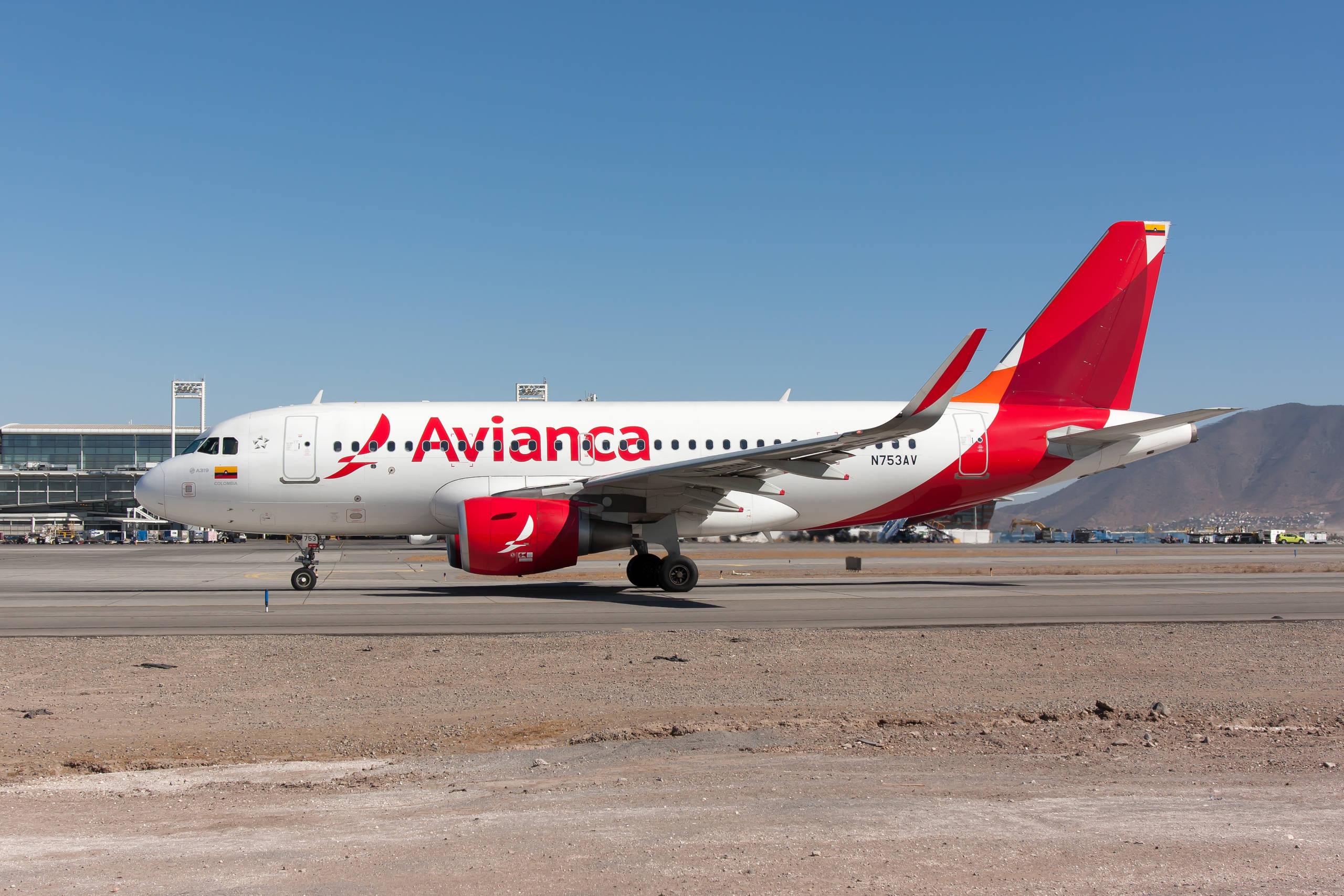
I'm grouping these two airlines together because they're both members of Star Alliance and both fly to several airports in the U.S. and on to Lima via hubs in Bogota (BOG), Panama City (PTY), San José (SJO) and San Salvador (SAL).
I wouldn't call these options great since they're all on either smaller aircraft with recliner-style seats or, in the case of Avianca, on some A330s with older, angled seats. Avianca does fly its newest aircraft, the 787, with lie-flat seats on one daily flight to Los Angeles (LAX) and it does sometimes get swapped in for the A330 on one of the airline's two daily non-stops from New York (JFK).
Where to search: For Star Alliance awards, your best search engines are likely Aeroplan's or United's .
Miles to use: Unfortunately, Aeroplan considers Peru to be part of southern South America, so the mileage redemption rates are pretty high (110,000 round-trip for business class). Instead, you should use United miles , which you can transfer from Chase Ultimate Rewards if you have a card like the Chase Sapphire Reserve.
United will charge you 44000 miles round-trip tickets from the U.S. to Peru in economy class or 77,000 miles in business. These may vary due to United's switch to dynamic pricing , which skyrocketed partner awards' price
Here's a sample award on Copa with availability in both economy and business. You can expect similar pricing with Avianca.
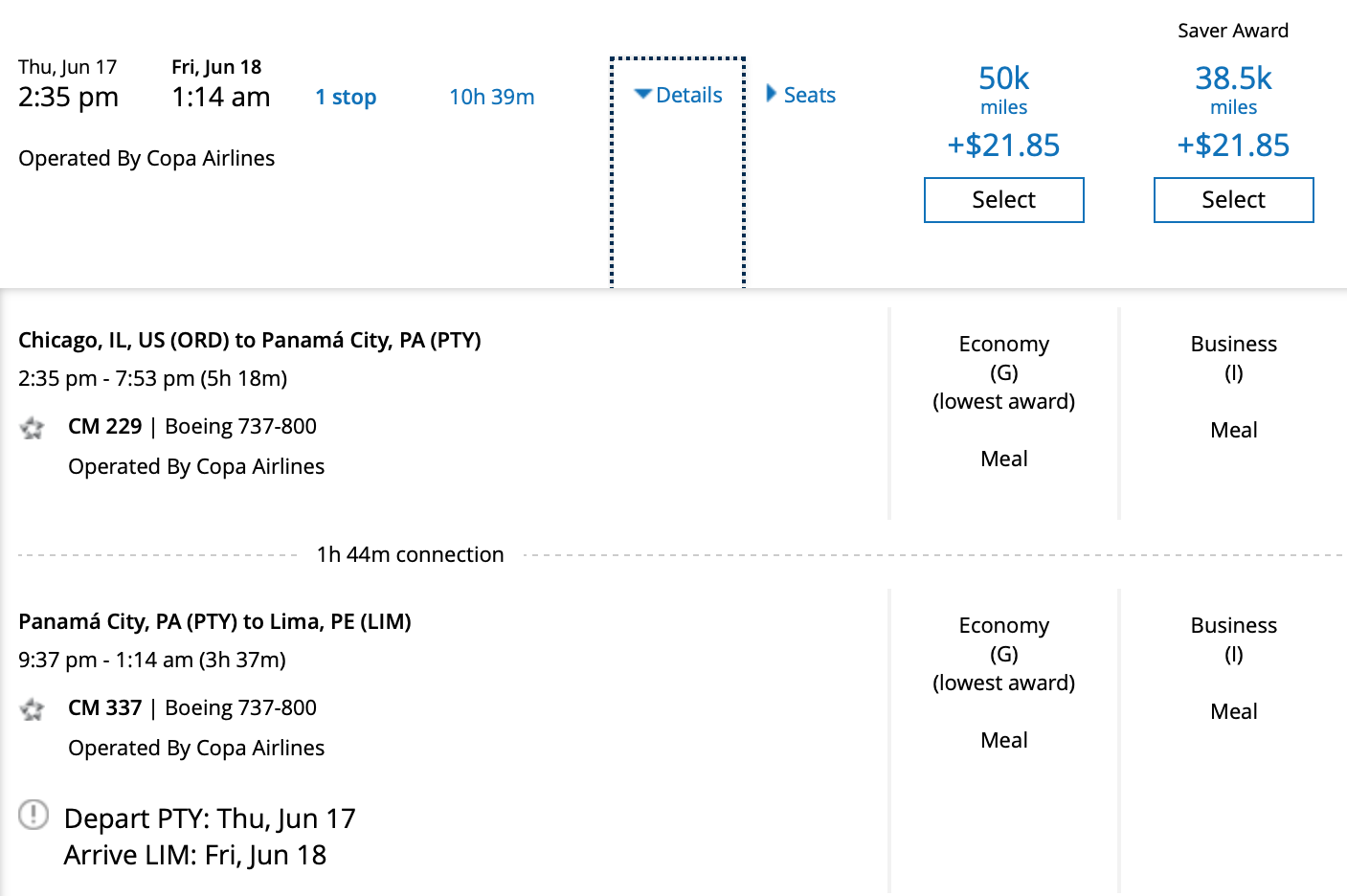
Another option that stands out here is using Avianca's own Lifemiles . You might not think of the program every day, but it's an American Express Membership Rewards , Capital One , Citi ThankYou Rewards and Marriott Bonvoy transfer partner , and often offers buy-miles bonuses that could make it worth it.
Award rates vary by route and distance, but you can look up the numbers on the Lifemiles calculator page for Avianca's own flights, or here for its award rates on its Star Alliance partners . In general, though, they range within the following numbers for flights from various U.S. hubs.
- Economy: 30,000-50,000
- Business: 60,000-80,000
For instance, this award search came up with saver-level availability on Copa from Miami (MIA) to Lima (LIM) via Panama City (PTY) for 20,000 miles one-way in economy and 35,000 in business.
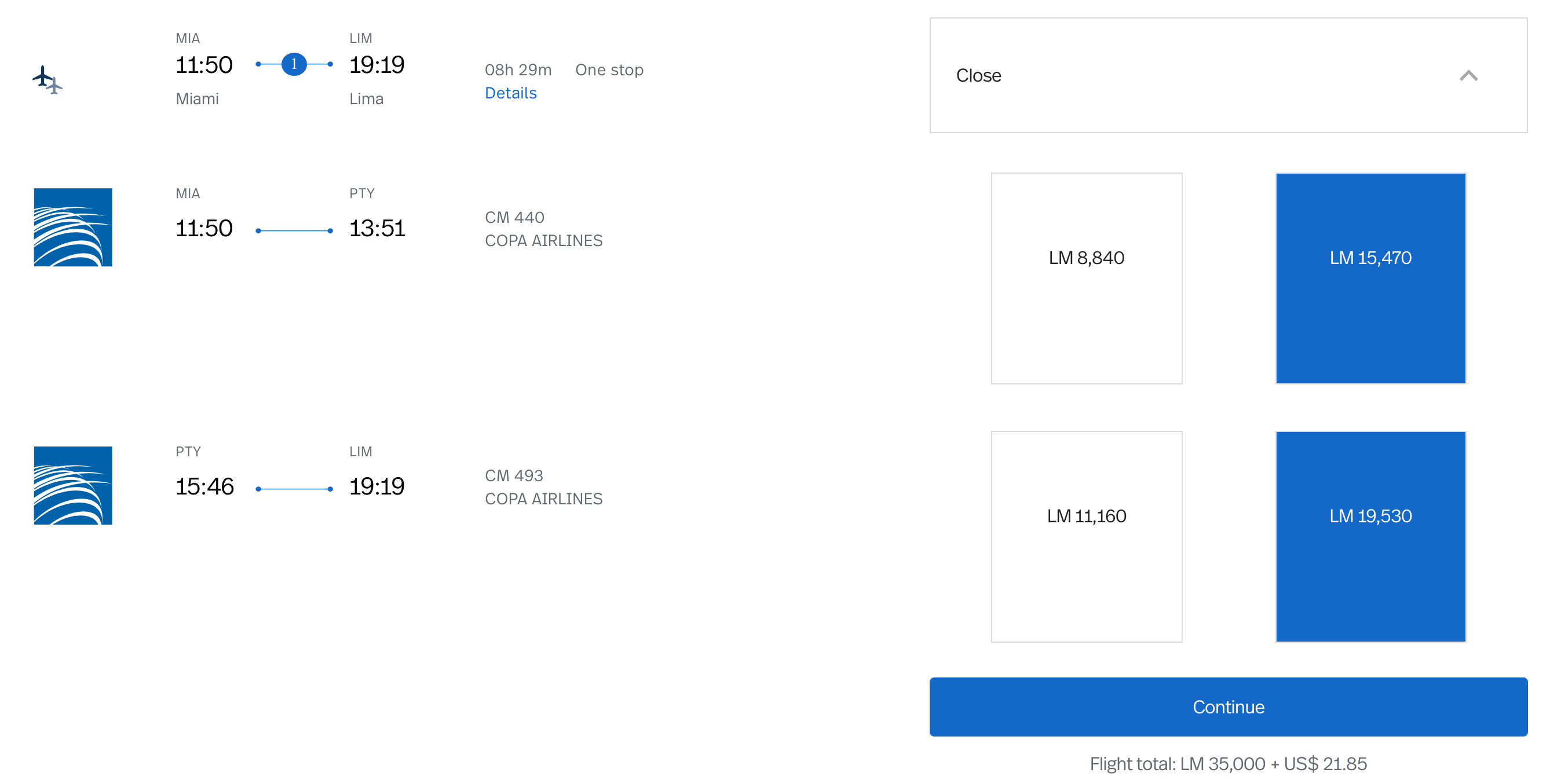
Meanwhile, you could think about using ANA miles since you can transfer both American Express Membership Rewards or Marriott Bonvoy points to the program. You'll be paying 55,000 miles round-trip in economy or 80,000 in business, so you're better off with United or Avianca.
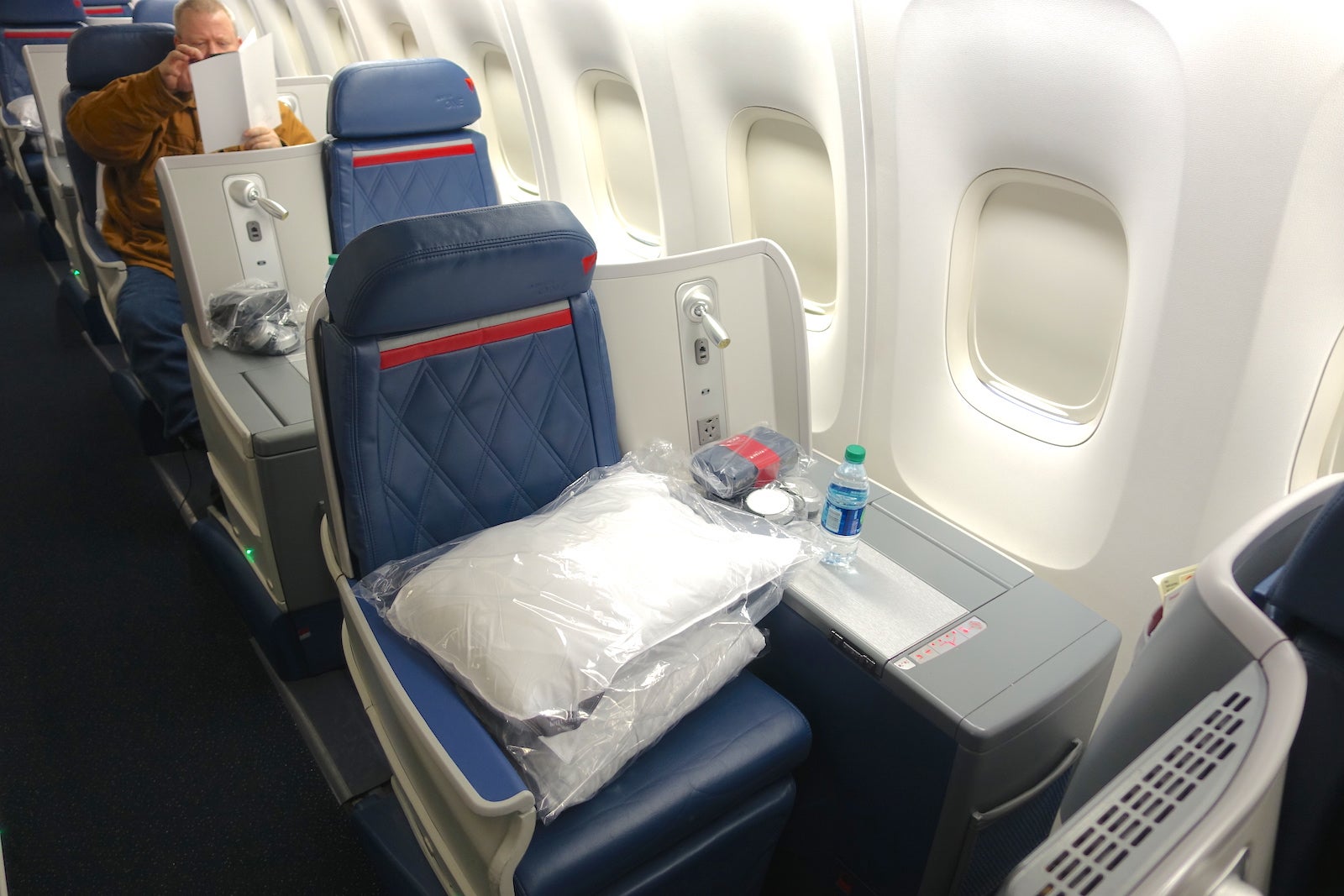
Delta operates a single daily flight to Lima from its hub in Atlanta (ATL) using a 767-400ER with just an average economy class seats and its usual Delta One lie-flats in a staggered 1 – 2 – 1 front-facing configuration. So you don't have many choices, but award availability is there, so you might want to consider it.
Where to search: Using Delta.com is probably the easiest way to find awards like this one in basic economy.
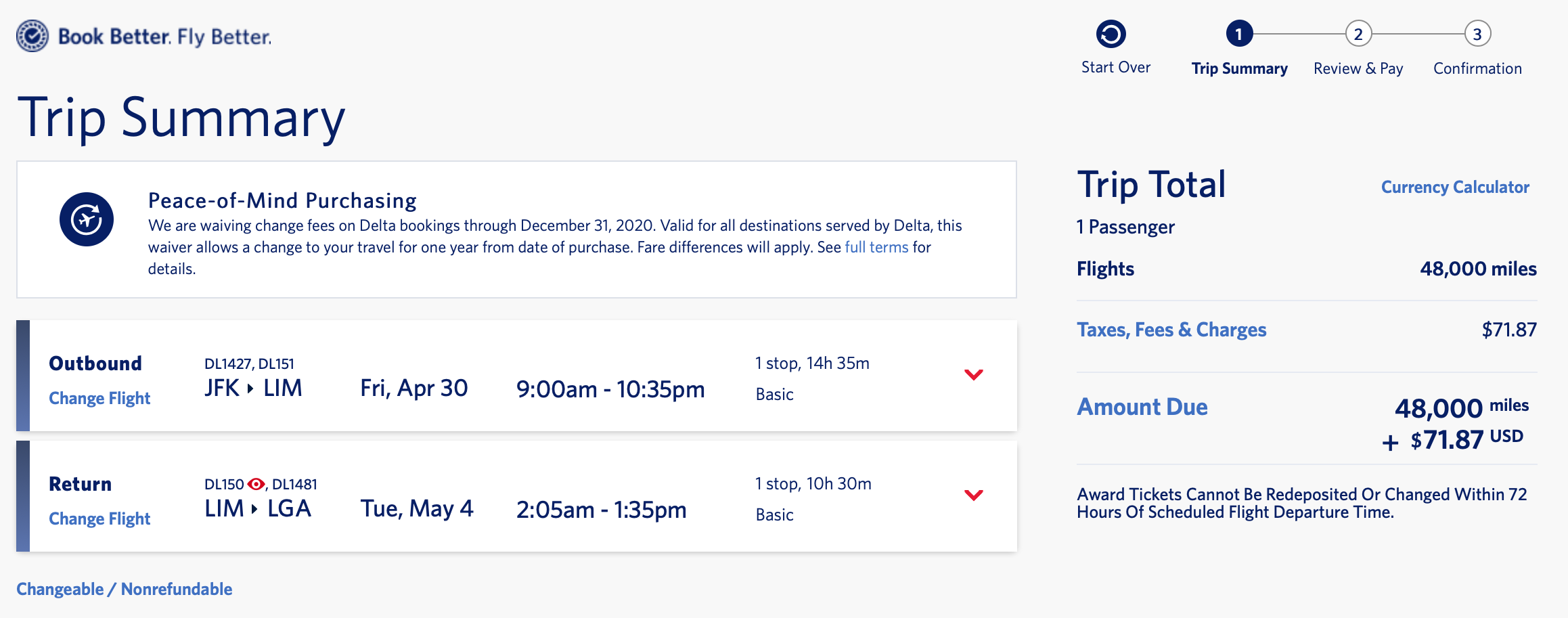
And this one in business class.
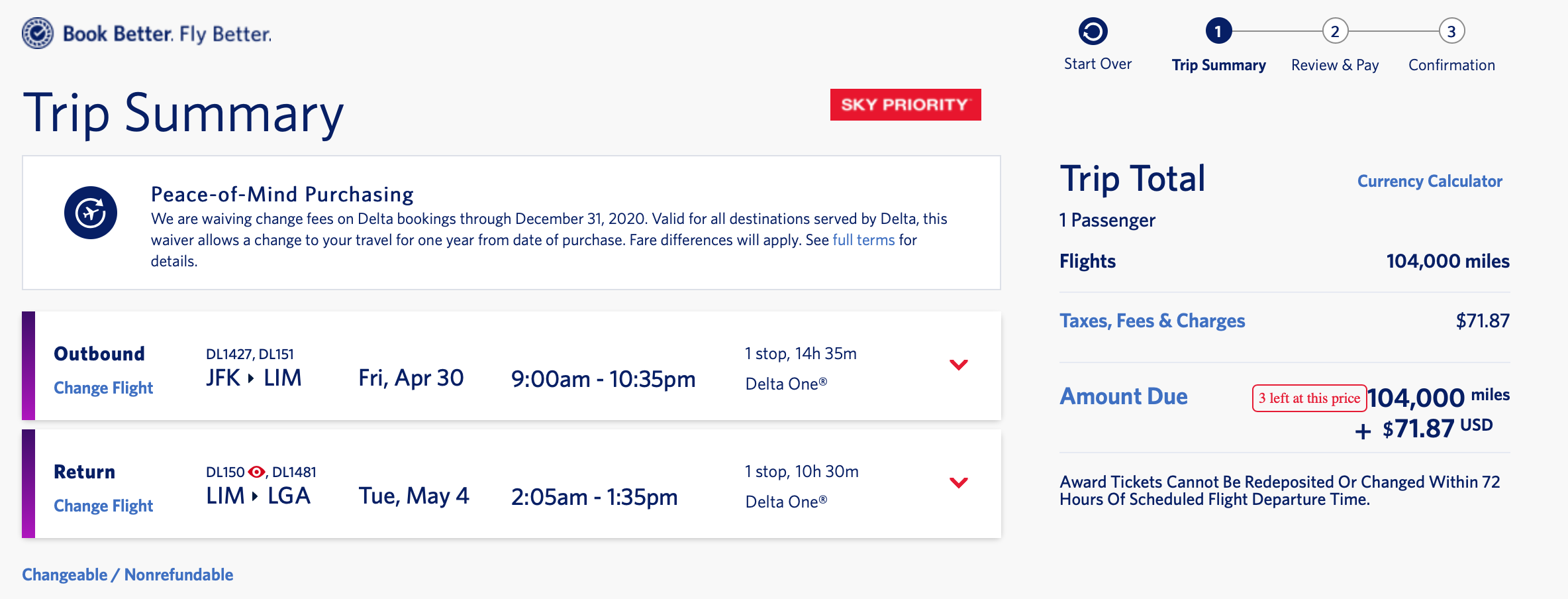
Miles to use: Delta's transfer partners include both Amex and Marriott, and you'll need the following amount of miles:
- Economy: 40,000-50,000 miles
- Business: 80,000-150,000 miles
The reason I've included ranges is that Delta's dynamic pricing makes redemption rates somewhat unpredictable. That's why you might also want to think about using Flying Blue miles at the following rates (which is what they're pricing out now, but this might change as Flying Blue's new revenue-based award redemptions work out the kinks. Here are the lowest prices we've found.
- Economy: 20,000 miles
- Business: 50,500 miles
What's more, the Flying Blue search engine seems to be pulling in more saver-level award availability on Delta flights on some days than Delta's own search engine, so you're better off booking there for the time being. Especially considering Flying Blue is a transfer partner of all four major transferable points programs: Amex, Capital One, Chase, Citi and Marriott.
Here's a sample economy award on Delta from Washington Dulles (IAD) to Lima.

And one from New York JFK to Lima via Atlanta in business.

You might be surprised to see JetBlue on this list, but the carrier has been flying its route from Ft. Lauderdale (FLL) to Lima since 2013. Unfortunately, you won't find JetBlue's Mint business class on this route, but the flight is only six hours, so you might not mind.
Where to search: JetBlue.com
Miles to use: Although TPG only values JetBlue points at 1.3 cents apiece , the great thing about using JetBlue True Blue points is that you can redeem them for any available seat on the plane, just like paying for airfare. Only you're using points instead. That means that the higher the airfare, the more points you'll need, but that last-seat availability can definitely be worth it.
Not only that, but TrueBlue became a Citi ThankYou Rewards transfer partner in 2016. If you have the Citi Prestige® Card or Citi Premier® Card, your transfer ratio is 1,000 Citi to 800 True Blue. If you have the Citi ThankYou® Preferred or Citi Rewards+® Card, that ratio is 1,000:500 instead. There are even occasional transfer bonuses .
The information for the Citi Prestige has been collected independently by The Points Guy. The card details on this page have not been reviewed or provided by the card issuer.
Airfares on the route run about $440 round-trip:

Using True Blue points, you'll be paying 24,800 points.

You're getting an average value of about 1.5 cents per point with this particular itinerary.
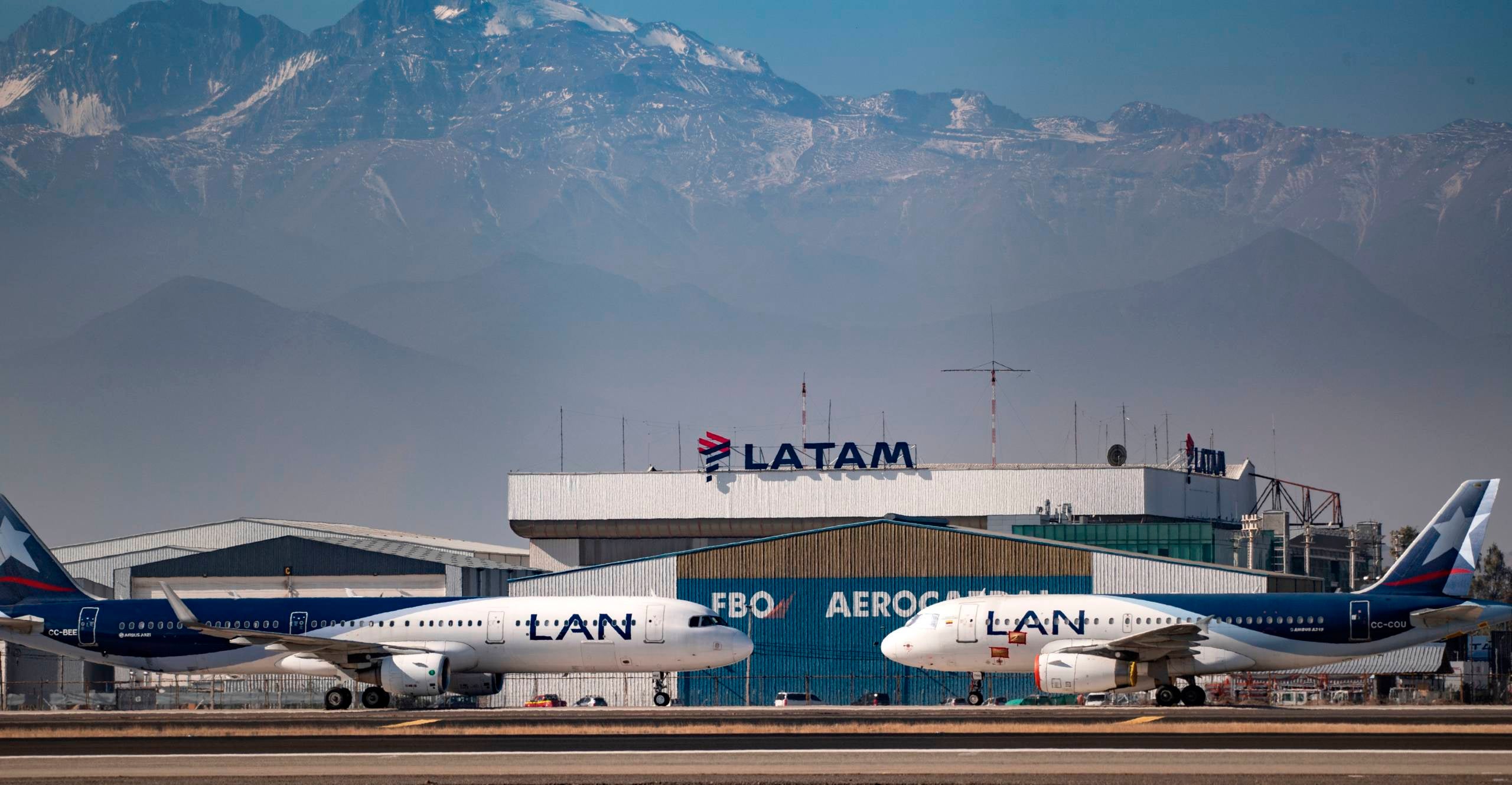
Now for the big one. LATAM currently flies nonstops from Lima (LIM) to Los Angeles (LAX), Miami (MIA), New York (JFK) and Orlando (MCO). Most flights are operated by 767s, though one of the LA daily flights is aboard a 787 and the Orlando flight uses an A320. The 767s and 787s have lie-flat beds in business class, though the 787s have newer interiors (obviously).
Where to search: You won't find LATAM award space on Alaska's or British Airways' flight, but you can search on the Qantas Frequent Flyer website . Then, you can call your partner of choice to book.
Miles to use: Your best mileage choices for LATAM awards will be Alaska Mileage Plan or British Airways, depending on where you're coming from.
British Airways award requirements will depend on the number of segments and the distance you're flying, thanks to the airline's unique award charts. As mentioned above, BA's award chart is distance-based , so longer flights or those with multiple segments will cost you more miles. However, here are the round-trip amounts for awards between Lima and Miami:
- Economy: 26,000 Avios
- Business: 77,500 Avios
Versus those from Los Angeles to Lima:
- Economy: 51,500 Avios
- Business: 154,500 Avios
As you can see, where you're flying to/from makes a huge difference. Remember, these are just the nonstop redemption levels. If you have more segments, you'll need more Avios since they'll price out as separate awards.
If you want to use Alaska miles, it'll cost the following for a round-trip ticket.
- Economy: 50,000 miles
- Business: 90,000 miles
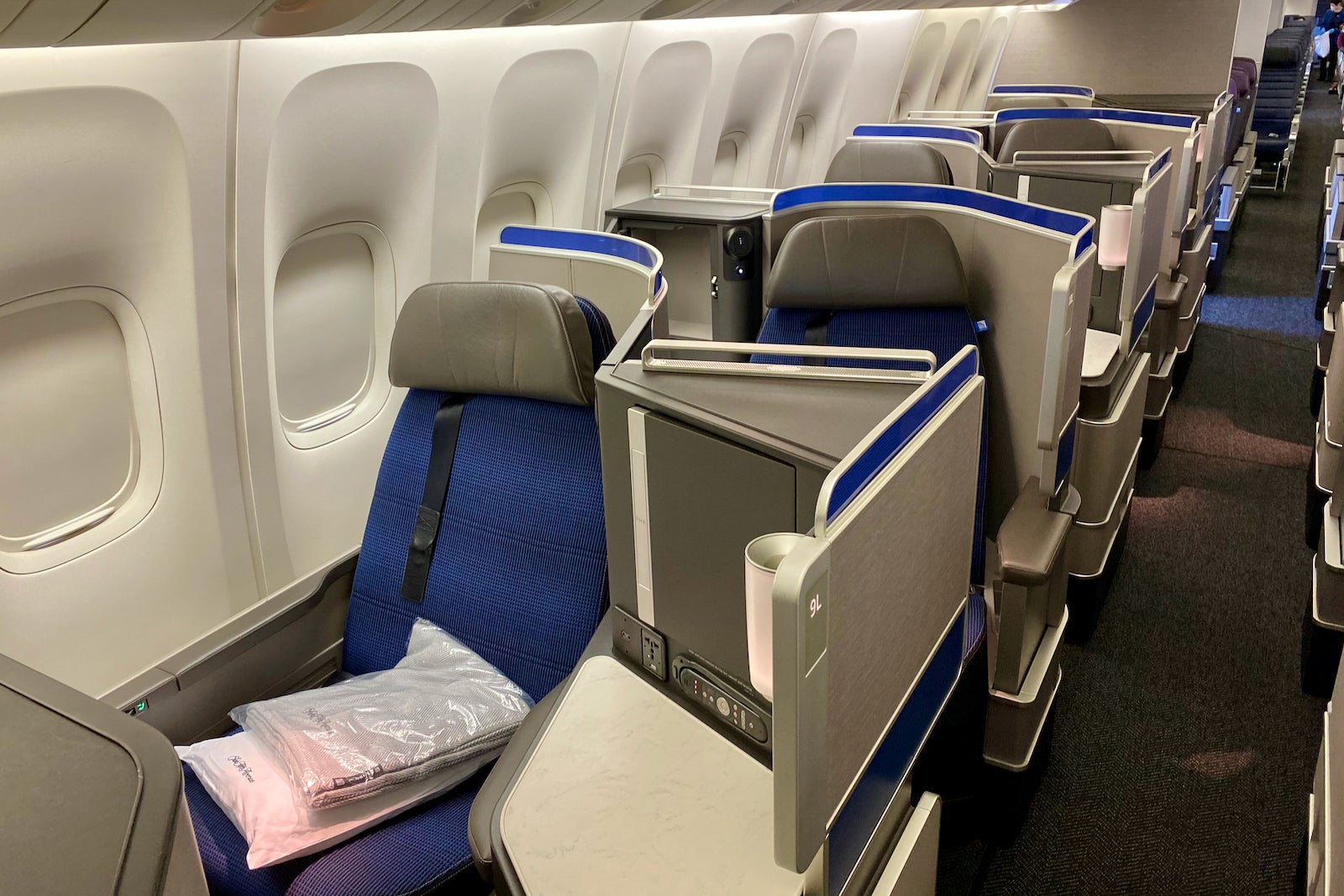
United operates a daily nonstop flight from its hub in Newark (EWR) to Lima (LIM) until mid-August, then drops down to four days a week aboard a 757 , and a daily nonstop from its other hub in Houston (IAH) aboard a 767 . Both have lie-flat business-class seats.
Where to search: You can use United.com to look for availability on its own flights.
Miles to use: As noted in the Avianca/Copa section, your best bet for Star Alliance awards to South America is likely United miles if using Chase Ultimate Rewards points.
Award availability on United's own flights is tight during normal travel times. If you find award space, they will cost the following amount of miles round-trip.
- Business: 70,000 miles
Here's a sample economy award from Houston to Lima:
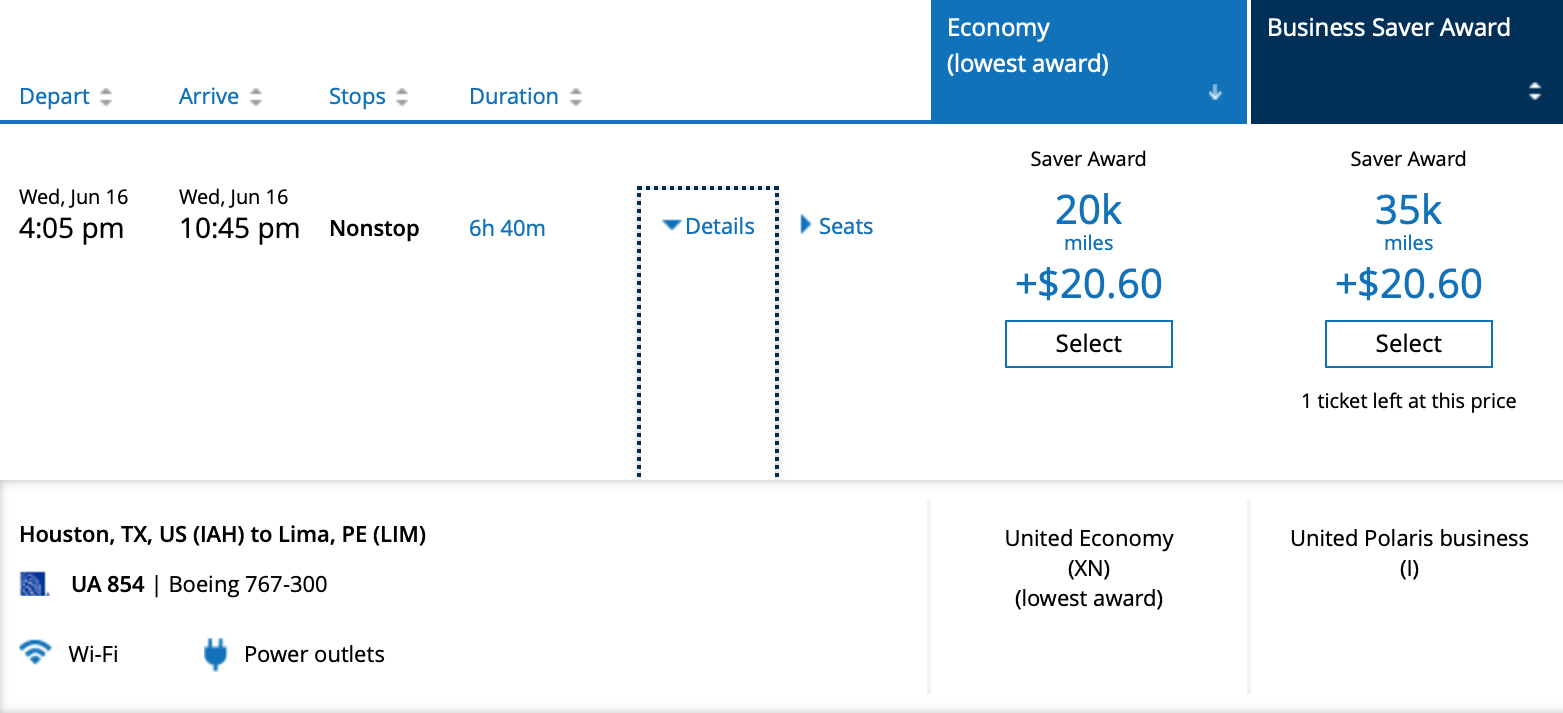
You can use Avianca LifeMiles as well for the same prices discussed in the Avianca and Copa section. Again, you can transfer points from most major transferrable points program to LifeMiles, excluding Chase.
Bottom Line
Flight options from the U.S. to Peru are a little more limited than to some other regions in the world. However, there are still plenty of great ways to get down there, both in terms of the airlines that fly to Lima, award availability and the various miles you can use.
Additional reporting by Andrew Kunesh
Feature photo by Jesse Kraft / EyeEm / Getty Images
$1499—Epic Peru adventure (flights included), save $1500

This in-depth itinerary is packed with seven activities, including a tour of Machu Picchu.
Why We Love This Deal
Peru is home to a multitude of wonders, from Machu Picchu to the floating islands on Lake Titicaca, home to an indigenous population dating back hundreds of years. This 11-night adventure takes you to these emblematic sites, plus Colca Canyon, one of the deepest in the world. Choose to go later this year or next and save $1500.
What's included:
- Roundtrip international flights from the U.S. to Lima
- 11 nights in well-reviewed hotels: Lima, Arequipa, Chivay, Puno, Cusco
- Daily breakfast and two lunches
- Guided tours of Machu Picchu and Colca Canyon Valley
- Boat excursion on Lake Titicaca to Uros and Taquile Island
- City tours of Lima and Arequipa
- Local flights and transfers
- English-speaking guide
Per-person pricing:
- $1499 … Austin; Fort Lauderdale; Miami; Washington, D.C.
- $1599 … Boston, Buffalo, Denver, Jacksonville, New York City, Orlando, Richmond, Tampa
Additional departures are available from 30+ U.S. cities.
When to go: Depart on select dates in November-December 2024 and January-March 2025. Departure dates vary by city; see partner's website for more details.
Customize your trip: For an additional cost, tr eat yourself to the healing hot springs of La Calera or visit the Rainbow Mountain of Vinicunca . You can also upgrade your hotels or add additional nights to your trip.
Additional itineraries: Other trips are also on sale, including a 7-night vacation that takes you to Lima, Cusco and Machu Picchu; and a new 12-night itinerary that includes a cruise with all meals in the Peruvian Amazon. Explore both Peru and Ecuador (including the Galápagos Islands ) with this 17-night trip .
Save on your next trip: Book by May 31 to receive a travel credit equal to 10% of the value of your reservation, up to $500.
Book by May 29.
When You Can Go
November-December 2024 and January-March 2025
$1500 vs. similar trips
More Deals & Tips
- Trending Deals
- Last-Minute Deals
How to Book
- Monday-Friday: 24 hours
- Saturday-Sunday: 8 a.m. - 9 p.m. ET
Mention Travelzoo and vacation code 16528 to get this offer.
Your location
Where are you.

Create an account.
Just one more thing..., check your inbox., create your password..
- Access to exclusive travel, entertainment, and lifestyle experiences
- Hand-picked offers, personally reviewed by our global team of deal experts, delivered to your inbox
- Dedicated club-member customer support
Sign in to your account.
Enter your password.
Please accept this confidentiality pledge:
I agree to maintain the strict confidentiality required to access Travelzoo’s confidential offers. I will not reveal details of these confidential offers publicly, which includes not posting about it on social media. I will not attempt to purchase a confidential offer for anyone else. I understand that violating these conditions can result in my access being revoked.
To view confidential offers, we require that you sign a confidentiality agreement.
Don’t know password?
You're all set, join travelzoo, sign in to unlock, don't miss out, our deal experts have negotiated member exclusive rates for people like you., and you’re in..
Welcome, Travelzoo Member . You now have access to confidential offers. To access Confidential Offers in the future, you can use the link from your email, or the link under My Account on the Travelzoo website. This page is only accessible to Confidential Offer members.
You now have access to all our deals.
Here are the details of the deal you were interested in.
Sign in to save and manage your deal alerts
Sign in to save this deal to favorites., already a member, not a member yet, save this deal to your favorites.
The best time to visit Lima

Nov 15, 2023 • 4 min read
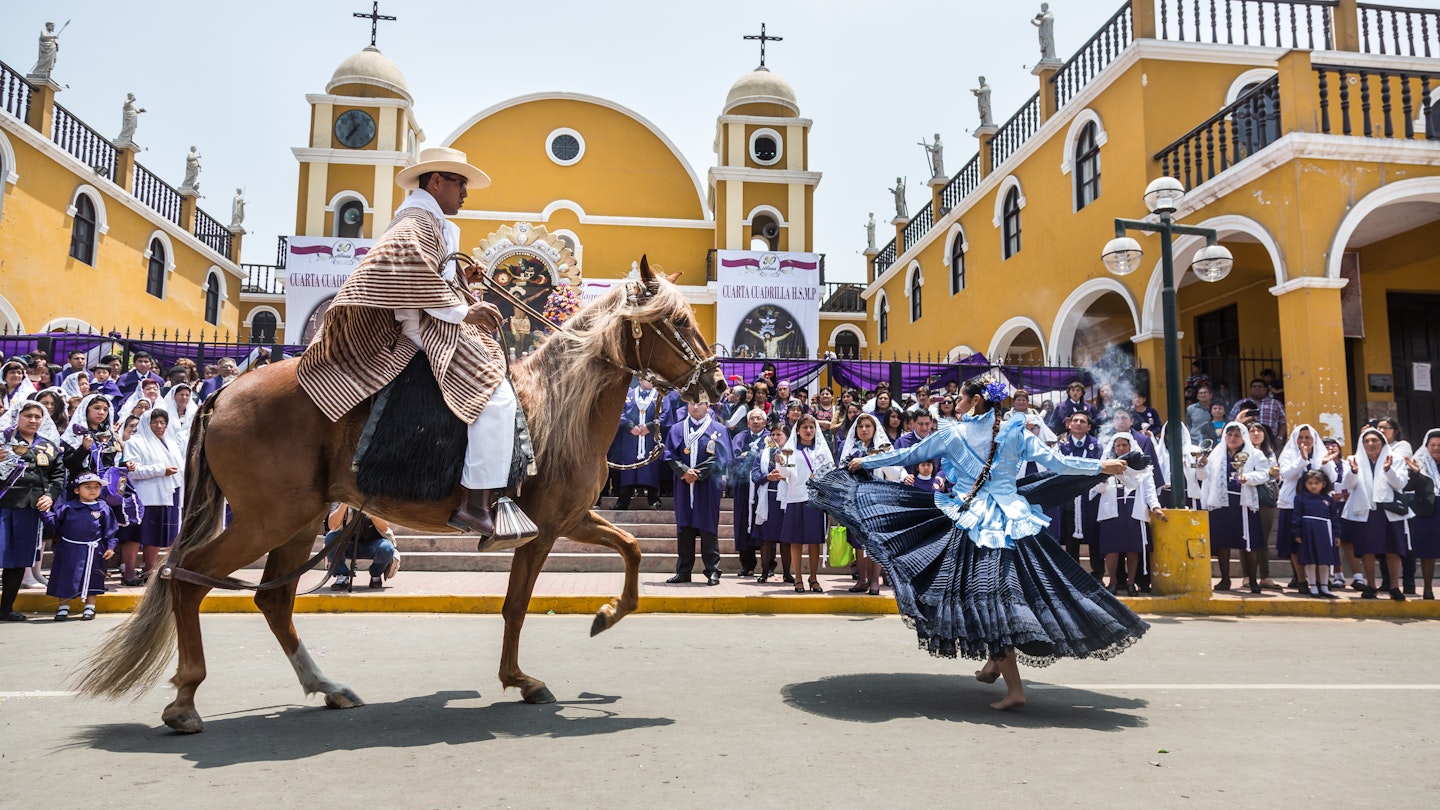
Lima has a busy festival calendar bringing color to the streets all year long © Christian Vinces / Shutterstock
Whether you're visiting Lima as a destination in its own right or here for a brief stopover before heading on to Cuzco and the Andes, there’s no bad time of year to visit.
There's usually something on the cultural calendar each month and the City of Kings serves up world-renowned restaurants, top museums, and direct access to the Pacific Ocean all year round.
However, Peru’s capital is at its best and most beautiful in the summer (December-March), when the beaches fill up by day and the bars spill out into the streets by night.
That said, Lima tends to see a greater spike in tourists during the winter (June to August) as it's the driest time to hike to Machu Picchu .
But even when fog cloaks Lima and the city skies turn gray, numerous festivals between July and October tend to liven the mood. Here's our guide to the best times to visit Lima.

The high season (June–August) is the best time for festivals and slow travel
Although Lima’s winter months see hordes of tourists, few visitors plan on spending a significant time in the capital. Instead, most pay a flying visit before heading off to explore Machu Picchu and other wonders in the Andes, as the dry winter weather is ideal for hiking in the mountains.
Nevertheless, with so many visitors in town, prices are high and you'll need to make reservations at hotels and high-end restaurants in advance.
Towards the end of June, days become shorter and the skies become more gloomy, making this a good time to visit Lima’s museums and free galleries and sample a handful of the world’s top restaurants.
The city hosts Lima Pride Week (late June to early July) around this time too. Average temperatures hovering around 20ºC (68ºF) – bike rides and strolls along the malecón (waterfront) are still an enjoyable way to keep busy.
In mid-winter, the city starts making preparations for the annual celebration of Peru’s independence on 28 and 29 July.
You will notice a tangible sense of glee among locals, so take advantage of this spirit of patriotism and chat with vendors at markets and patrons in cafes to learn more about Peru's culture and heritage. Lima stages a grand parade near Miraflores’ Parque Kennedy.

The shoulder seasons (September–November and April-May) are best for sunshine and budget travel
After the heat of January, February and March has worn off there is a lull in tourism in Lima – just before peak season ignites. Another quiet period marks the transition from the cool winter to the warm, humid summer. The beauty of visiting Lima during either of the two shoulder seasons is the chance to save money.
Reservations at top-ranked restaurants are easier to come by, prices in hotels take a slight dip and the odd burst of sunshine may just shine in your direction. In March, the fall equinox takes place in the southern hemisphere.
Semana Santa (the week leading up to Easter) is a big holiday domestically and hotel prices skyrocket.
In April, falling temperatures and cooling waters in the Pacific Ocean make April a good month to paddle board or kayak without rubbing elbows (or oars) with lots of other people. During the second shoulder season (September–November), the bulk of the hiking tourists have been, emptying central areas of Lima.
This is a good time to consider a day trip to Reserva Nacional de Paracas to see sea lions and get a welcome dose of Vitamin D.
October is a big time for religious celebrations. Catholics wear purple in tribute to a famous painting of Cristo Moreno that miraculously survived multiple earthquakes. Try and find some traditional turrón de Doña Pepa (a sprinkle-topped, anise-flavored cake). to eat. It's only served during this time of year.

The low season (January–March) is the best time for sunny weather in Lima
While the tourist crowds stay away, Lima's 10 million or so residents come to life during the summer months. From January to March, the sun shines brightly in clear skies, fooling visitors into thinking that Lima is like this all year round. Do as locals do and get active by surfing, paddle boarding, or kayaking along Lima’s coastline.
February is the hottest month of the year in Lima, and also the month of carnavales in Peru. The days of city-wide water fights in the capital are long gone (and now officially prohibited), but many bars and live music venues in Lima schedule special events, promotions, and concerts to mark the traditional festivities.
Consider exploring the beaches of the southern Lima region or taking a hiking day trip at this warm time of year.
Locas pack out cevicherias (ceviche restaurants) offering fresh seafood plates between January and March as the daytime temperature hovers around 24ºC (75°F), matched with a high humidity level that becomes almost unbearable in February.
Sunny days lead to incredible sunsets, followed by warm nights that are great for going out to discover new watering holes and live music venues with an icy brew or pisco cocktail in hand.
This is also a great time of year to look for cheap holiday rentals in Lima, as many upper-class Limeños migrate to their beach houses for the season.
This article was first published Apr 8, 2022 and updated Nov 15, 2023.
Explore related stories
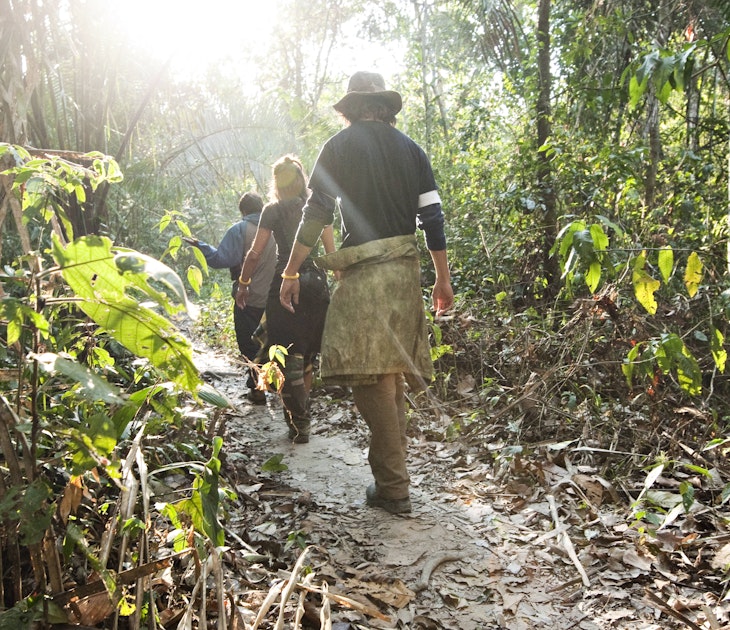
Festivals & Events
Nov 6, 2023 • 5 min read
Whether you're a foodie bound for Lima or an adventurer heading for the Inca Trail, find the perfect time for your Peru vacation here.

Jan 2, 2023 • 12 min read
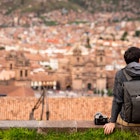
Jan 10, 2024 • 6 min read

Dec 27, 2023 • 8 min read

Dec 14, 2023 • 3 min read
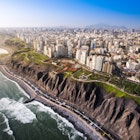
Dec 12, 2023 • 5 min read
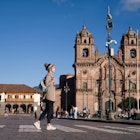
Nov 26, 2023 • 6 min read
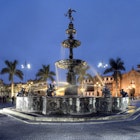
Nov 24, 2023 • 5 min read

Nov 14, 2023 • 8 min read
The Straits Times
- International
- Print Edition
- news with benefits
- SPH Rewards
- STClassifieds
- Berita Harian
- Hardwarezone
- Shin Min Daily News
- Tamil Murasu
- The Business Times
- The New Paper
- Lianhe Zaobao
- Advertise with us
Peru protesters slam new insurance law that deems transgender people as mentally ill
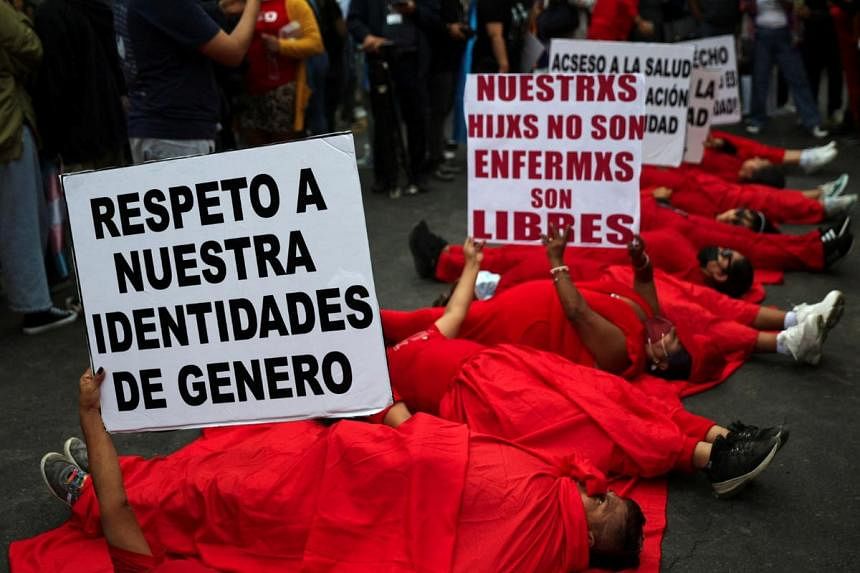
LIMA – Hundreds of protesters in Peru’s capital marched on May 17 to demand the scrapping of a new law that describes transgender people, among others, as having a mental illness so they can access health benefits.
Around 500 demonstrators peacefully walked the streets of downtown Lima, hoisting banners with slogans that read: “No more stigmas” and “My identity is not a disease”.
The law, which was approved administratively last week by the government of President Dina Boluarte, specifies that those who identify as transgender, along with “cross dressers” and “others with gender-identity disorders,” are considered to be diagnosed with “illnesses” that are eligible for mental health services via both public and private providers.
The protesters reached the health ministry offices, but no clashes were reported.
“Gender identities are no longer considered pathologies,” said activist Gahela Cari Contreras, who accused Ms Boluarte’s government of trying to trample on the LGBTQ+ community’s rights. “We’re not going to let them.”
Critics of the law have argued that its update of the country’s Peas health regulations was unnecessary, since existing rules already allowed for universal access to mental health services.
Government officials have sought to chalk up the controversy as a misunderstanding.
In a statement released shortly after the law was promulgated, the health ministry insisted that it rejects the stigmatisation of LGBTQ+ people, and that the legal language simply seeks to ensure more complete health coverage.
The ministry “categorically reaffirms respect for the dignity of the person and their free actions within the framework of human rights, providing health services for their benefit”, according to the statement.
Despite the ministry’s argument, the protesters were not persuaded and some medical experts advocated for the law to be corrected via an amendment.
“We don’t see any need to incorporate diagnoses or pathologies that no longer exist into health insurance plans,” said Mr Pedro Riega Lopez, a doctor who is dean of Peru’s CMP medical college. REUTERS
Join ST's Telegram channel and get the latest breaking news delivered to you.
- Mental health
- Gender issues
Read 3 articles and stand to win rewards
Spin the wheel now
- Election 2024
- Entertainment
- Newsletters
- Photography
- Personal Finance
- AP Investigations
- AP Buyline Personal Finance
- AP Buyline Shopping
- Press Releases
- Israel-Hamas War
- Russia-Ukraine War
- Global elections
- Asia Pacific
- Latin America
- Middle East
- Election Results
- Delegate Tracker
- AP & Elections
- Auto Racing
- 2024 Paris Olympic Games
- Movie reviews
- Book reviews
- Personal finance
- Financial Markets
- Business Highlights
- Financial wellness
- Artificial Intelligence
- Social Media
Mexico tightens travel rules on Peruvians in a show of visa diplomacy to slow migration to US
Peruvian Julia Paredes, left in white hat, listens to instructions from a Border Patrol agent with others seeking asylum as they wait to be processed after crossing the border with Mexico nearby, Thursday, April 25, 2024, in Boulevard, Calif. Mexico has begun requiring visas for Peruvians in response to a major influx of migrants from the South American country. The move follows identical ones for Venezuelans, Ecuadorians and Brazilians, effectively eliminating the option of flying to a Mexican city near the U.S. border. (AP Photo/Gregory Bull)
Julia Paredes, right, of Peru, gets a hug from volunteer Karen Parker, after crossing the border with Mexico nearby, Thursday, April 25, 2024, in Boulevard, Calif. Mexico has begun requiring visas for Peruvians in response to a major influx of migrants from the South American country. The move follows identical ones for Venezuelans, Ecuadorians and Brazilians, effectively eliminating the option of flying to a Mexican city near the U.S. border. (AP Photo/Gregory Bull)
A Border Patrol agent instructs a group of people seeking asylum, including Peruvians, as they are transported for processing after crossing the border with Mexico nearby, Thursday, April 25, 2024, in Boulevard, Calif. Mexico has begun requiring visas for Peruvians in response to a major influx of migrants from the South American country. The move follows identical ones for Venezuelans, Ecuadorians and Brazilians, effectively eliminating the option of flying to a Mexican city near the U.S. border. (AP Photo/Gregory Bull)
People seeking asylum walk through a field of wildflowers as they wait to be processed after crossing the border with Mexico nearby, Thursday, April 25, 2024, in Boulevard, Calif. Mexico has begun requiring visas for Peruvians in response to a major influx of migrants from the South American country. The move follows identical ones for Venezuelans, Ecuadorians and Brazilians, effectively eliminating the option of flying to a Mexican city near the U.S. border. (AP Photo/Gregory Bull)
Peruvian Julia Paredes, center in white hat, listens to instructions from a Border Patrol agent with others seeking asylum as they wait to be processed after crossing the border with Mexico nearby, Thursday, April 25, 2024, in Boulevard, Calif. Mexico has begun requiring visas for Peruvians in response to a major influx of migrants from the South American country. The move follows identical ones for Venezuelans, Ecuadorians and Brazilians, effectively eliminating the option of flying to a Mexican city near the U.S. border. (AP Photo/Gregory Bull)
Men seeking asylum, including Peruvians, line up as they wait to be processed after crossing the border with Mexico nearby, Thursday, April 25, 2024, in Boulevard, Calif. Mexico has begun requiring visas for Peruvians in response to a major influx of migrants from the South American country. The move follows identical ones for Venezuelans, Ecuadorians and Brazilians, effectively eliminating the option of flying to a Mexican city near the U.S. border. (AP Photo/Gregory Bull)
People seeking asylum keep warm near a fire as they wait to be processed, after crossing the border with Mexico nearby, Thursday, April 25, 2024, in Boulevard, Calif. Mexico has begun requiring visas for Peruvians in response to a major influx of migrants from the South American country. The move follows identical ones for Venezuelans, Ecuadorians and Brazilians, effectively eliminating the option of flying to a Mexican city near the U.S. border. (AP Photo/Gregory Bull)
People seeking asylum, including a group from Peru, walk behind a Border Patrol agent towards a van to be processed after crossing the border with Mexico nearby, Thursday, April 25, 2024, in Boulevard, Calif. Mexico has begun requiring visas for Peruvians in response to a major influx of migrants from the South American country. The move follows identical ones for Venezuelans, Ecuadorians and Brazilians, effectively eliminating the option of flying to a Mexican city near the U.S. border. (AP Photo/Gregory Bull)
- Copy Link copied
BOULEVARD, Calif. (AP) — Julia Paredes believed her move to the United States might be now or never. Mexico was days from requiring visas for Peruvian visitors. If she didn’t act quickly, she would have to make a far more perilous, surreptitious journey over land to settle with her sister in Dallas.
Mexico began requiring visas for Peruvians on Monday in response to a major influx of migrants from the South American country, after identical moves for Venezuelans, Ecuadorians and Brazilians. It effectively eliminated the option of flying to a Mexican city near the U.S. border, as Paredes, 45, did just before it was too late.
“I had to treat it as a emergency,” said Paredes, who worked serving lunch to miners in Arequipa, Peru, and borrowed money to fly to Mexico’s Tijuana, across from San Diego. Last month smugglers guided her through a remote opening in the border wall to a dirt lot in California, where she and about 100 migrants from around the world shivered over campfires after a morning drizzle and waited for overwhelmed Border Patrol agents to drive them to a station for processing.
Senior U.S. officials, speaking to reporters ahead of a meeting of top diplomats from about 20 countries in the Western hemisphere this week in Guatemala, applauded Mexico’s crackdown on air travel from Peru and called visa requirements an important tool to jointly confront illegal migration.
For critics, shutting down air travel only encourages more dangerous choices. Illegal migration by Venezuelans plummeted after Mexico imposed visa requirements in January 2022, but the lull was short-lived. Last year Venezuelans made up nearly two-thirds of the record-high 520,000 migrants who walked through the Darien Gap, the notorious jungle spanning parts of Panama and Colombia.
More than 25,000 Chinese traversed the Darien last year. They generally fly to Ecuador, a country known for few travel restrictions, and cross the U.S. border illegally in San Diego to seek asylum. With an immigration court backlog topping 3 million cases, it takes years to decide such claims, during which time people can obtain work permits and establish roots.
“People are going to come no matter what,” said Miguel Yaranga, 22, who flew from Lima, Peru’s capital, to Tijuana and was released by the Border Patrol Sunday at a San Diego bus stop. He had orders to appear in immigration court in New York in February 2025, which puzzled him because he said he told agents he would settle with his sister on the other side of the country, in Bakersfield, California.
Jeremy MacGillivray, deputy chief of the Mexico mission of the U.N.'s International Organization for Migration, predicts that Peruvian migration will drop “at least at the beginning” and bounce back as people shift to walking through the Darien Gap and to Central America and Mexico.
Mexico said last month that it would require visas for Peruvians for the first time since 2012 in response to a “substantial increase” in illegal migration. Large-scale Peruvian migration to Mexico began in 2022; Peruvians were stopped in the country an average of 2,160 times a month from January to March of this year, up from a monthly average of 544 times for all of 2023.
Peruvians also began showing up at the U.S. border in 2022. The U.S. Border Patrol arrested Peruvians an average of about 5,300 times a month last year before falling to a monthly average of 3,400 from January through March, amid a broad immigration crackdown by Mexico .
Peru immediately reciprocated Mexico’s visa requirement but changed course after a backlash from the country’s tourism industry. Peru noted in its reversal that it is part of a regional economic bloc that includes Mexico, Chile and Colombia.
Adam Isacson, an analyst at the Washington Office on Latin America, said Peru’s membership with Mexico in the Pacific Alliance allowed its citizens visa-free travel longer than other countries.
It is unclear if Colombia, also a major source of migration , will be next, but Isacson said Mexican President Andrés Manuel López Obrador is in a “lovefest” with his Colombian counterpart, Gustavo Petro, while his relations with Peru’s government are more strained.
Colombians are consistently near the top nationalities of migrants arriving at Tijuana’s airport. Many find hotels before a guide takes them to boulder-strewn mountains east of the city, where they cross through openings in the border wall and then walk toward dirt lots that the Border Patrol has identified as waiting stations.
Bryan Ramírez, 25, of Colombia, reached U.S. soil with his girlfriend last month, only two days after leaving Bogota for Cancun, Mexico, and continuing on another flight to Tijuana. He waited alongside others overnight for Border Patrol agents to pick him up as cold rain and high winds whipped over the crackle of high-voltage power lines.
The group waiting near Boulevard, a small, loosely defined rural town, included several Peruvians who said they came for economic opportunity and to escape violence and political crises.
Peruvians can still avoid the Darien jungle by flying to El Salvador, which introduced visa-free travel for them in December in reciprocation for a similar move by Peru’s government. But they would still have to travel over land through Mexico, where many are robbed or kidnapped.
Ecuadoreans, who have needed visas to enter Mexico since September 2021, can also fly to El Salvador, but not all do. Oscar Palacios, 42, said he walked through Darien because he couldn’t afford to fly.
Palacios, who left his wife and year-old child in Ecuador with plans to support them financially from the U.S., said it took him two weeks to travel from his home near the violent city of Esmeralda to Mexico’s border with Guatemala. It then took him two months to cross Mexico because immigration authorities turned him around three times and bused him back to the southern part of the country. He said he was robbed repeatedly.
Palacios finally reached Tijuana and, after three nights in a hotel, crossed into the U.S. A Border Patrol agent spotted him with migrants from Turkey and Brazil and drove them to the dirt lot to wait for a van or bus to take them to a station for processing. Looking back on the journey, Palacios said he would rather cross Darien Gap 100 times than Mexico even once.
Associated Press writer Christopher Sherman in Mexico City contributed.
California State University, Sacramento
Based on real user feedback and statistics, csus.edu no longer supports Microsoft’s Internet Explorer browser. Please upgrade your browser to improve your experience.
Skip to Main Content
Story Content
President’s medal 2024 – sofía del pilar roca castro aims to use her degree to support music programs back home in peru.

By Jonathan Morales
May 13, 2024
Sofía del Pilar Roca Castro was in high school when she began volunteering with a Peruvian government program that brought music education to schools in remote areas that barely had any roads.
The experience changed her life.
“I just remember arriving and all the kids being so excited to see our instruments,” Roca Castro said. “Excitement in their eyes to see that this could be them. They could do music like we were doing it.”
In those moments, she realized the impact music education could have and knew she wanted to dedicate her life to bringing the joy and transformative power of music to those who needed it the most.
Nearly a decade later, Roca Castro is well on her way to achieving her goal. The Sacramento State Music Education major is graduating this month as the recipient of the President’s Medal, awarded each year at Commencement to the University’s top graduate.
In addition, Roca Castro received the Dean’s Award for the College of Arts and Letters. Deans’ Awards are given to one student from each of Sac State’s seven academic colleges, with one selected to receive the President’s Medal.
“In the College of Arts and Letters, our priority is ‘graduation with purpose’ – defined not only by the career path our students take but by finding ways in which to live fulfilling lives,” Arts and Letters Dean Sheree Meyer wrote in her letter nominating Roca Castro for the President’s Medal. “It is evident that Sofía Roca Castro will graduate with purpose.”
Born in Lima, Peru, Roca Castro found music at an early age, playing the saxophone in school ensembles and eventually became an assistant band director. In 2015, she began volunteering with Orquestando, the program that brought music education and resources to troubled communities.
She also endured many personal challenges, including when the small fishing town where she grew up was heavily damaged by floods and when several close family members faced health challenges.
Despite her grief, Roca Castro didn’t give up on her dream of going to college. She looked abroad because, she said, higher education in Peru lacks resources, among other challenges. She also wanted to broaden her experience and chose Sacramento State because of its strong music program and affordability.
“The band culture here and how much music is involved in the schools is really impressive to me, and it’s something I want to learn to implement later, at home." -- Sofía del Pilar Roca Castro
She began at Sac State in the fall of 2020, but it would be another year before she was on campus. COVID-19 pandemic restrictions determined that she would start her time as a Hornet taking classes on Zoom. She began in-person classes in fall 2021 and switched her concentration from saxophone to voice.
Roca Castro’s involvement outside the classroom has been just as impressive as her academic achievements. She participated in choral and opera ensembles and the marching band, and worked as a teaching assistant, customer service representative in the Welcome Center, resident advisor and campus tour guide.
“I really wanted to work on my social skills and language skills,” she said. “The jobs that I’ve taken have been challenging, and that’s why I took them, because I wanted that challenge in order to improve myself.”
Roca Castro’s family will travel from Peru to Sacramento to see her receive her degree and accept the President’s Medal at the College of Arts and Letters Commencement ceremony on May 17. After that, she plans to earn her teaching credential before getting as much experience in the U.S. as she can before returning to Peru to share what she has learned with music educators there.
“The band culture here and how much music is involved in the schools is really impressive to me, and it’s something I want to learn to implement later, at home,” she said.
In true teacher fashion, she says her favorite memories from her time at Sac State are from being in the audience for her friends’ recitals.
“I really enjoy seeing people grow and seeing their hard work and how much of themselves they’ve poured into their craft,” Roca Castro said, starting to choke up a bit. “Being able to be part of their journey has been very special.”
Share This Story
Related Topics:
- University Honors
About Jonathan Morales
Jonathan Morales joined the Sac State communications team in 2017 as a writer and editor. He previously worked at San Francisco State University and as a newspaper reporter and editor. He enjoys local beer, Bay Area sports teams, and spending time outdoors with his family and dog.
Editor's Pick

Sacramento State to recognize seven exceptional students as the University’s top graduates at Commencement

Honorary degrees, President’s medals recognize five outstanding individuals for excellence

For six siblings who earned degrees at Sacramento State, the University is home
Media resources.
- Media Resource Page
- Administration
- Public Records Requests
- Policy for Recording Film/Sound On Campus
Faculty/Staff Resources
- Briefing Submissions
- University Marketing
- Brand Center
- Editorial Style Guide
Looking for a Faculty Expert?
Contact University Communications (916) 217-8366 [email protected]
Keep up with Sacramento State!
Get the Sac State story right in your inbox by subscribing to our newsletter, The Sacramento State Leader

COMMENTS
Getting to and from the airport is best done via a ride-hailing app, shuttle, or with a private taxi service arranged by your hotel. Depending on traffic, the airport is about 40 to 60 minutes from the most touristy districts in Lima. Keep in mind that rush hour is generally from 7:30 a.m. to 10 a.m. and 5 p.m. to 8 p.m.
4. Consider distance and traffic when organizing your day-to-day itinerary. Sprawling across more than 1000 sq miles, Lima is the largest city in Peru and one of the five most populous cities in South America. While many of the most touristed districts are close neighbors, some of the best things to do and see in Lima are on opposite sides of ...
If you decide to travel to Peru: Be aware of your surroundings. Monitor local media for breaking events and adjust your plans as needed. Enroll in the Smart Traveler Enrollment Program ... Surco, Lima 33 Peru. Telephone + (51) (1) 618-2000. Emergency + (51) (1) 618-2000. Fax + (51) (1) 618-2724. Email. [email protected]. Website.
Budget Travel. Love Lima for less: how to stretch your budget in the Peruvian capital. Dec 12, 2023 • 5 min read. Head to the market. Work out by the seafront. Take the bus. ... A foodie's guide to the flavors of Lima, Peru. Nov 15, 2022 • 5 min read. Read more articles. in partnership with getyourguide. Book popular activities in Lima.
Surco, Lima 33 Peru Telephone: + (51)(1) 618-2000 Emergency After-Hours Telephone: + (51)(1) 618-2000 Fax: + (51) (1) 618-2724 Email: [email protected]. Consulates. ... at the Embassy and obtain a replacement entry record from Migraciones using your police report prior to exiting Peru. Travel with Minors: Regardless of nationality, all children ...
Best Time to Visit. It is best to visit Lima during its summer season, between December and April. Lima in the summer is sunny, and with temperatures in the 70s and 80s (roughly 21°C to 30°C), you can visit the parks, beaches, and historic districts with ease - and fully enjoy a refreshing, citrusy ceviche lunch.
Lima is the gastronomic capital, not only of Peru but also of South America (and, why not say it, of the whole world, soon). Anyone who arrives in Lima is enchanted by the varied, delicious, and prestigious food served at its table; with ancient recipes, dishes fused with other cultures, and a truly unique flavor.. However, pampering your palate is not the only thing you will get on the ...
Here are some of the top things to know before traveling to Peru . 1. Peru's only international airport is in Lima. Until the Chinchero Airport (a 45-minute drive from Cuzco) is finished, all international air passengers to Peru will first touch land in the metropolitan area of Lima, via the Jorge Chávez International Airport.
Please be advised that the Department of State has changed the Travel Advisory level for Peru from "Level 3, Reconsider Travel," to "Level 2, Exercise Increased Caution" due to crime and civil unrest. ... U.S. Embassy Lima, Peru Avenida La Encalada cdra. 17 s/n Santiago de Surco 15023, Lima +51-1-618-2000 [email protected] https: ...
Contact. Comisión de Promoción del Perú para la Exportación y el Turismo PROMPERÚ . Calle 1 Oeste N° 050. San Isidro, Lima - Perú (511) 616 7300
Your passport must be valid for at least 6 months beyond the date you expect to leave Peru. Passport for official travel. Different entry rules may apply. Official travel. ... Lima 15074, Peru Postal Address P.O. Box 18-1126, Miraflores Post Office, Lima, 15074, Peru Telephone 51 (1) ...
The climate in Lima is generally humid and dry, so pack clothes made from natural fabrics, such as cotton and linen, and don't forget to bring along layers for breezy nights. The Peruvian sol (PEN ...
Covid entry requirements for Peru until October 31, 2022. For international passengers on commercial flights and travelers crossing into Peru at a land border, Peru requires the following (October 12, 2022): Peruvians and foreign residents 12 years and older must present a vaccination certificate proving they had 3 doses of a vaccine against ...
Visit the U.S. Department of State Bureau of Consular Affairs Alerts and Warnings page for updates about current worldwide caution, travel warnings and travel alerts. You can also stay in touch and get Embassy updates by checking the Embassy Lima website or the Lima ACS Facebook page. Up-to-date information on security can also be obtained by ...
This bus is a hop-on/hop-off service you can take around the country. Three-day journeys from Lima to Cusco start from 683 PEN, while 7 days in Southern Peru costs 836 PEN. Flying - Peru has five international airports (Lima, Arequipa, Cusco, Iquitos, and Piura), as well over a dozen airports with domestic service. LATAM, Avianca, and Star ...
To call for emergency services while in Peru, dial 116 for the fire department and 105 for the police. Write these numbers down to carry with you during your trip. Learn as much as you can about Peru before you travel there. A good place to start is the country-specific information on Peru from the US Department of State. Hide
Call (+511) 200 1000. Visas and entry procedure. If you wish to stay longer for other reasons, such as business, studying or working, you need to request the relevant visa at a Peruvian consulate or embassy in your own country. Consulates and embassies. Directory of Peruvian.
Your travel insurance could be invalidated if you travel against advice from the Foreign, Commonwealth & Development Office (FCDO). Within 20km south of the Peru-Colombia border
☀️ Check out our new packing cubes on Amazon!!! ☀️ https://www.amazon.com/dp/B0BJ397JZ4😊 Hey there description box reader! If you feel so inclined, please c...
Find out the best times to travel to Lima based on our flight data from the last year. Discover the cheapest month and even day to fly. ... As Jorge Chavez International Airport (LIM) is the main passenger hub serving Lima, Peru, chances are your flight to Lima will land there. The airport is located in Callao, a small town only 7 miles from ...
This Peru itinerary focuses mainly on the capital Lima, the desert oasis of Huacachina, Machu Picchu and Cusco. Summary of this Peru Itinerary: Days 1-2: Lima. Days 3-4: Paracas & Huacachina. Days 5-6: Sacred Valley. Days 7-8: Machu Picchu. Day 9: Cusco. Day 10: Fly home! Download my Peru itinerary on Google Maps.
Book cheap flights to Lima (LIM) with United Airlines. Enjoy all the in-flight perks on your Lima flight, including speed Wi-Fi. ... Flights to Peru; Flights to Lima; ... Input arrival airport. flight_land. Input your budget $ Select Cabin Class. Select travel class. keyboard_arrow_down. New York/Newark (EWR) to. Lima (LIM) 05/22/24 - 06/12/24 ...
7. United. Fly United from Newark and Houston to Lima. (Photo by Zach Griff/The Points Guy) United operates a daily nonstop flight from its hub in Newark (EWR) to Lima (LIM) until mid-August, then drops down to four days a week aboard a 757, and a daily nonstop from its other hub in Houston (IAH) aboard a 767.
This 11-night adventure takes you to these emblematic sites, plus Colca Canyon, one of the deepest in the world. Choose to go later this year or next and save $1500. What's included: Roundtrip international flights from the U.S. to Lima. 11 nights in well-reviewed hotels: Lima, Arequipa, Chivay, Puno, Cusco.
The low season (January-March) is the best time for sunny weather in Lima. While the tourist crowds stay away, Lima's 10 million or so residents come to life during the summer months. From January to March, the sun shines brightly in clear skies, fooling visitors into thinking that Lima is like this all year round.
03:55. More than 100 killed by widespread floods in Brazil. 02:17. Authorities allege a 33-year-old truck driver in Lima, Peru smashed multiple police cars after trying to steal a trailer.
LIMA - Hundreds of protesters in Peru's capital marched on Friday to demand the scrapping of a new law that describes transgender people, among others, as having a mental illness so they can ...
Julia Paredes, right, of Peru, gets a hug from volunteer Karen Parker, after crossing the border with Mexico nearby, Thursday, April 25, 2024, in Boulevard, Calif. Mexico has begun requiring visas for Peruvians in response to a major influx of migrants from the South American country. ... who flew from Lima, Peru's capital, to Tijuana and was ...
For Assistance: U.S. Embassy Lima, Peru Avenida La Encalada cdra. 17 s/n Santiago de Surco 15023, Lima +51-1-618-2000 [email protected] https://pe.usembassy.gov; U.S. Consular Agency Cusco Avenida El Sol 449 Cusco [email protected]; State Department - Consular Affairs +1-888-407-4747 or +1-202-501-4444; Peru Country Information; To receive alerts, enroll in the Smart Traveler Enrollment ...
Born in Lima, Peru, Roca Castro found music at an early age, playing the saxophone in school ensembles and eventually became an assistant band director. In 2015, she began volunteering with Orquestando, the program that brought music education and resources to troubled communities. ... Roca Castro's family will travel from Peru to Sacramento ...